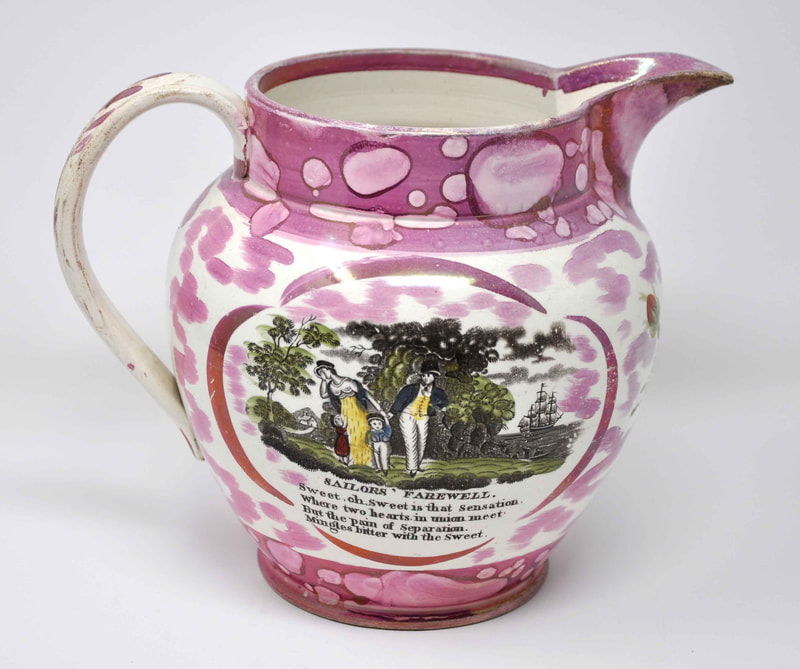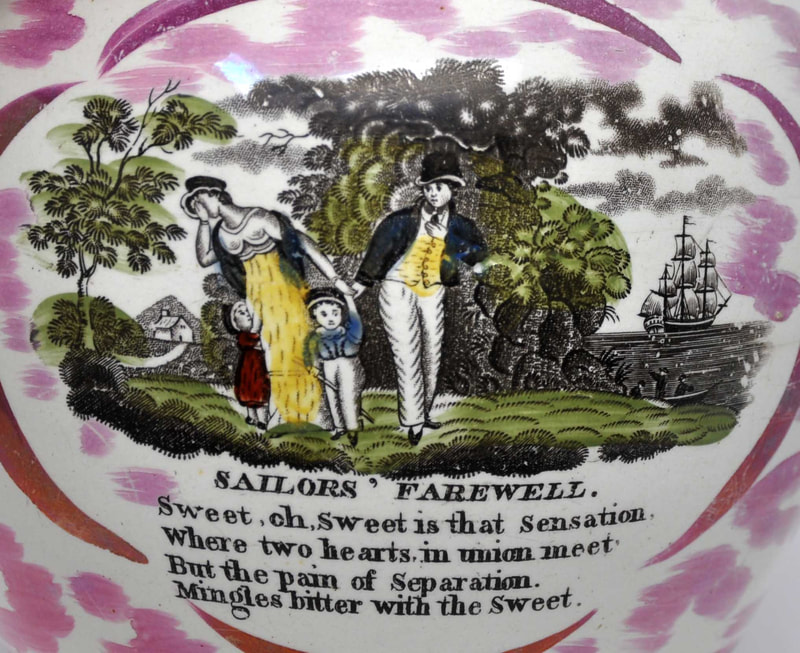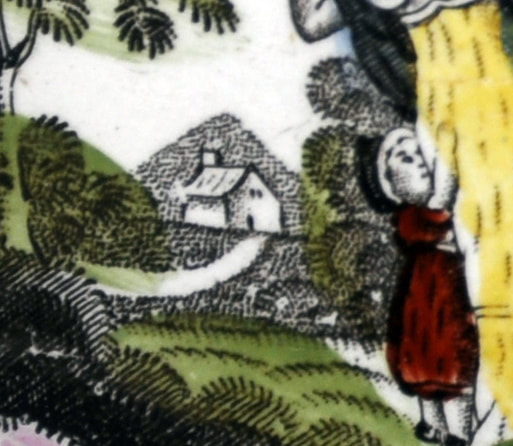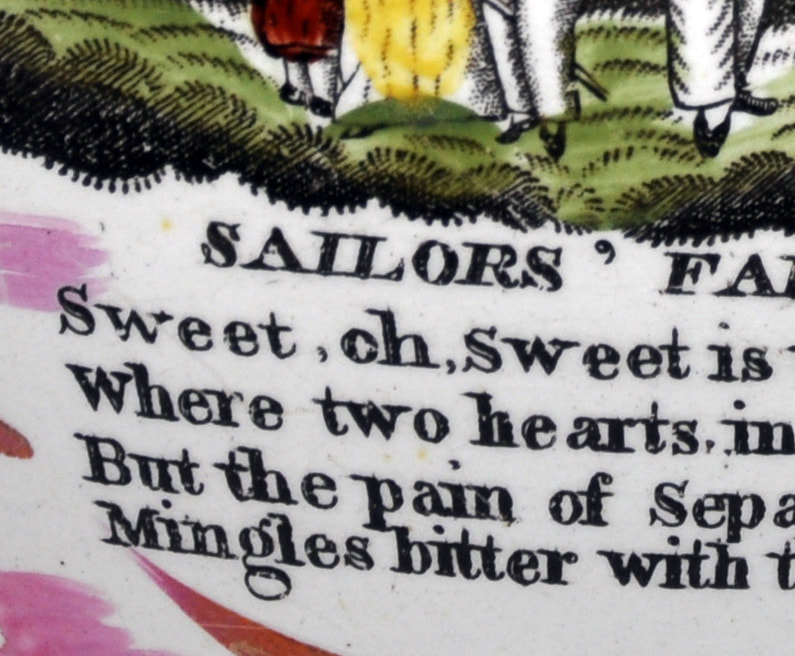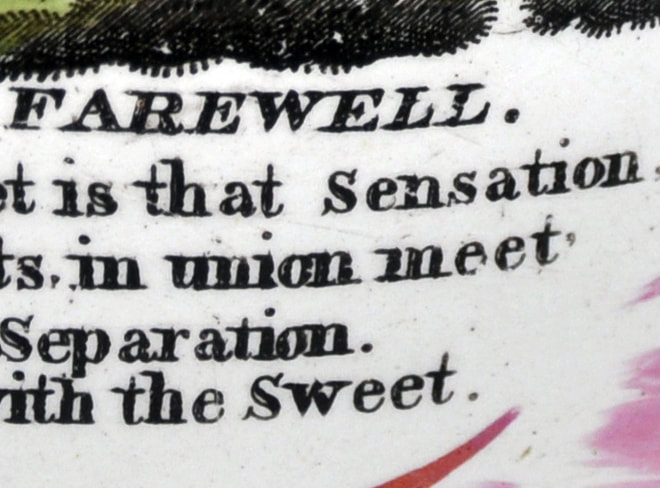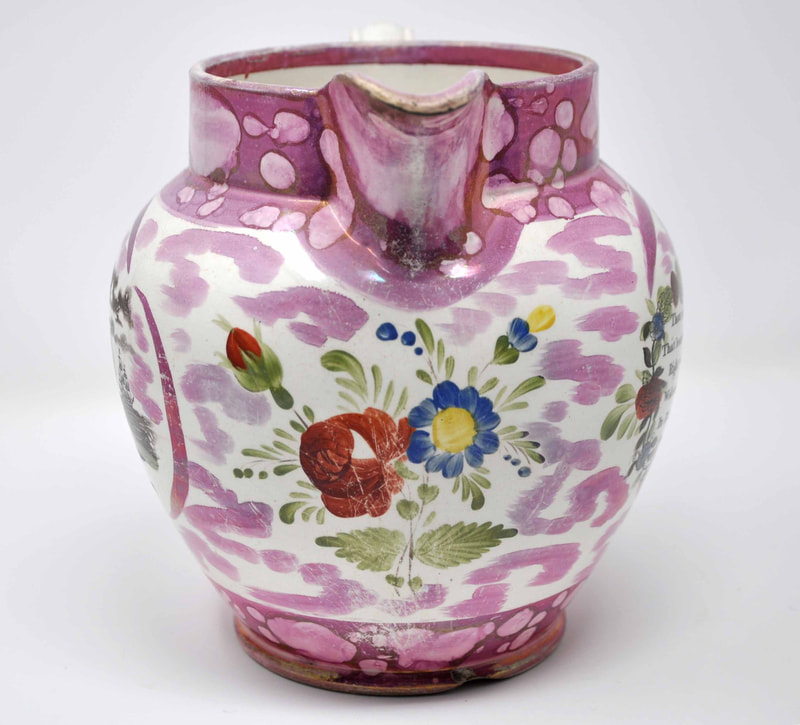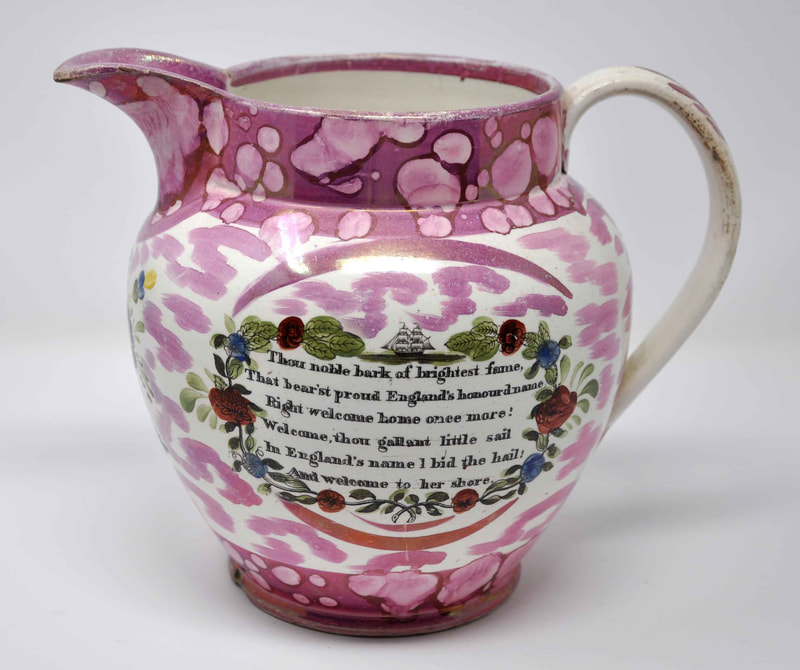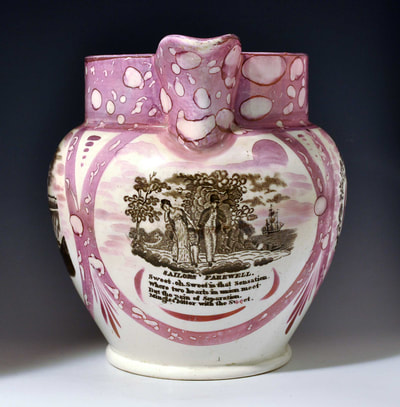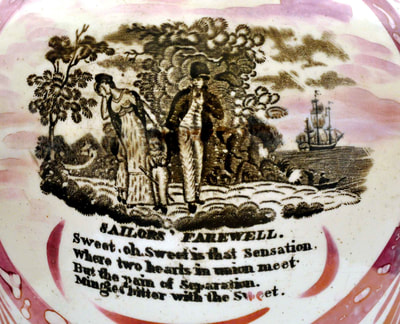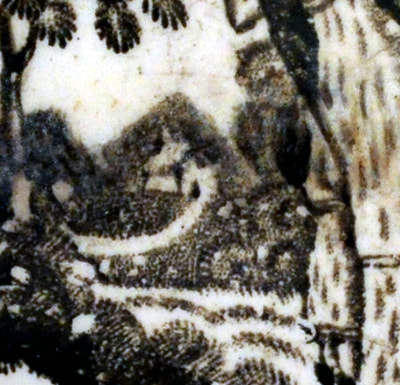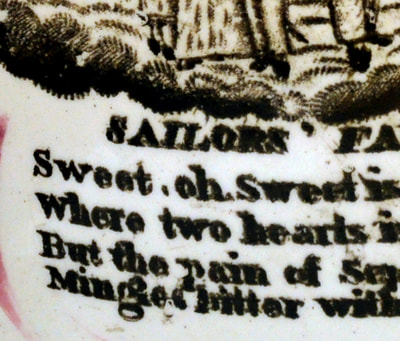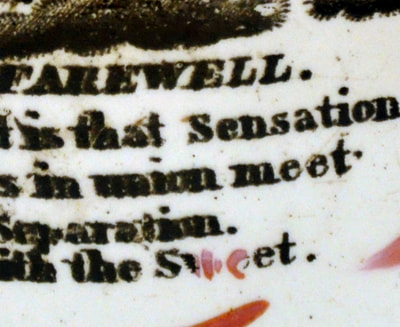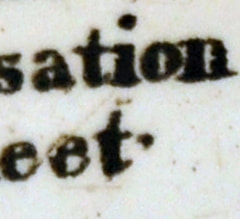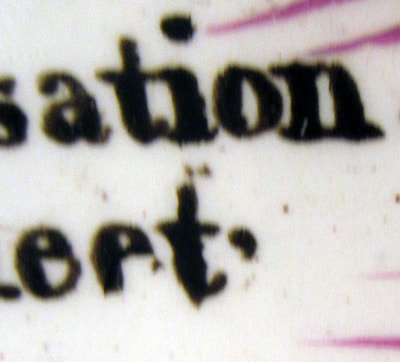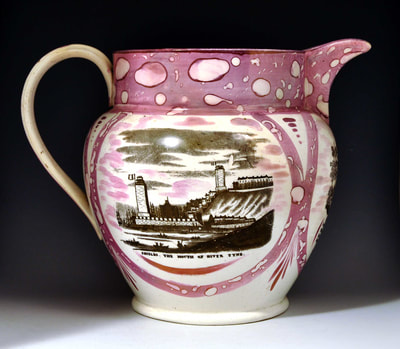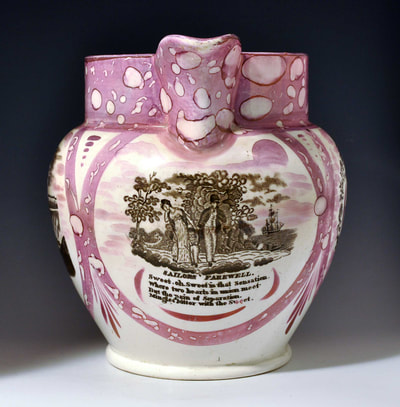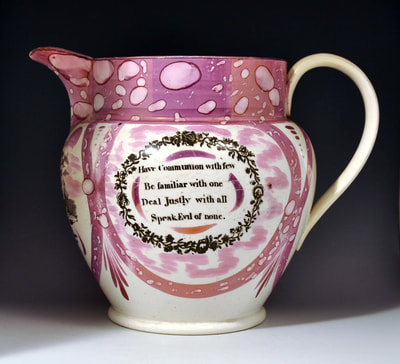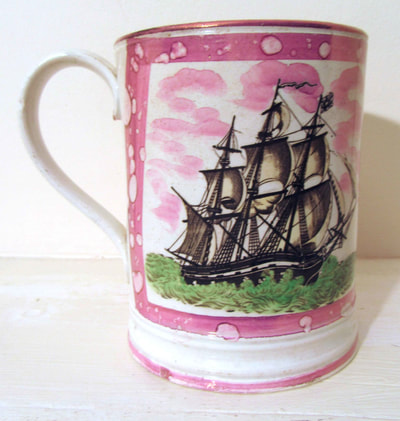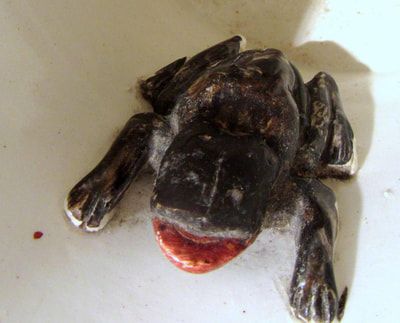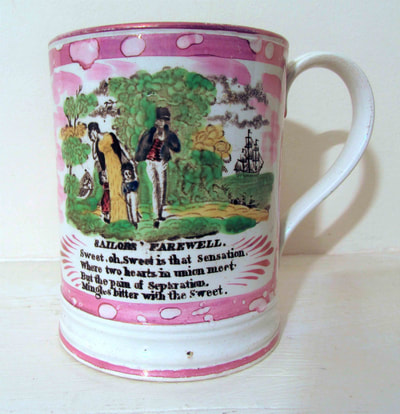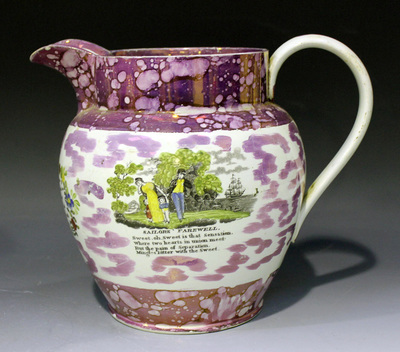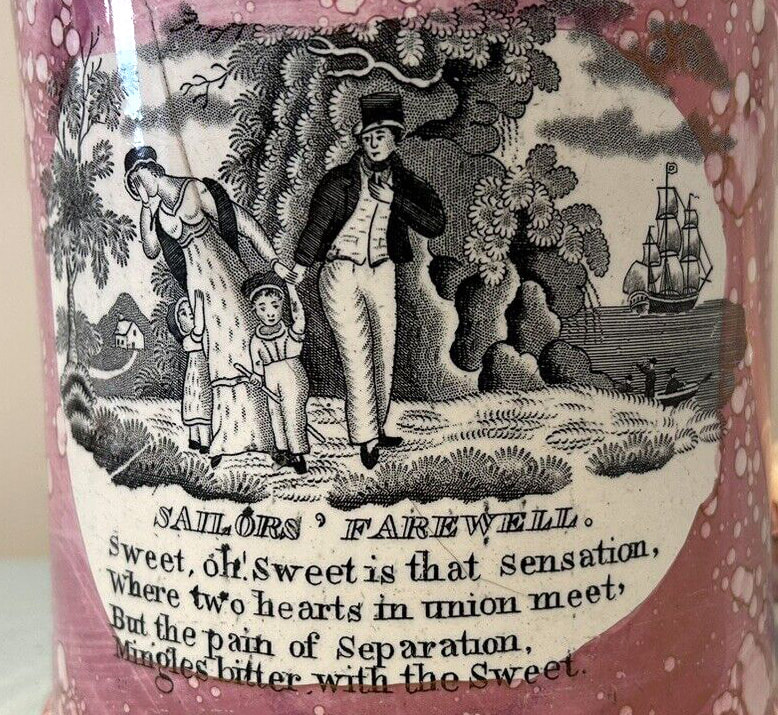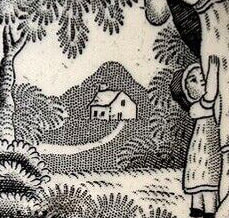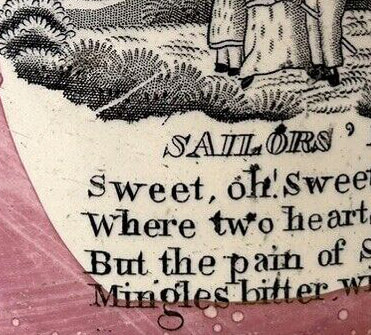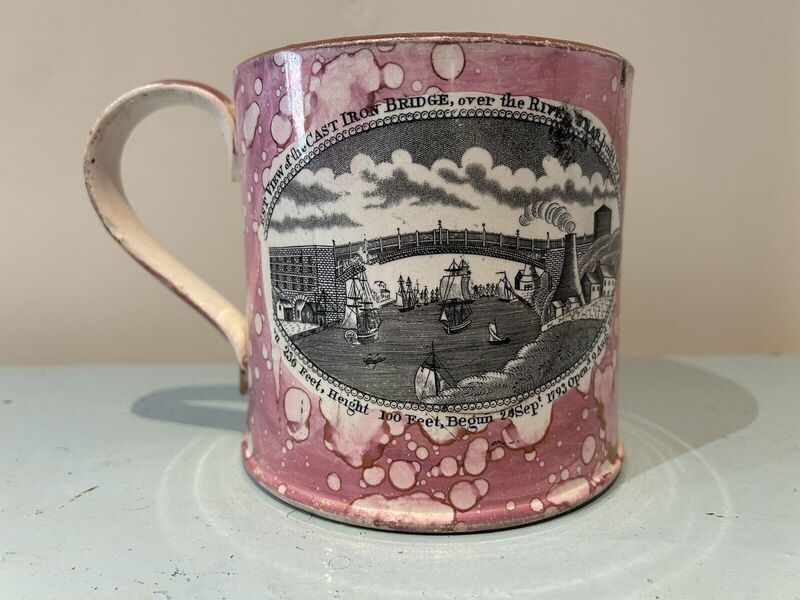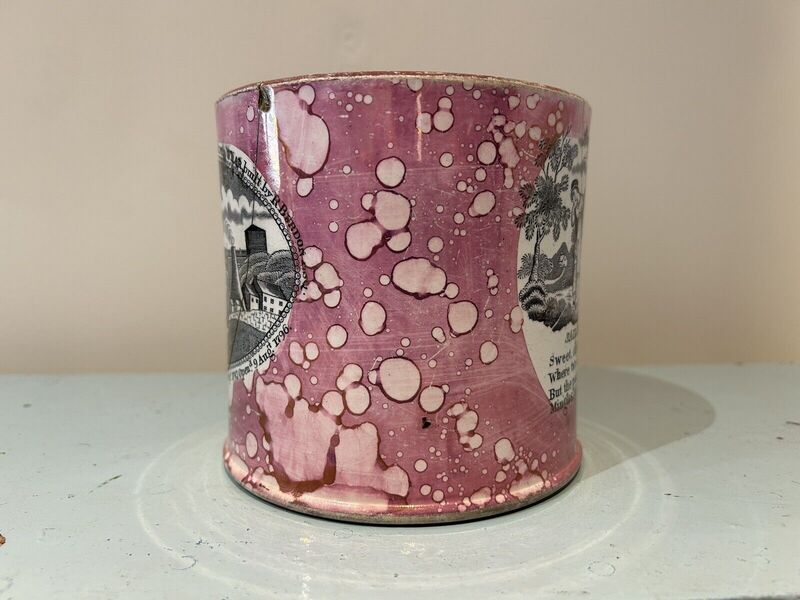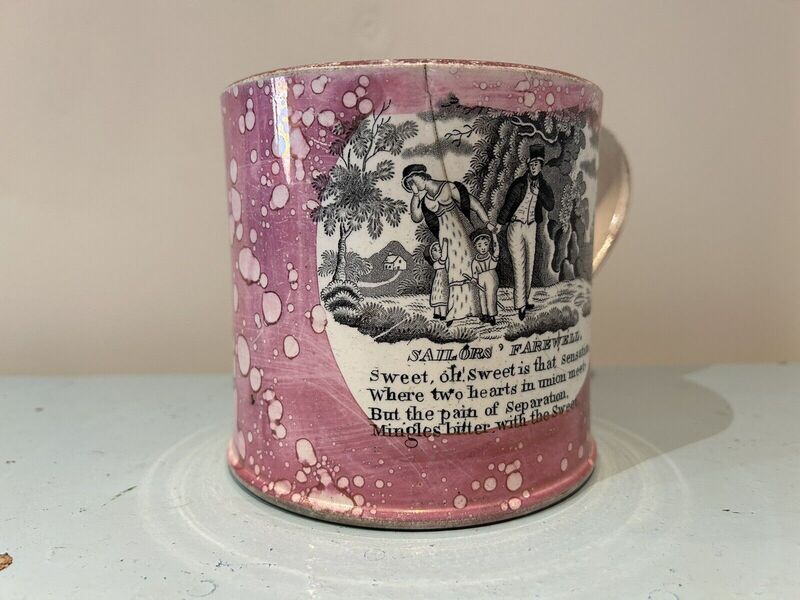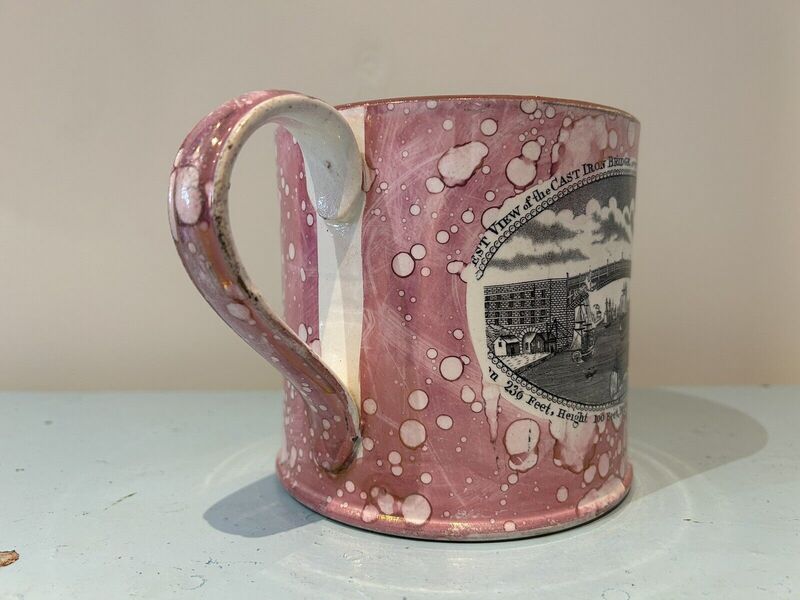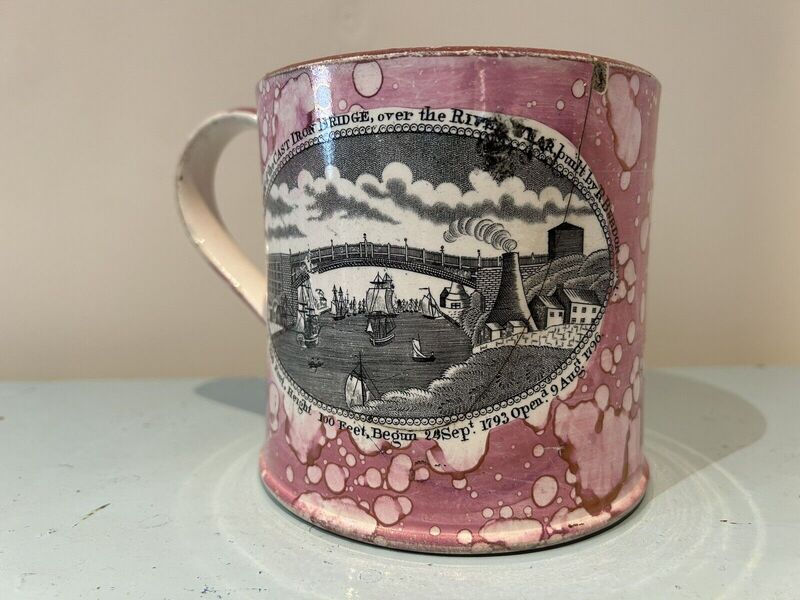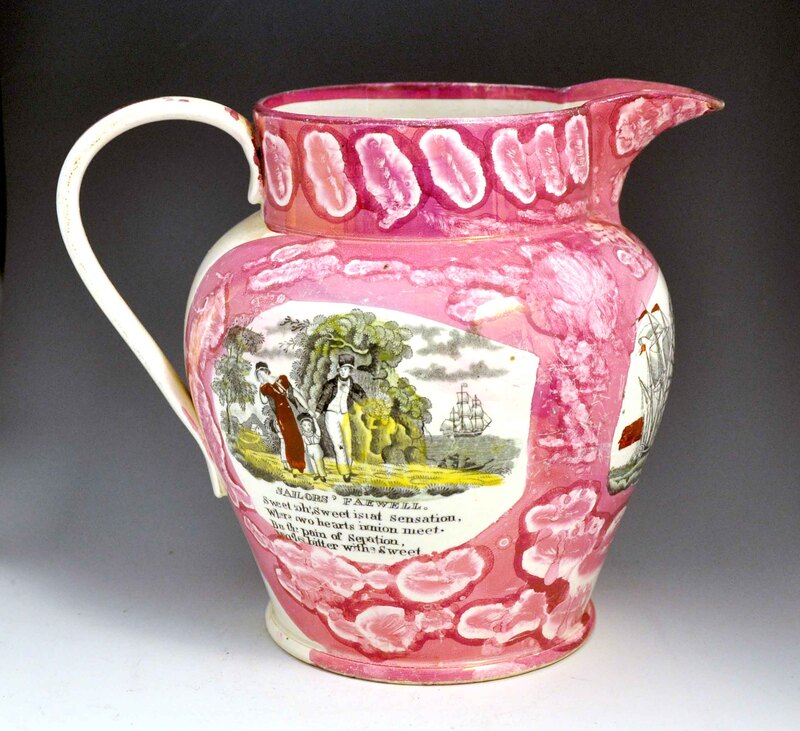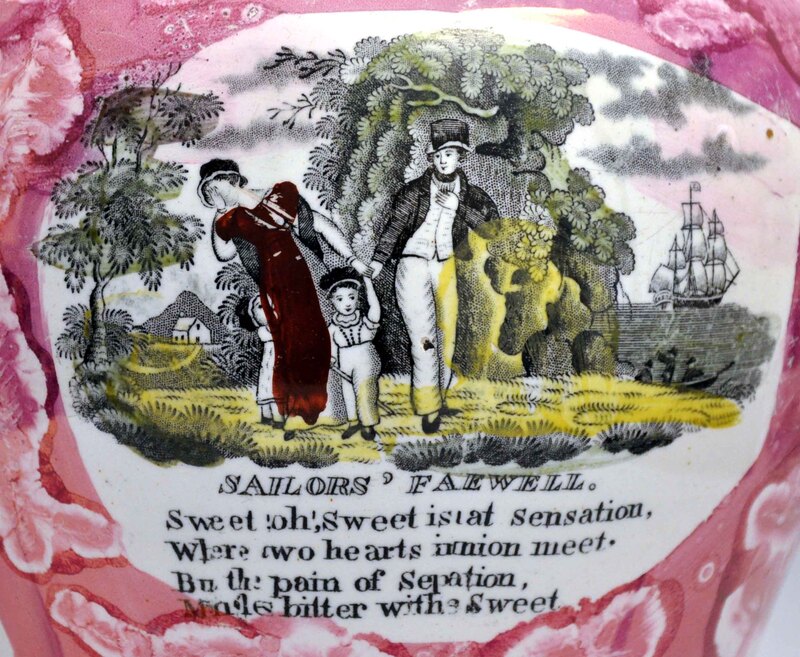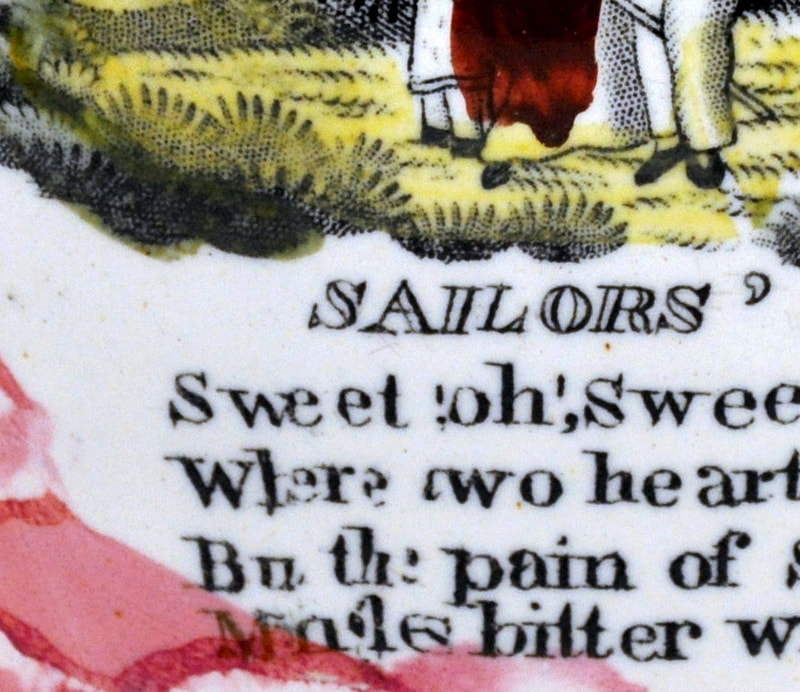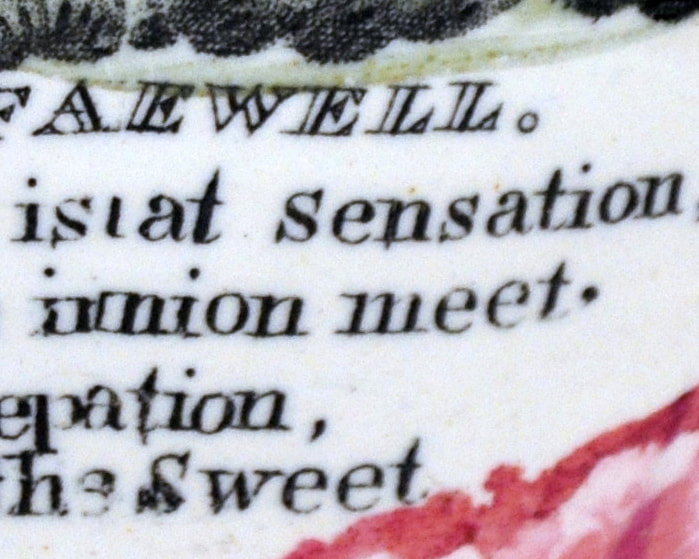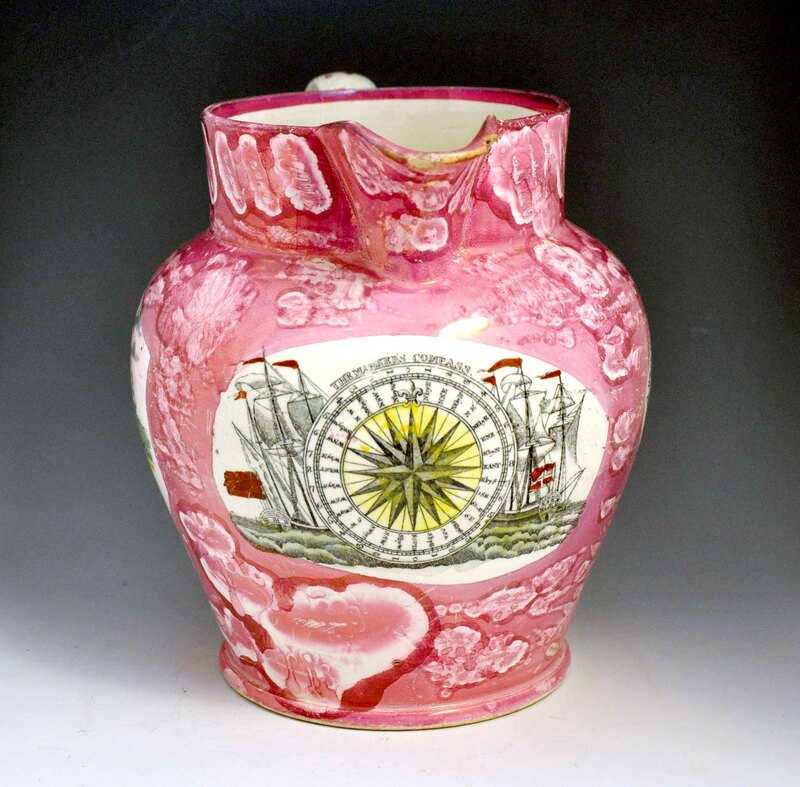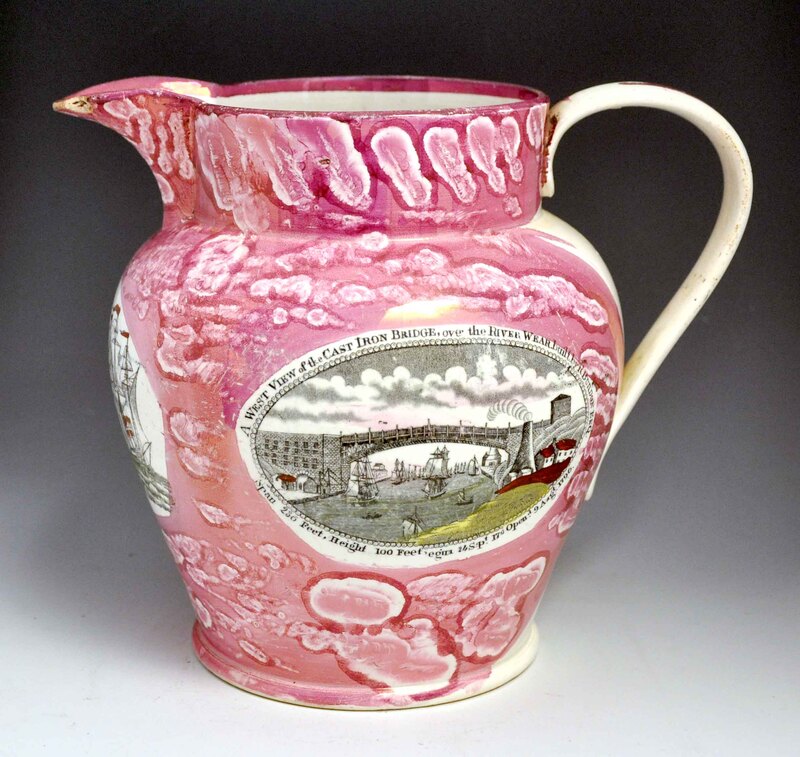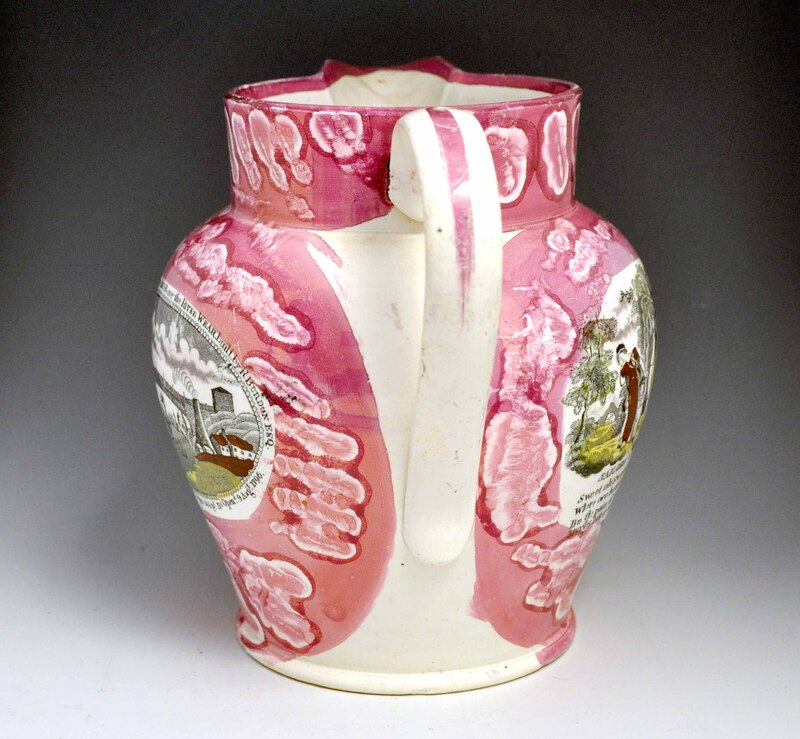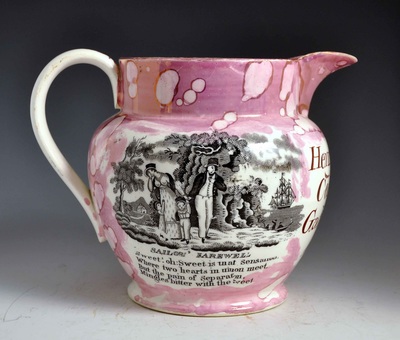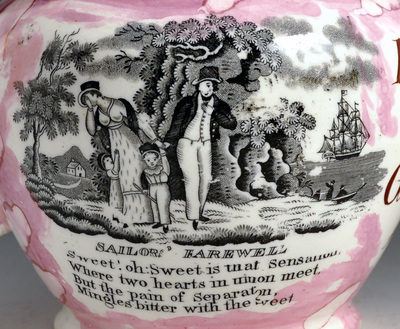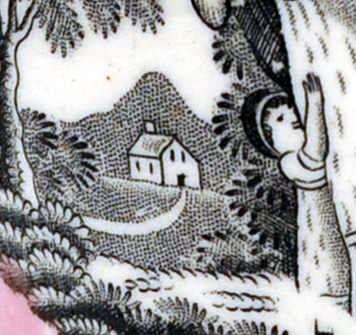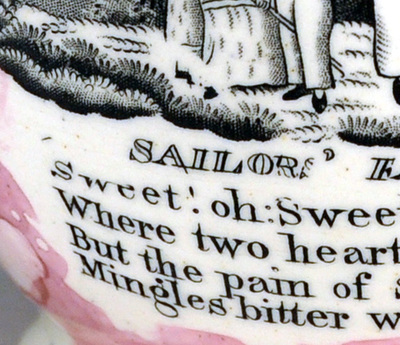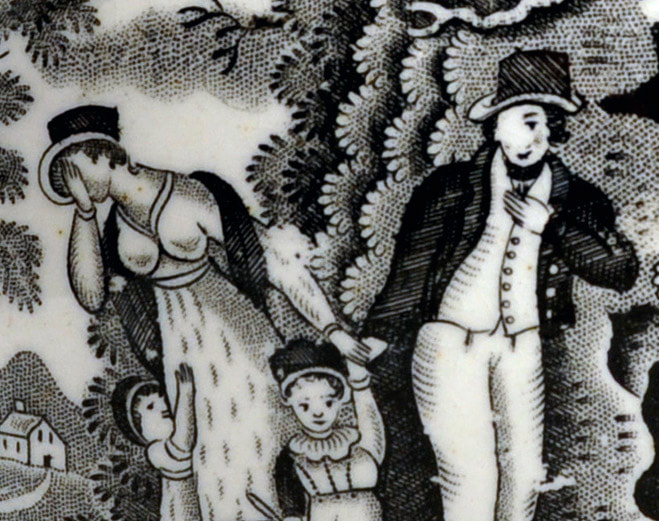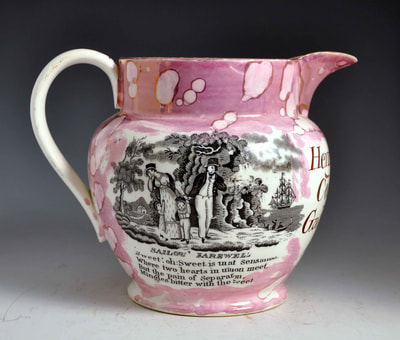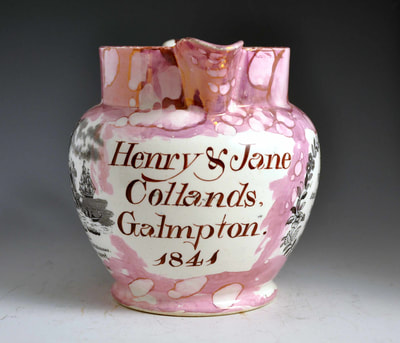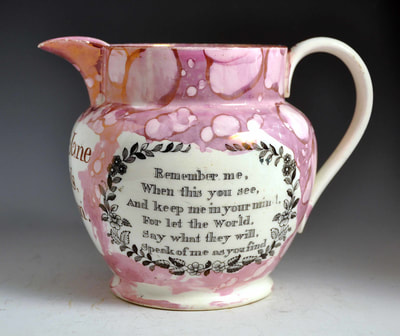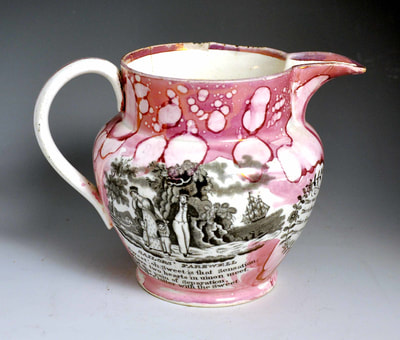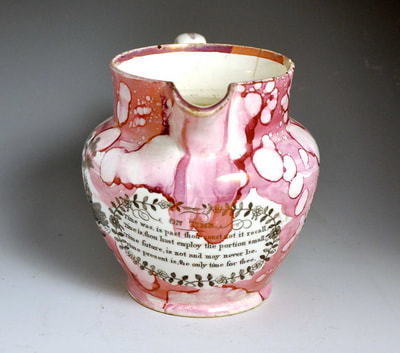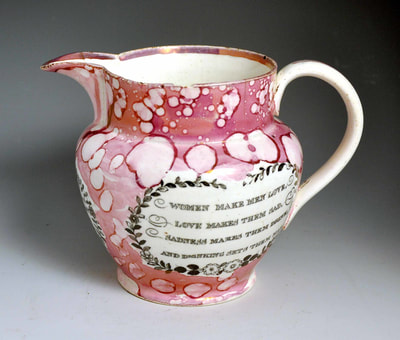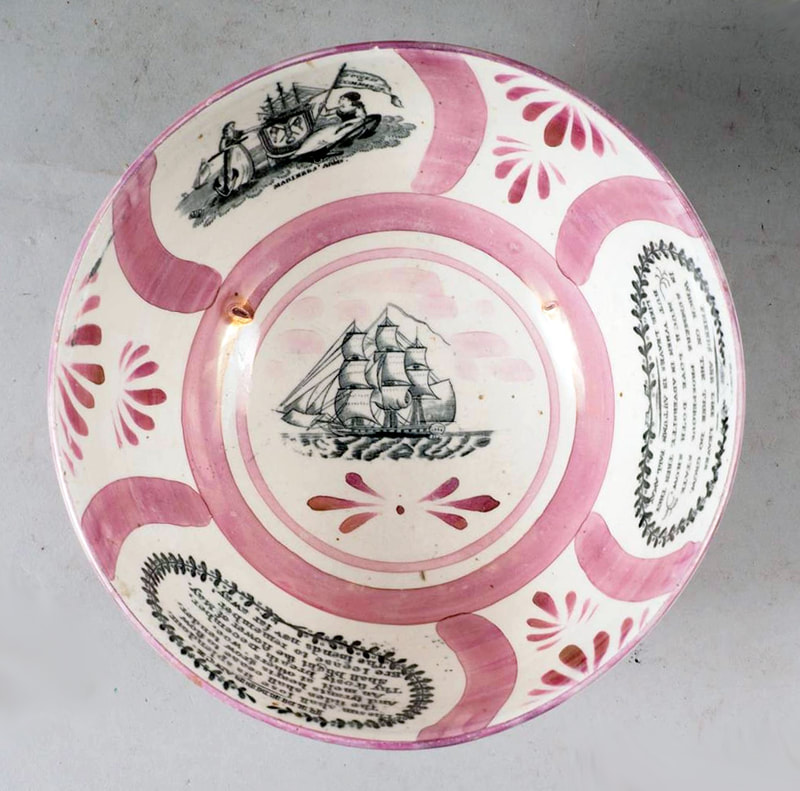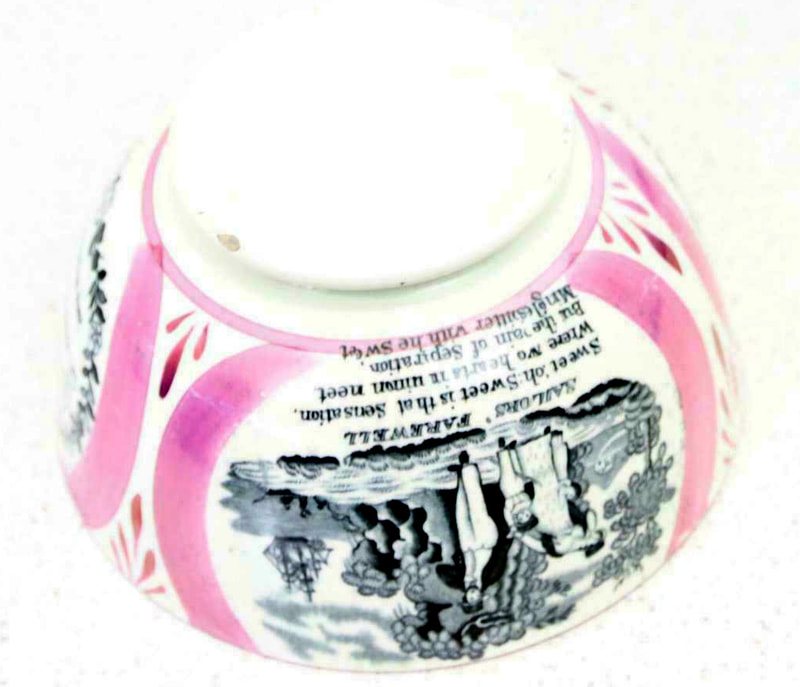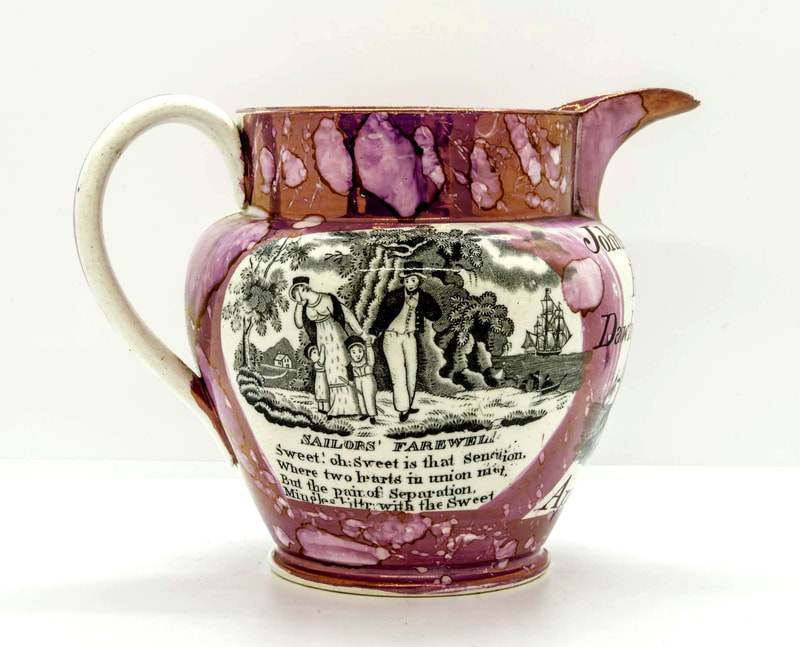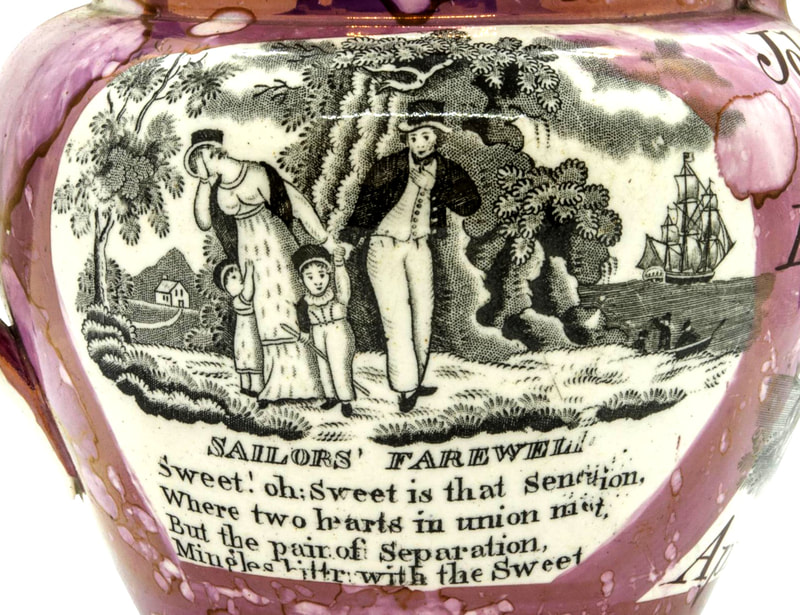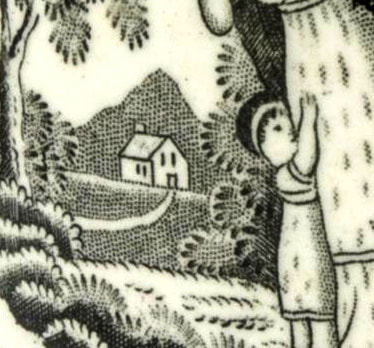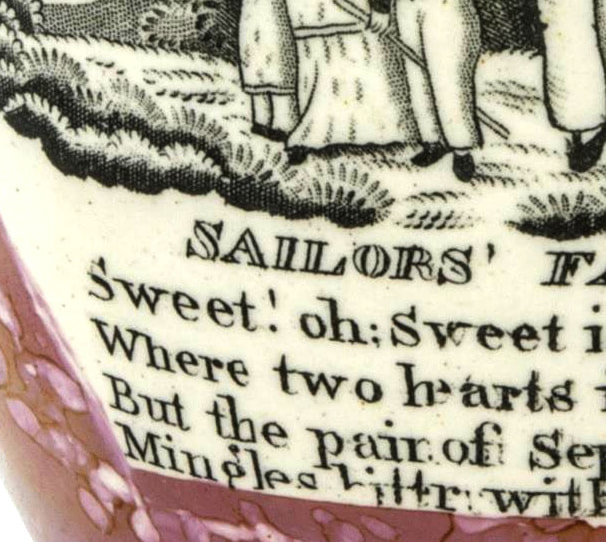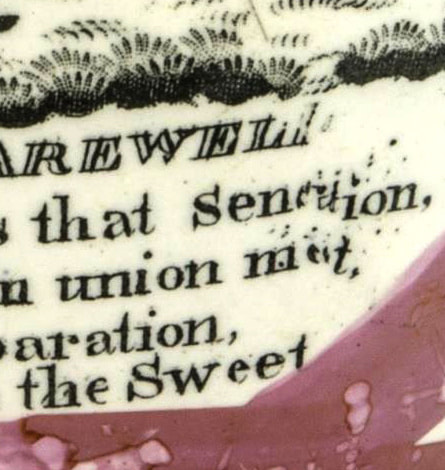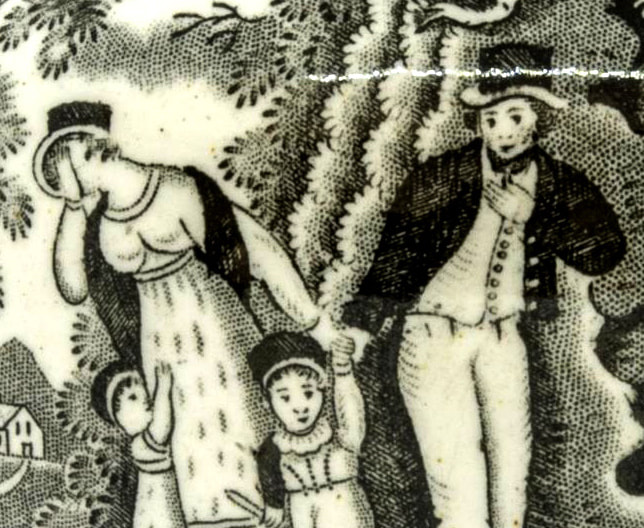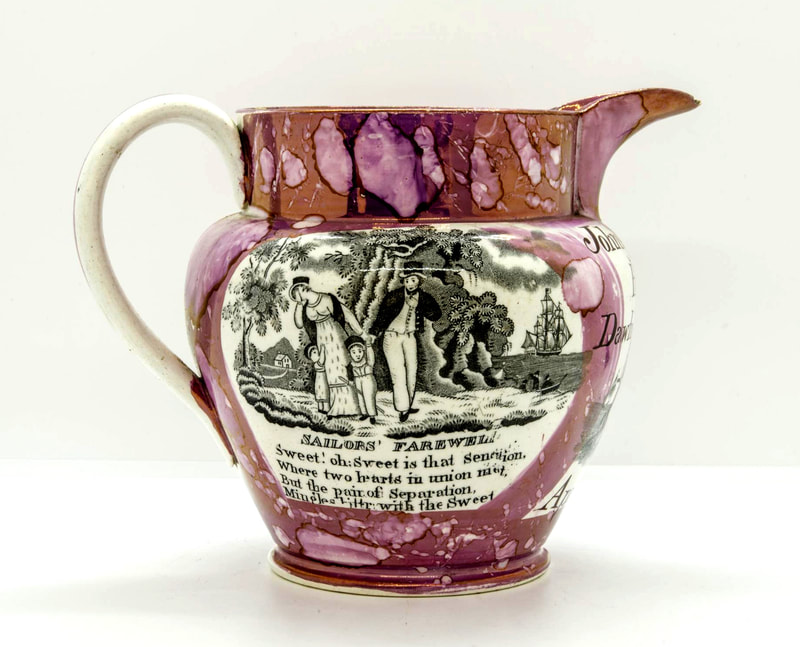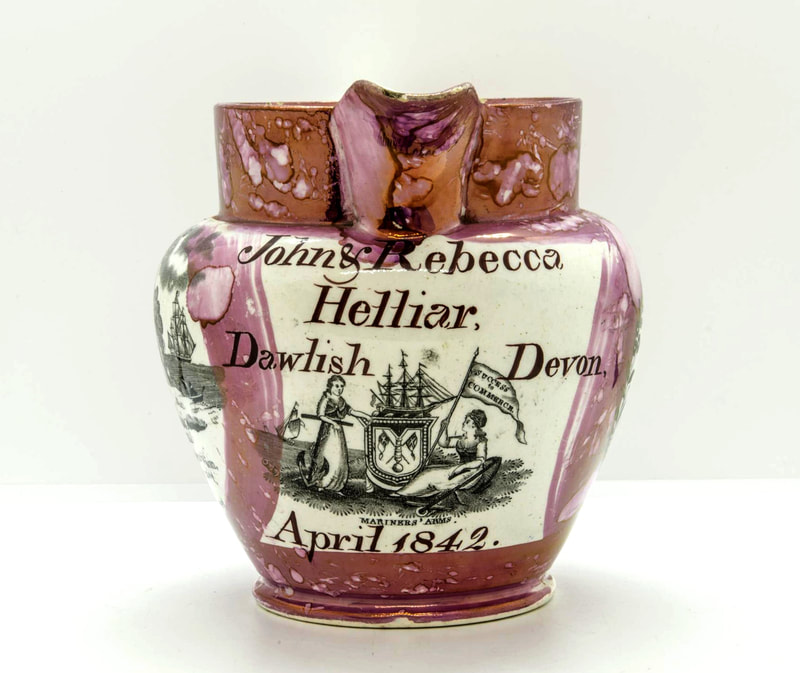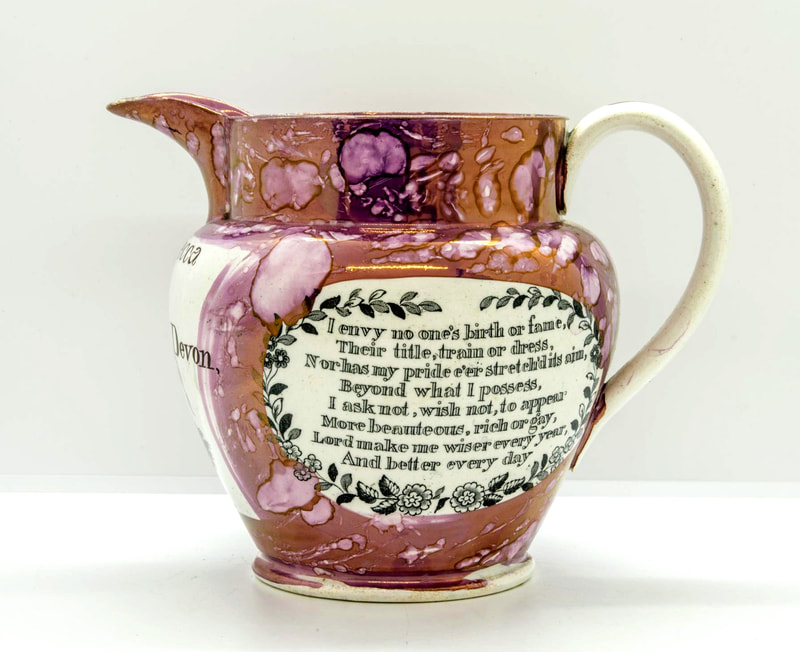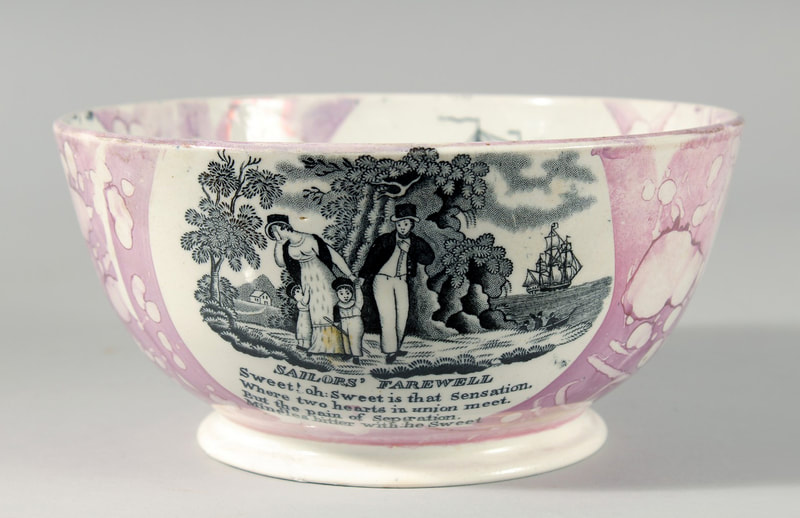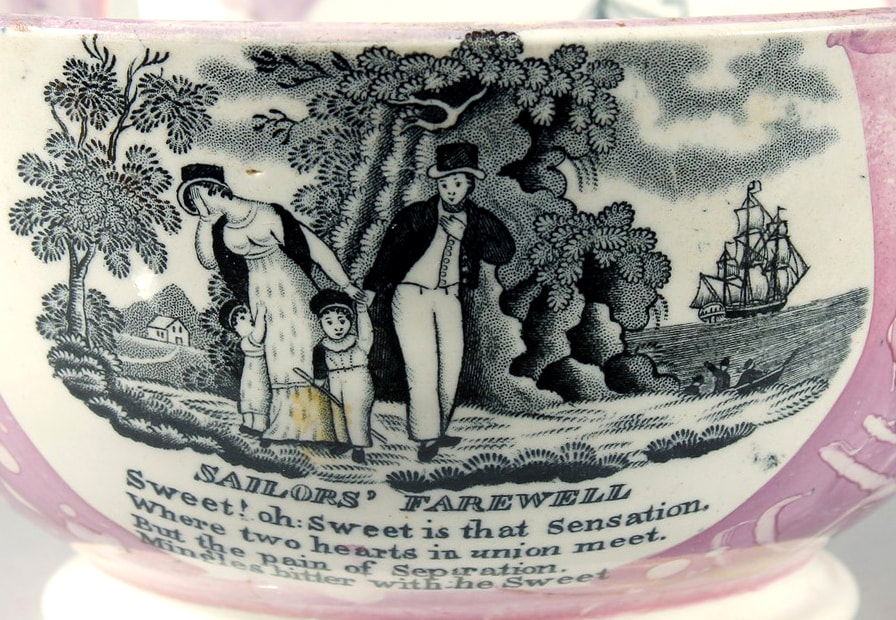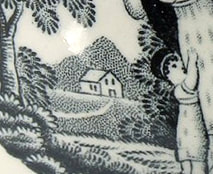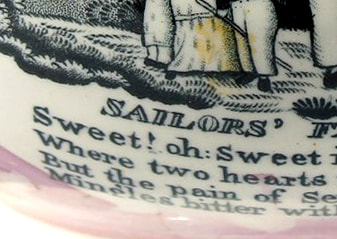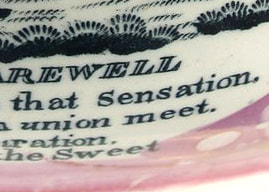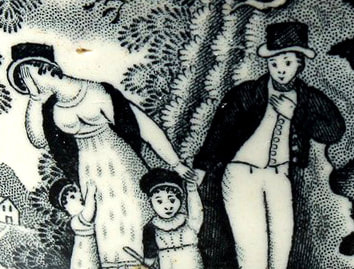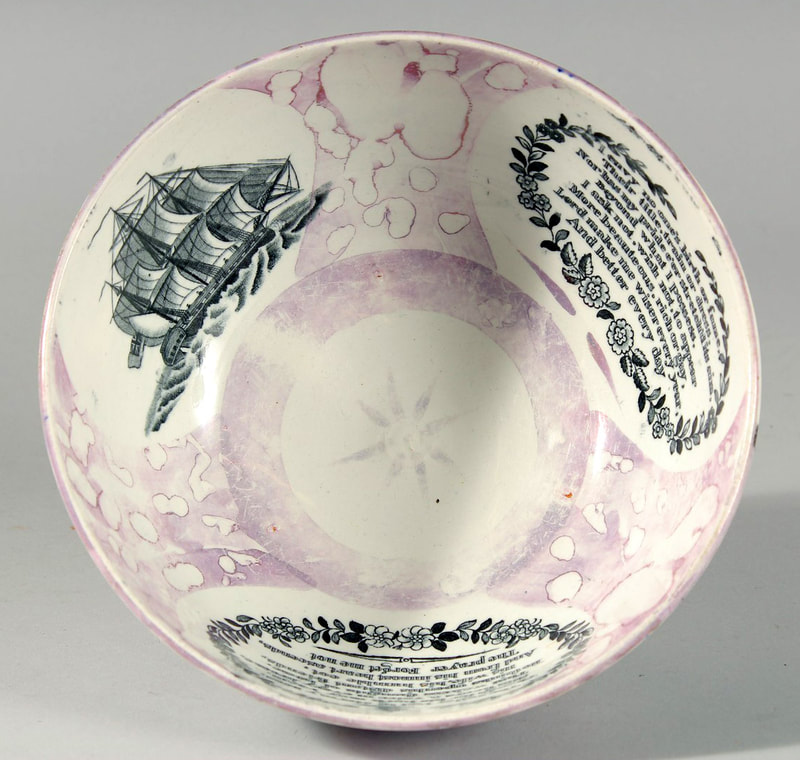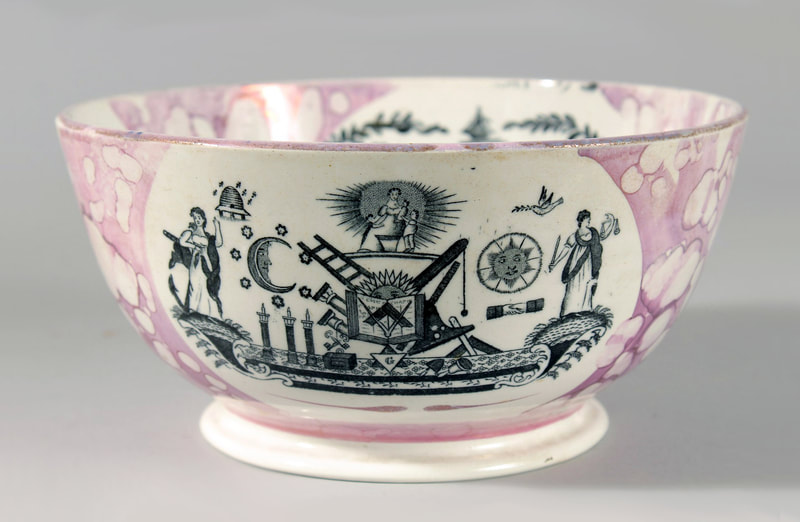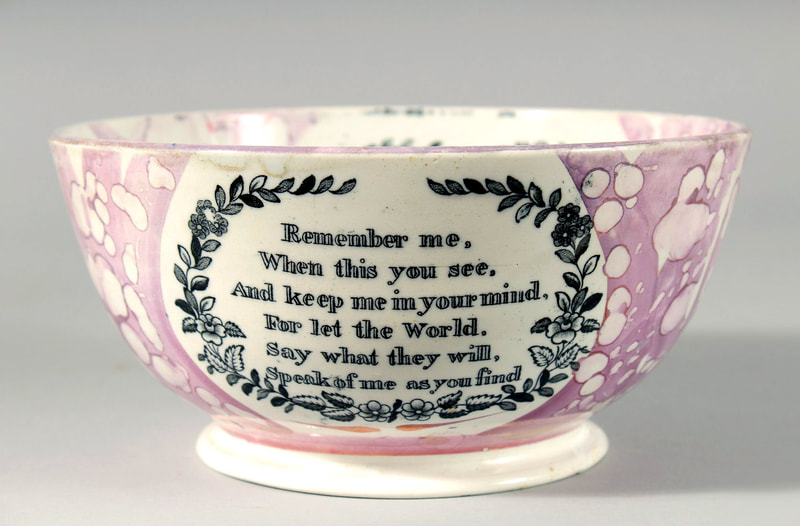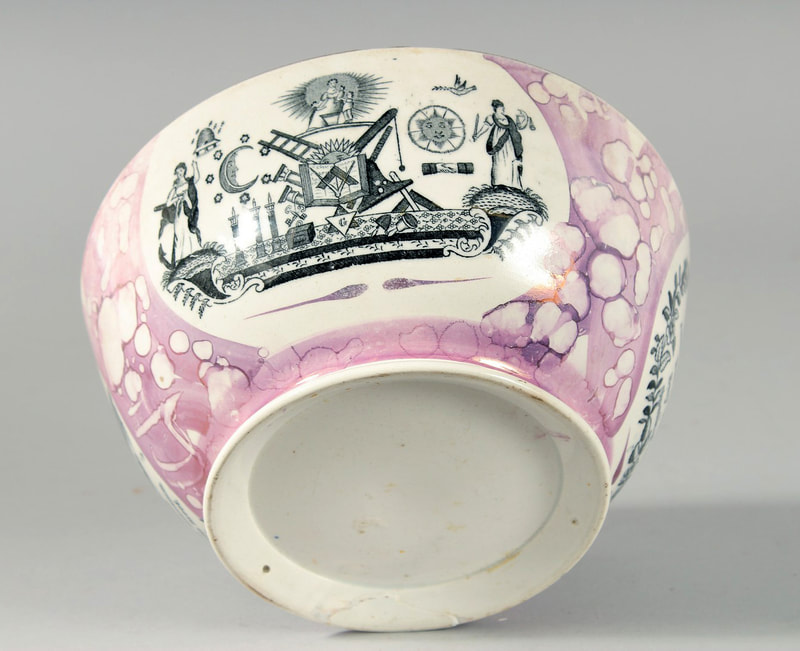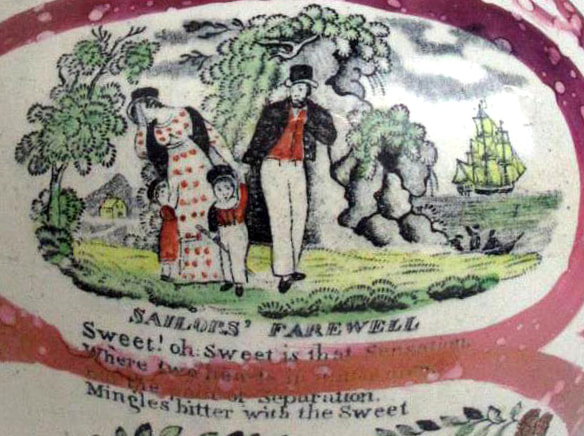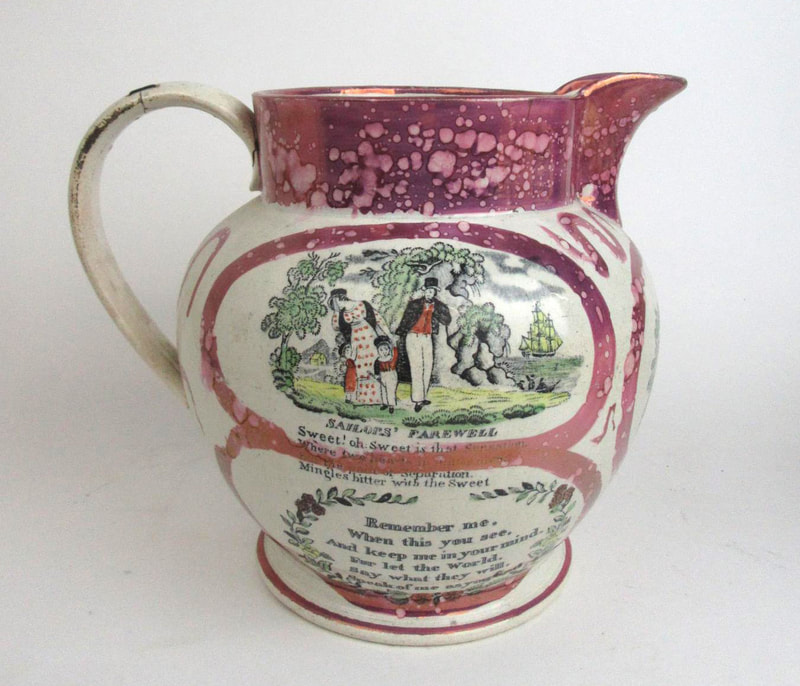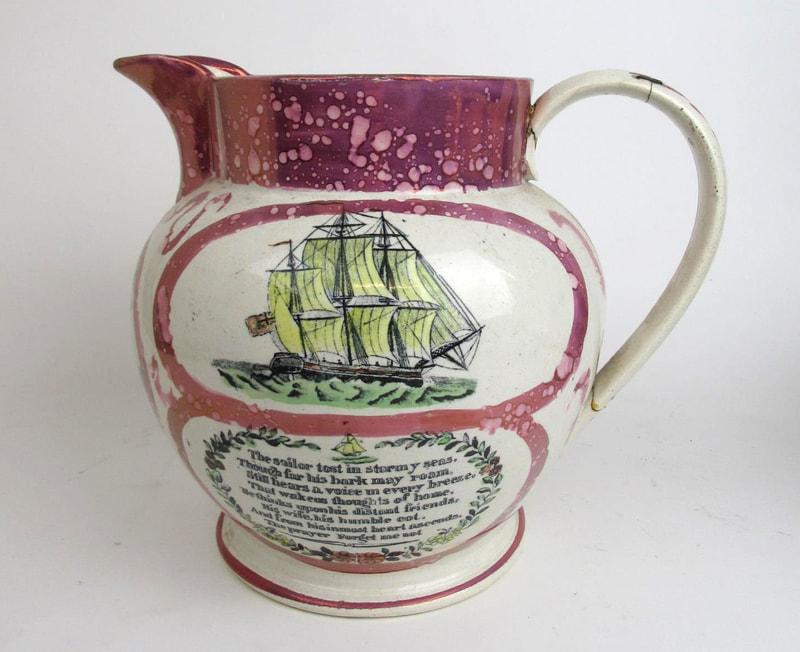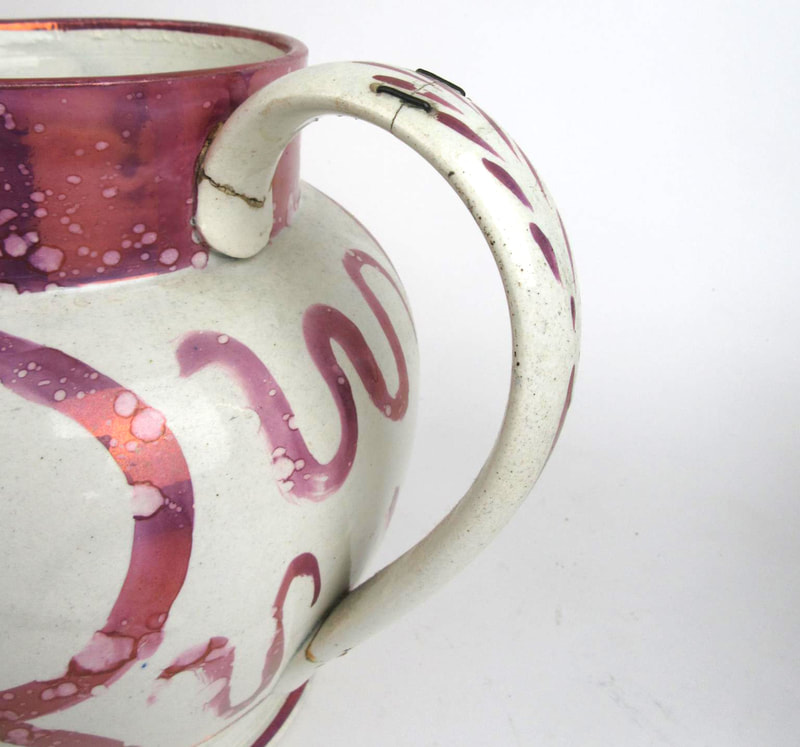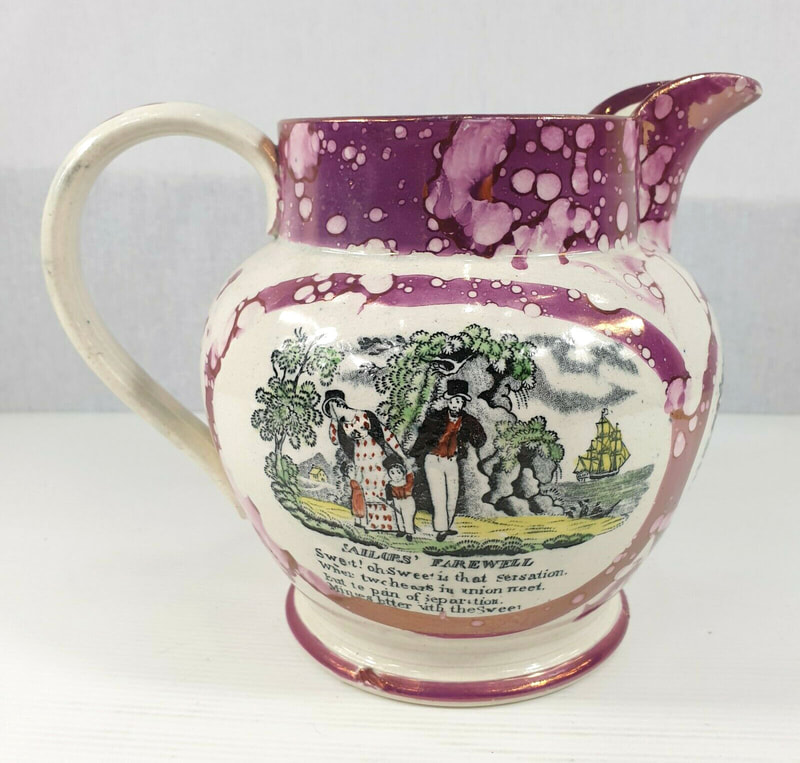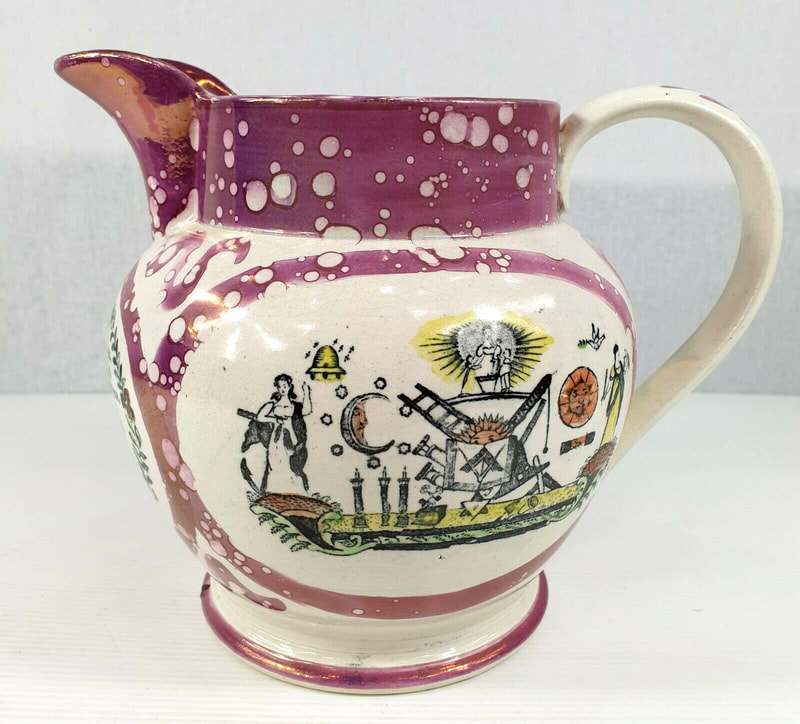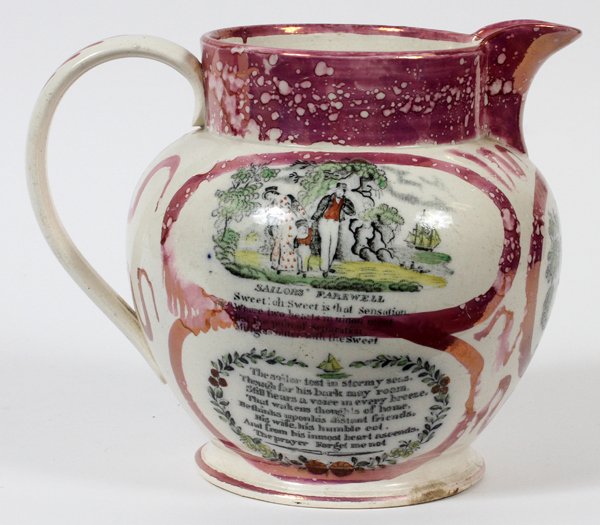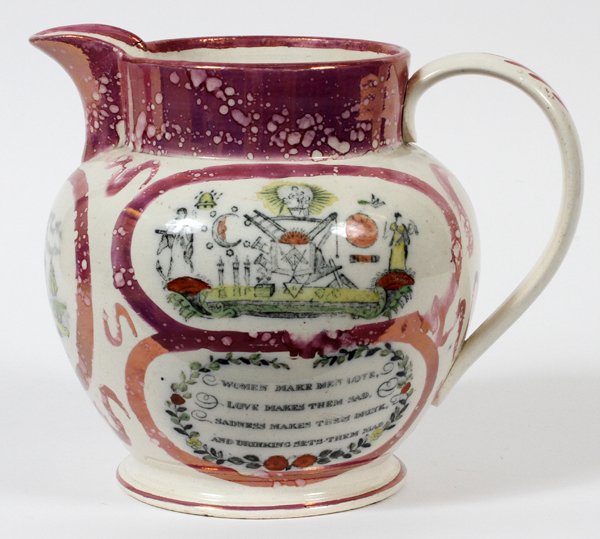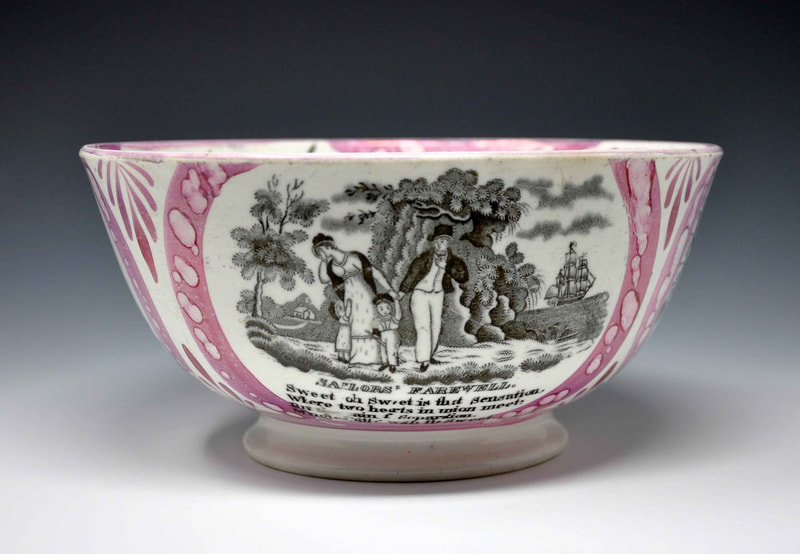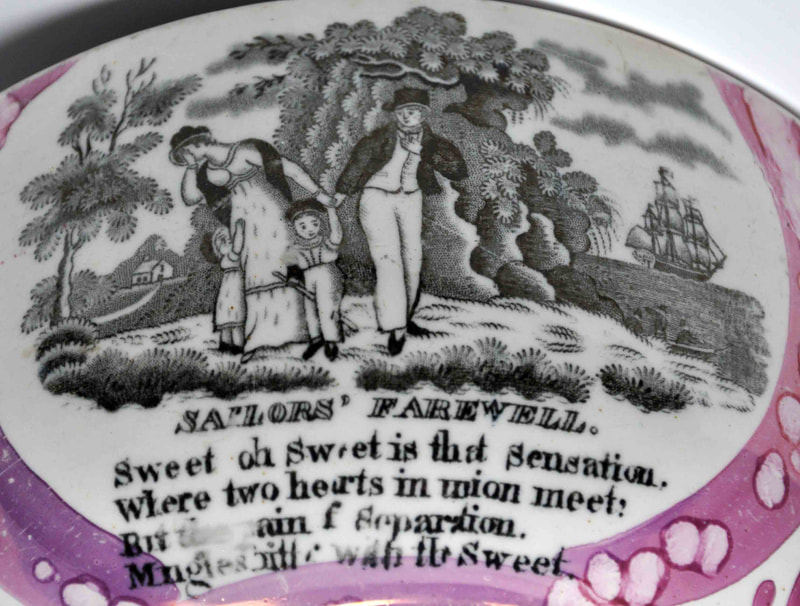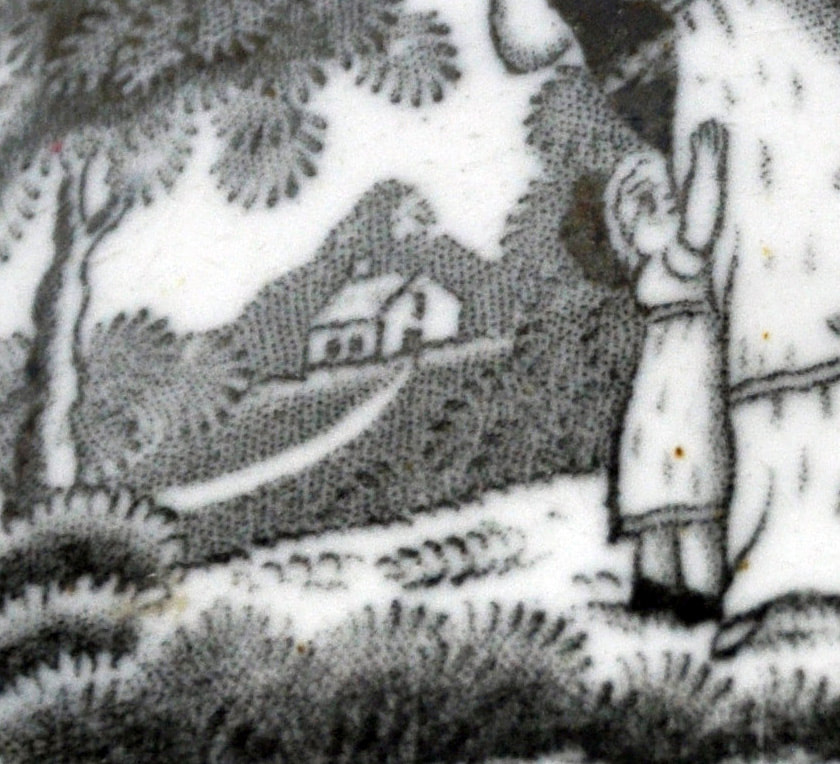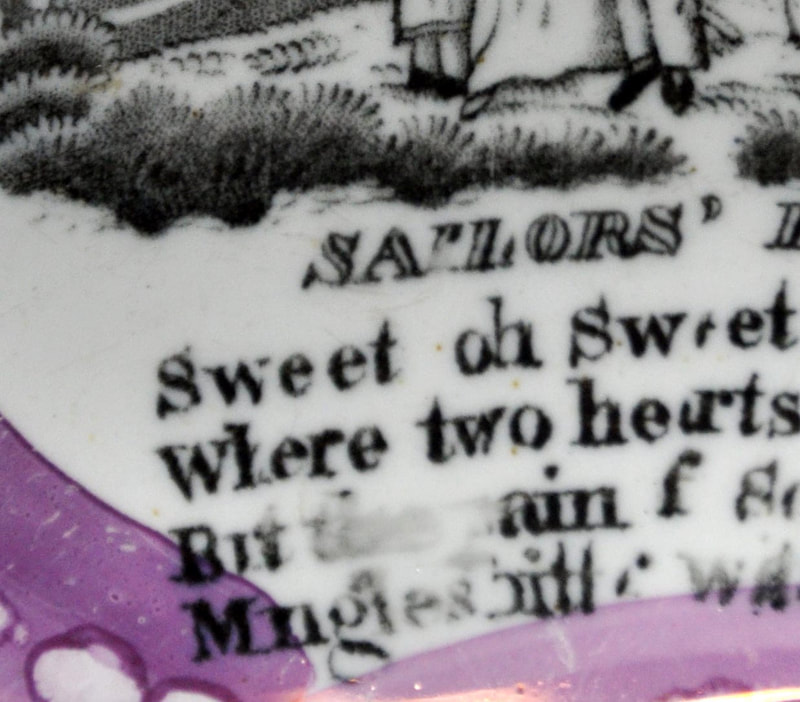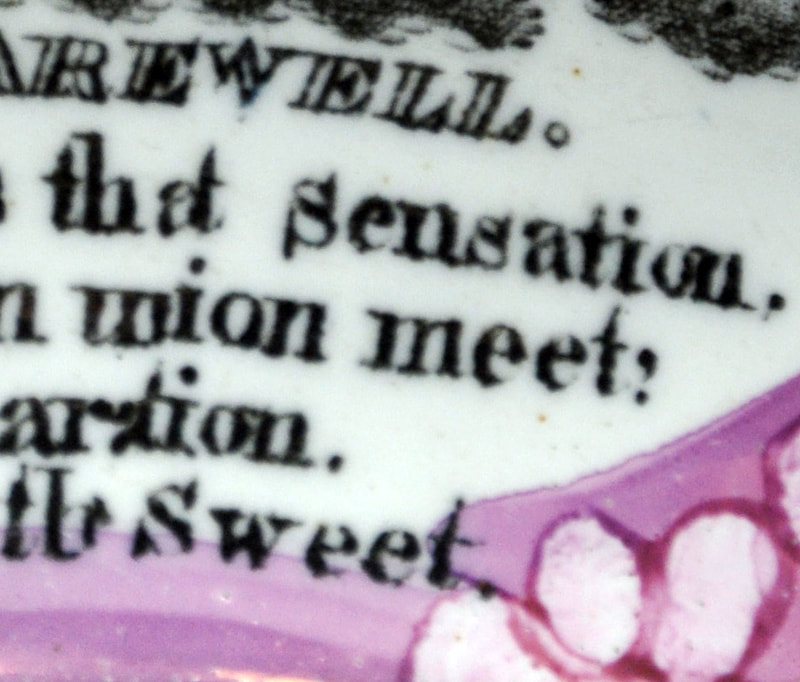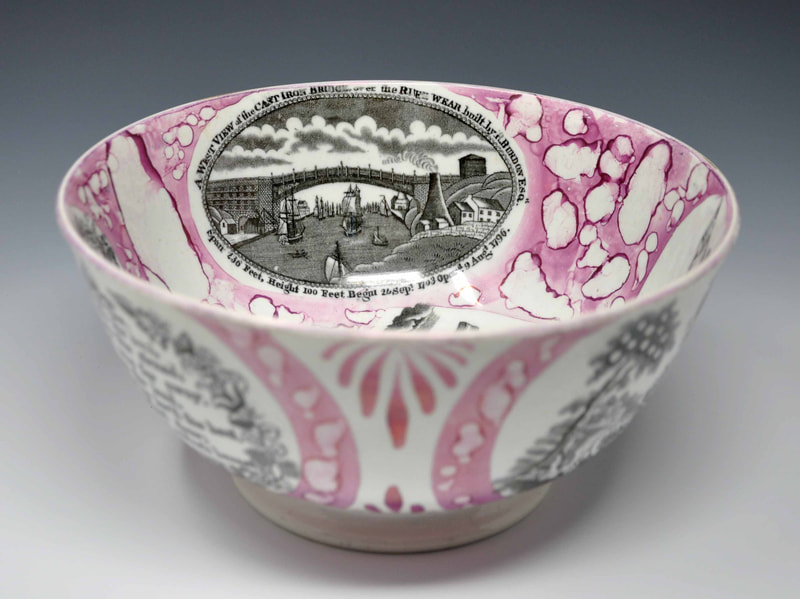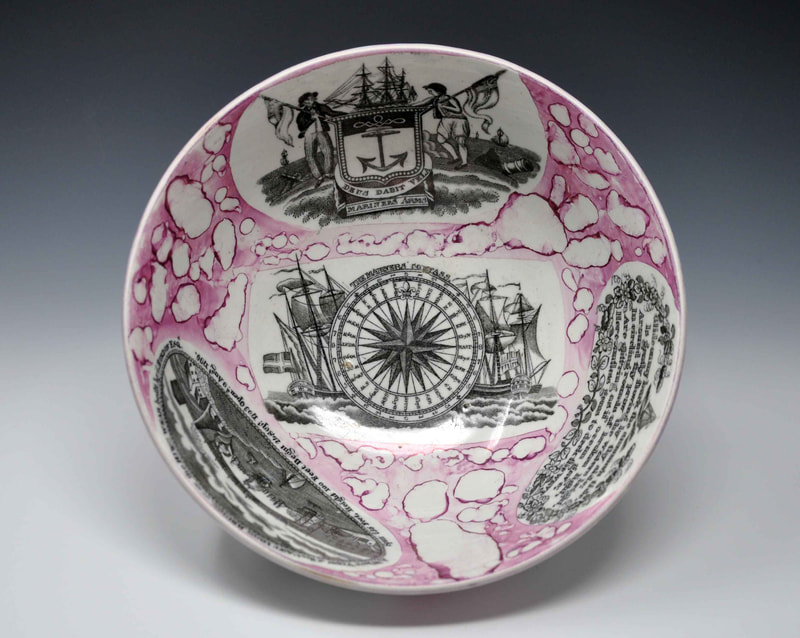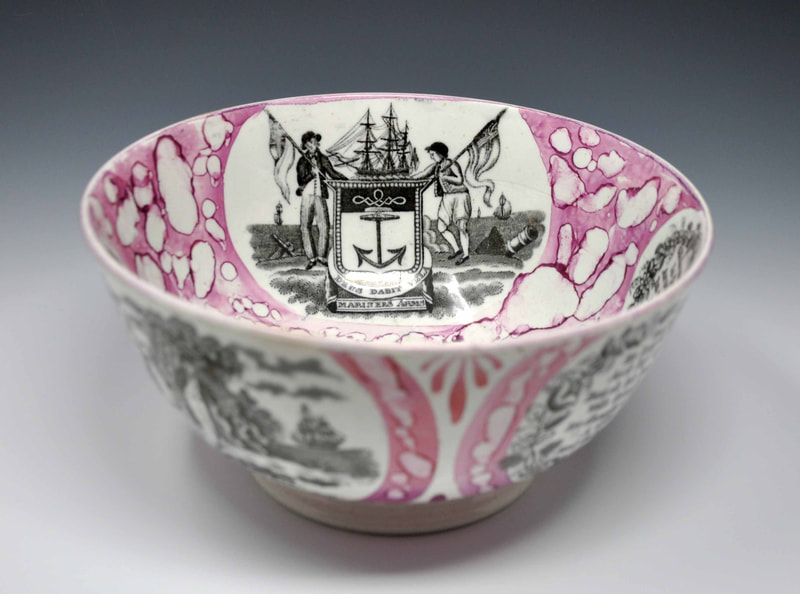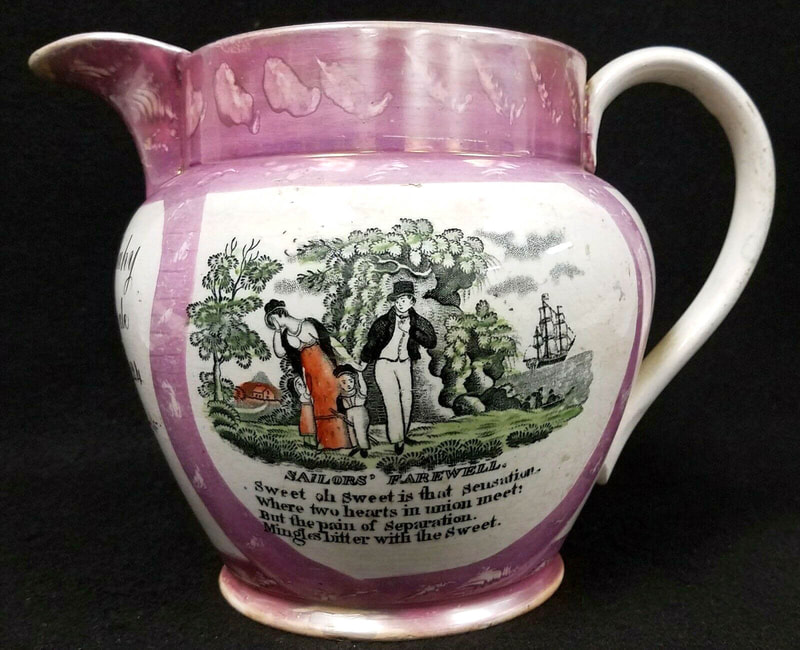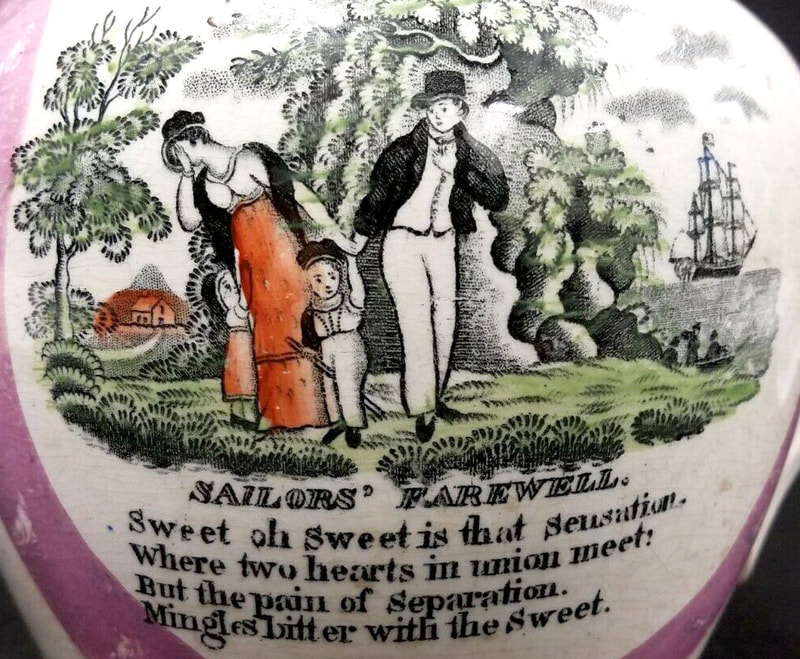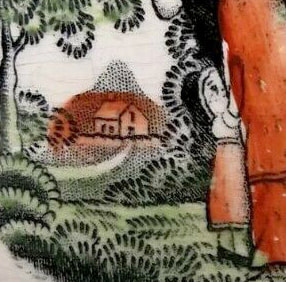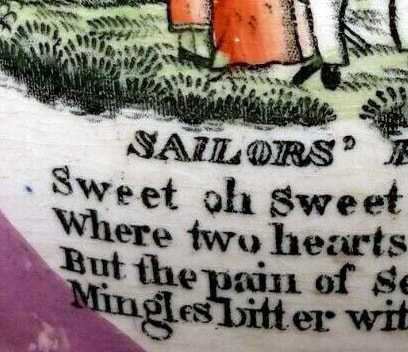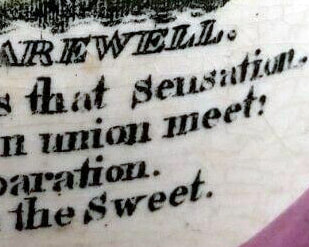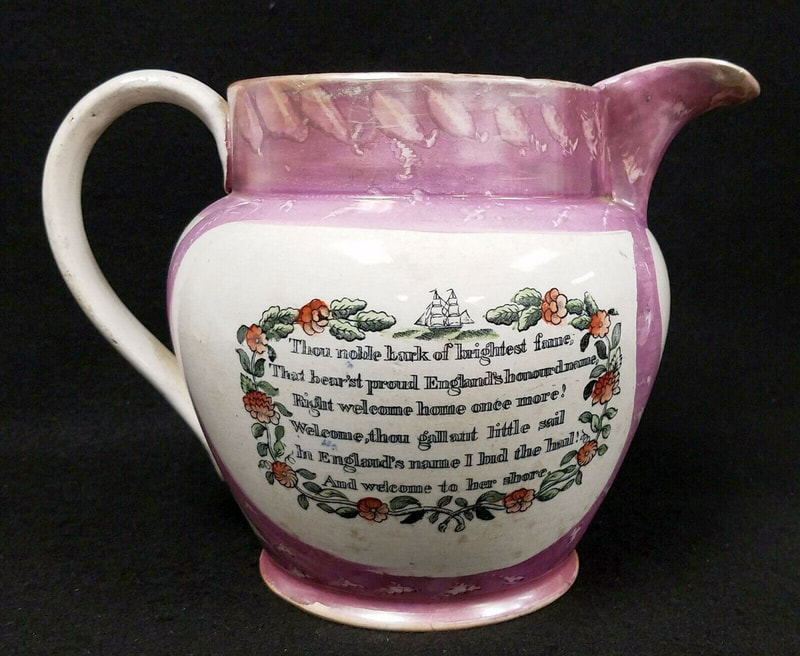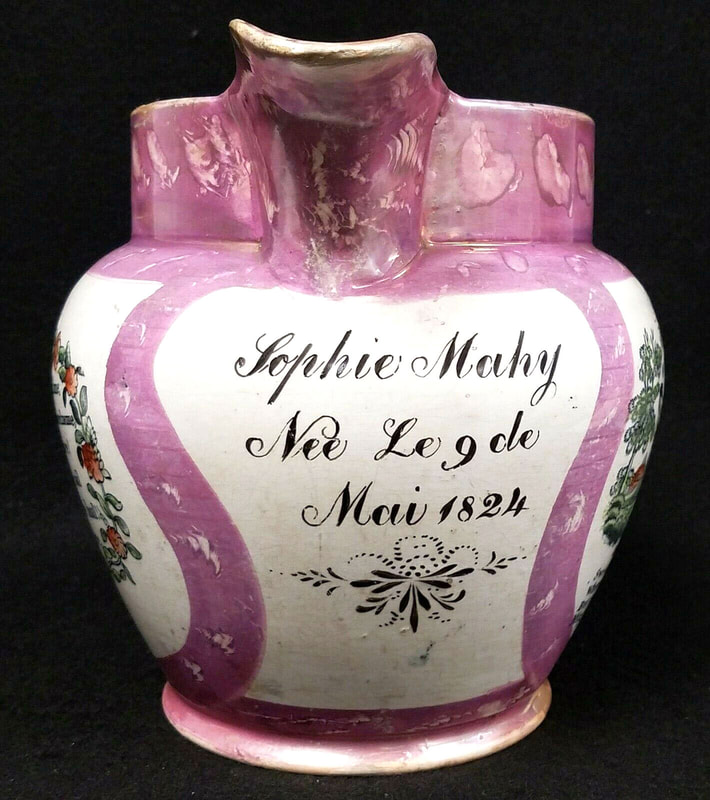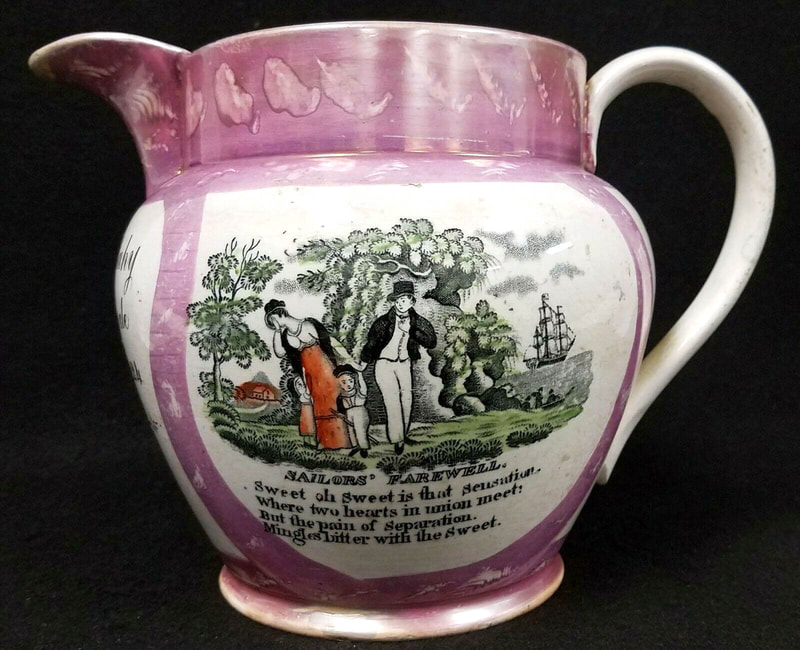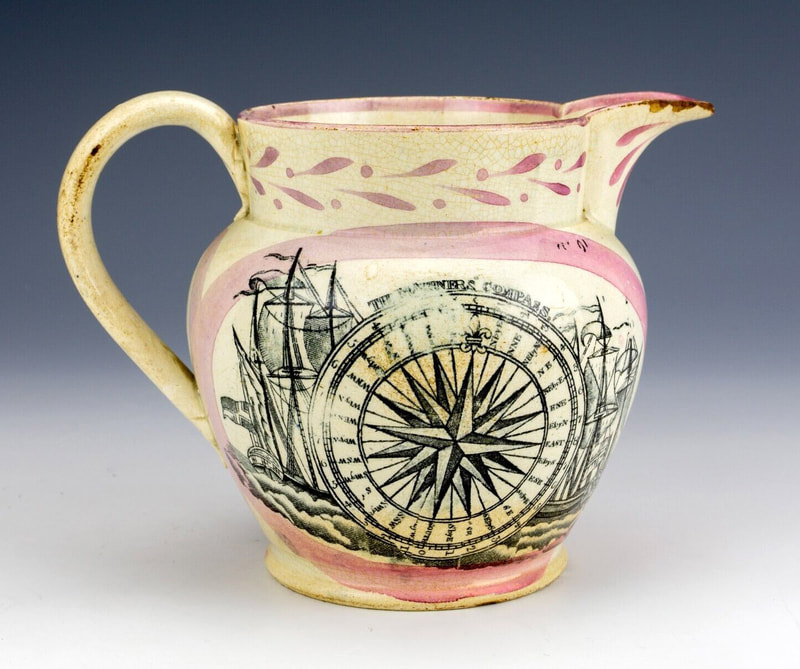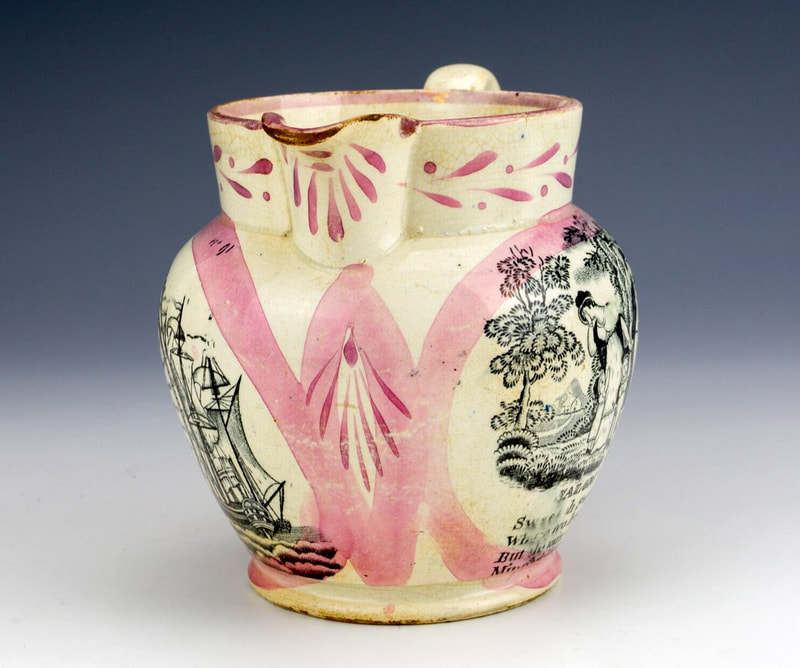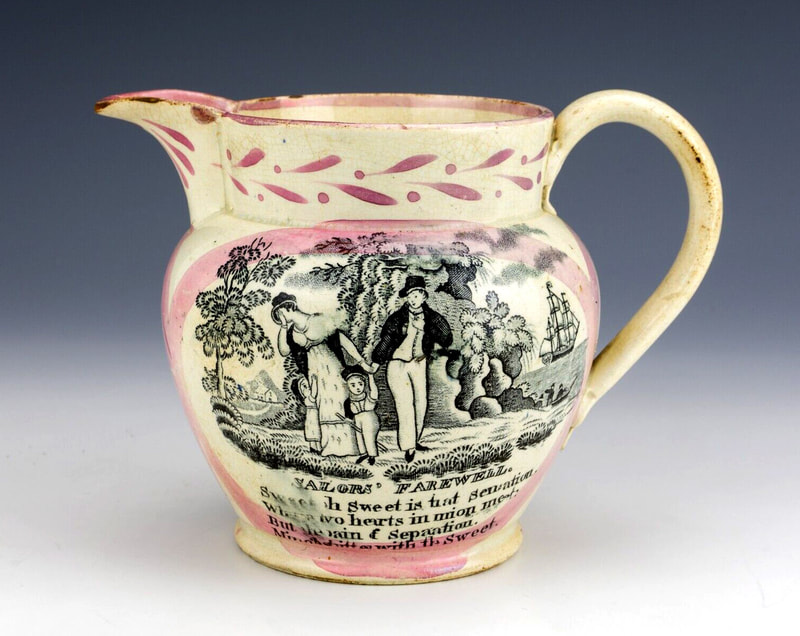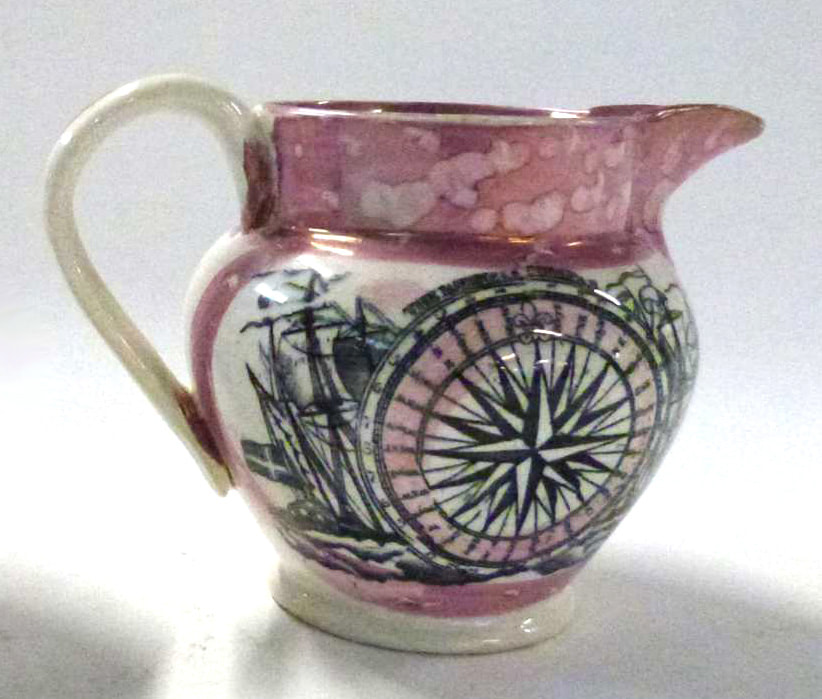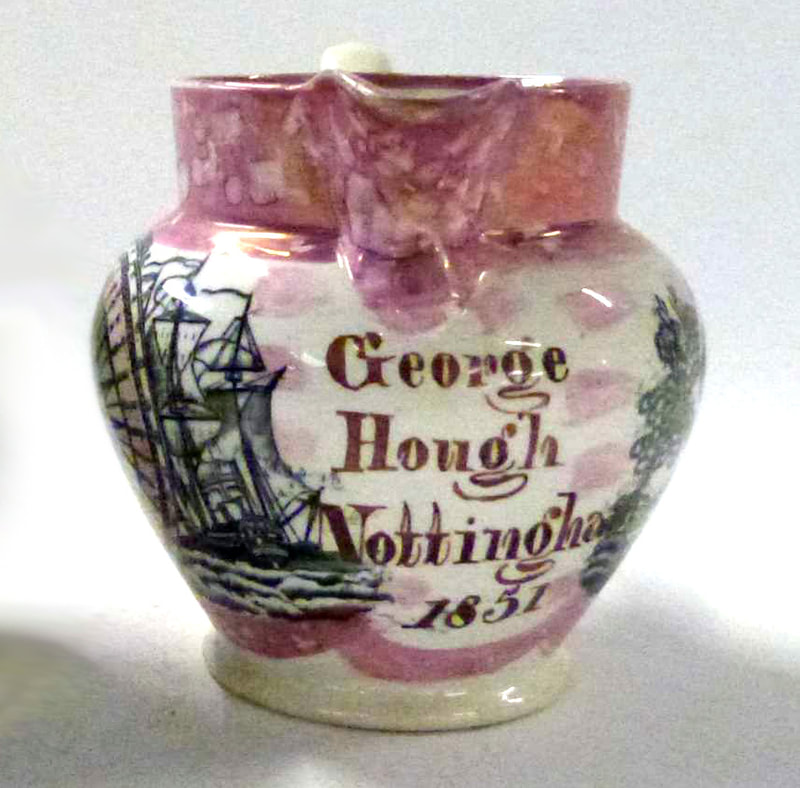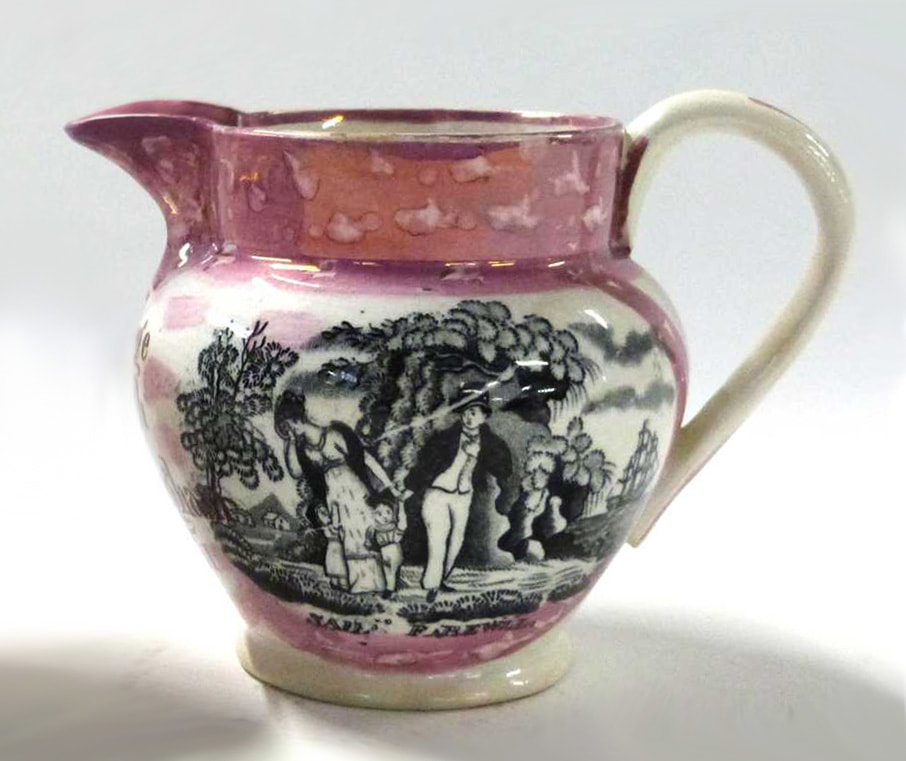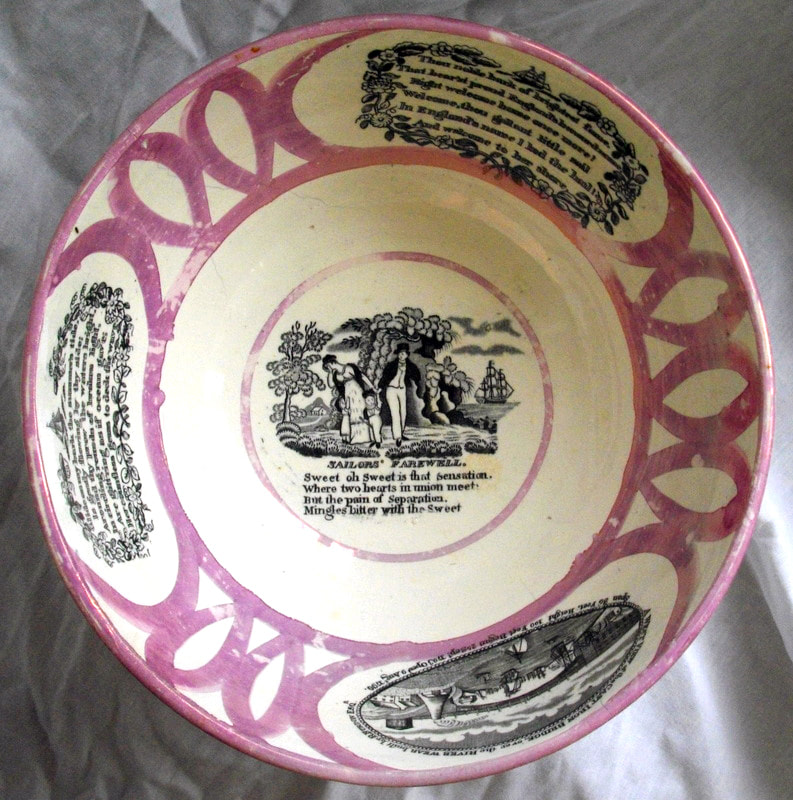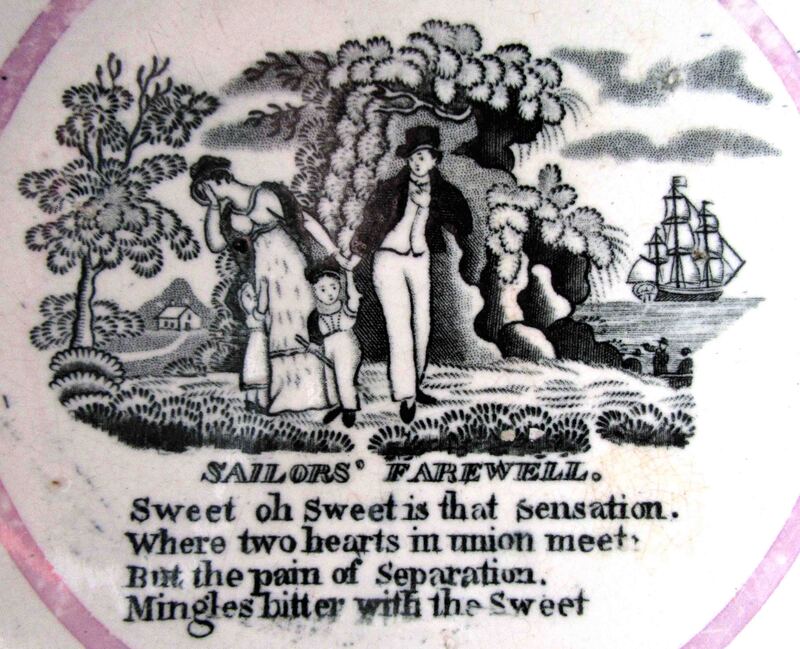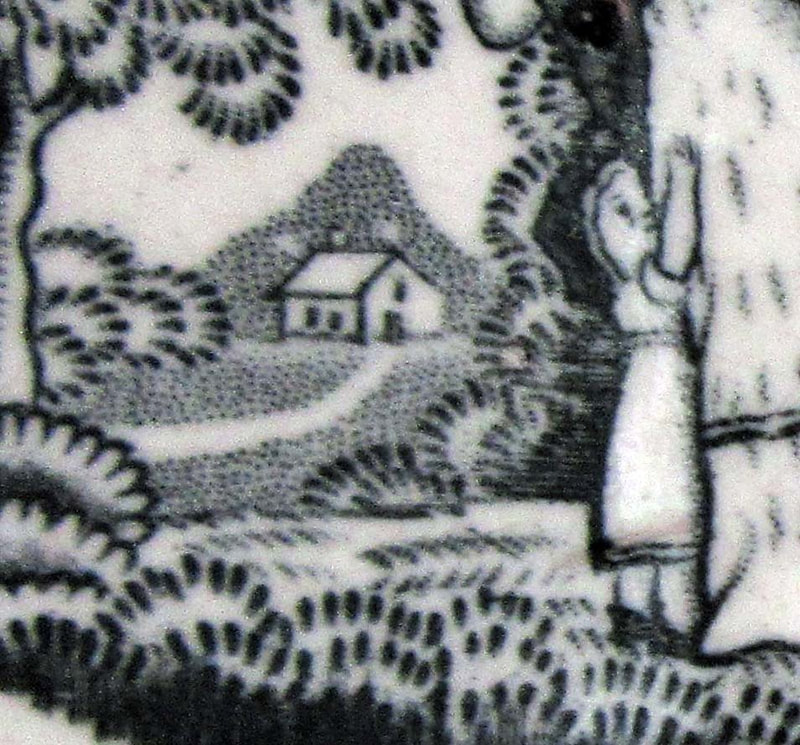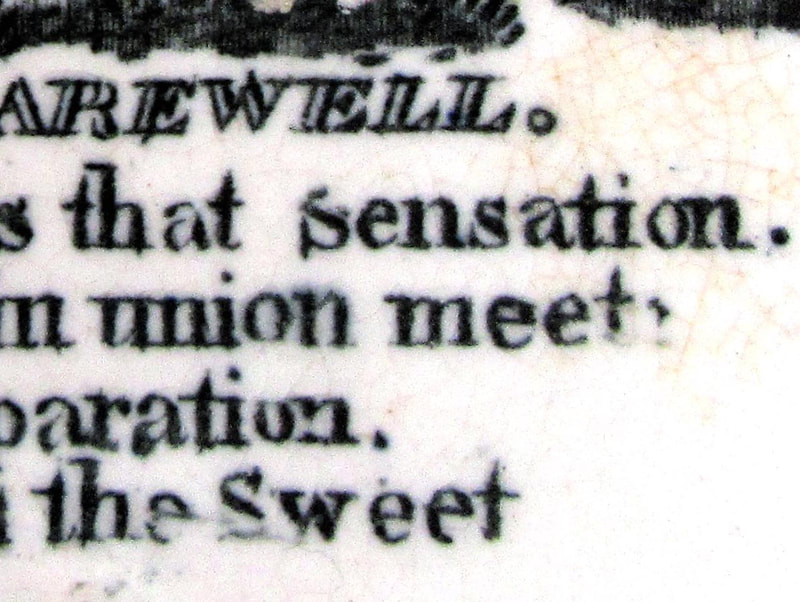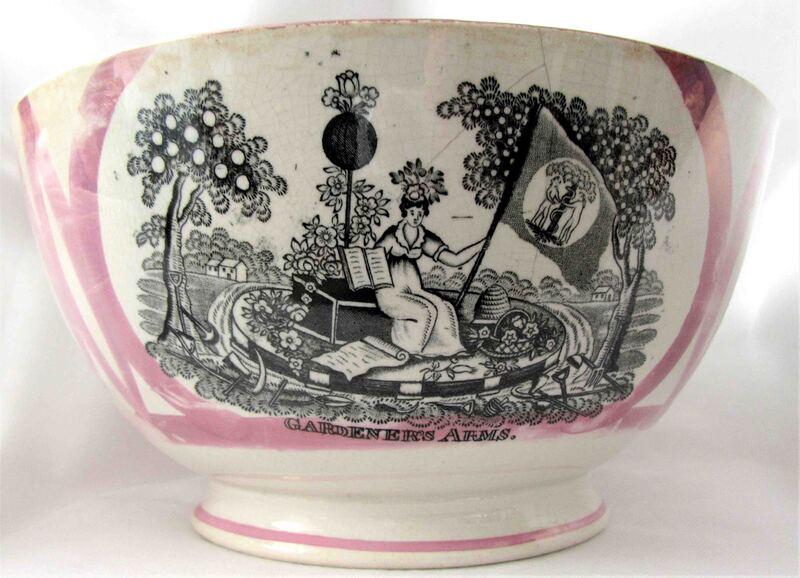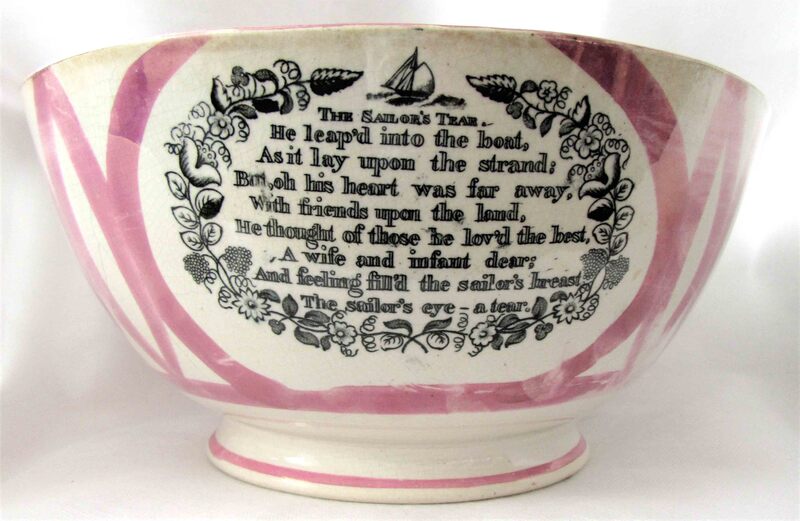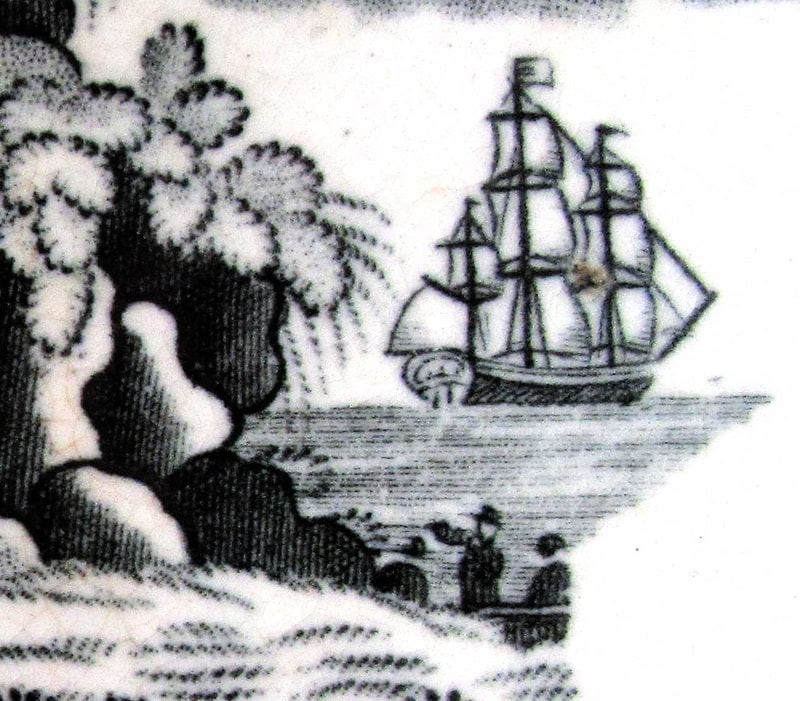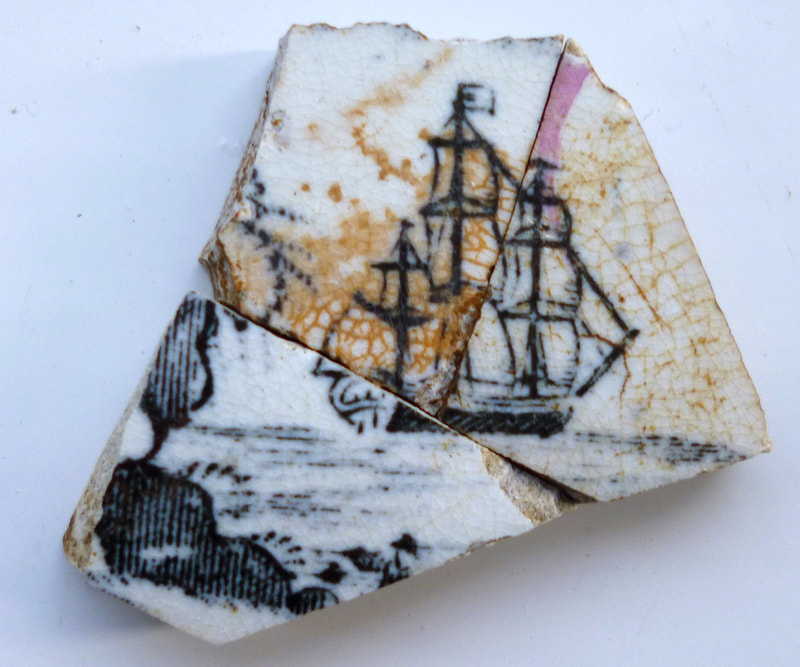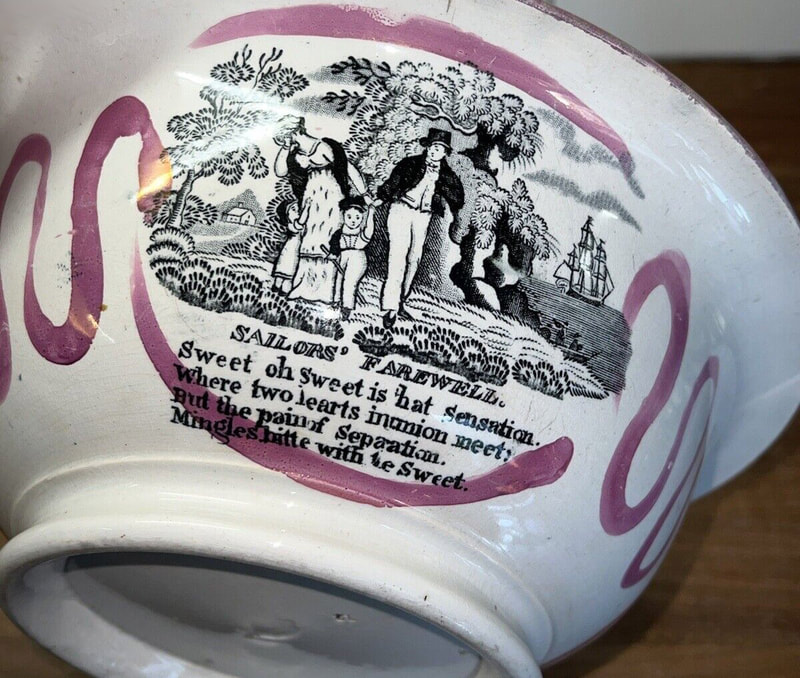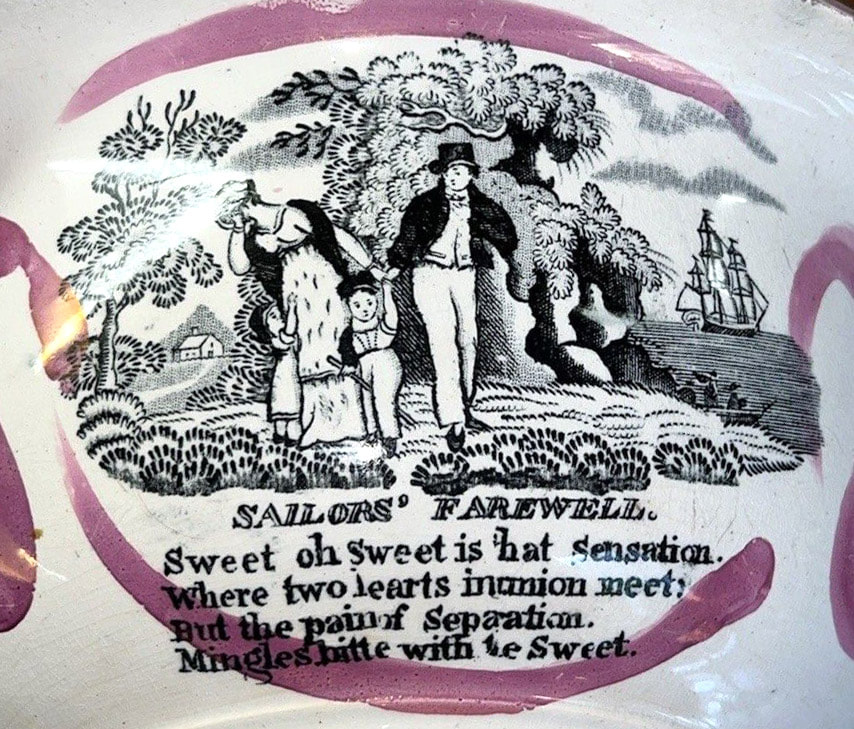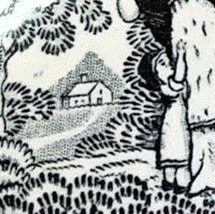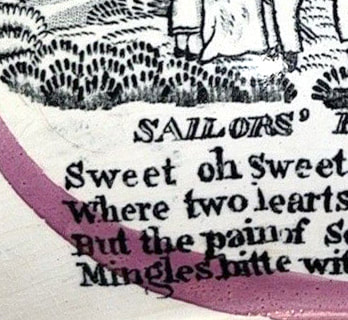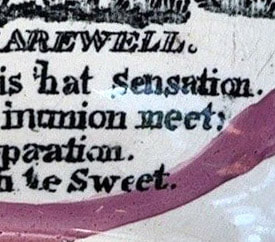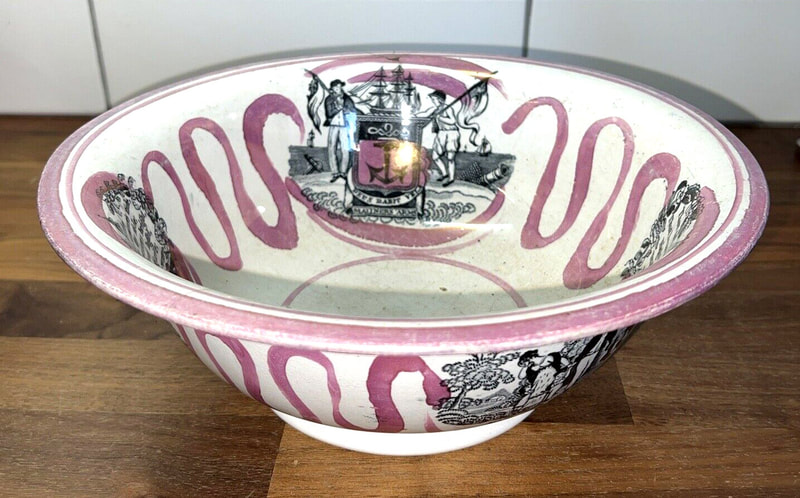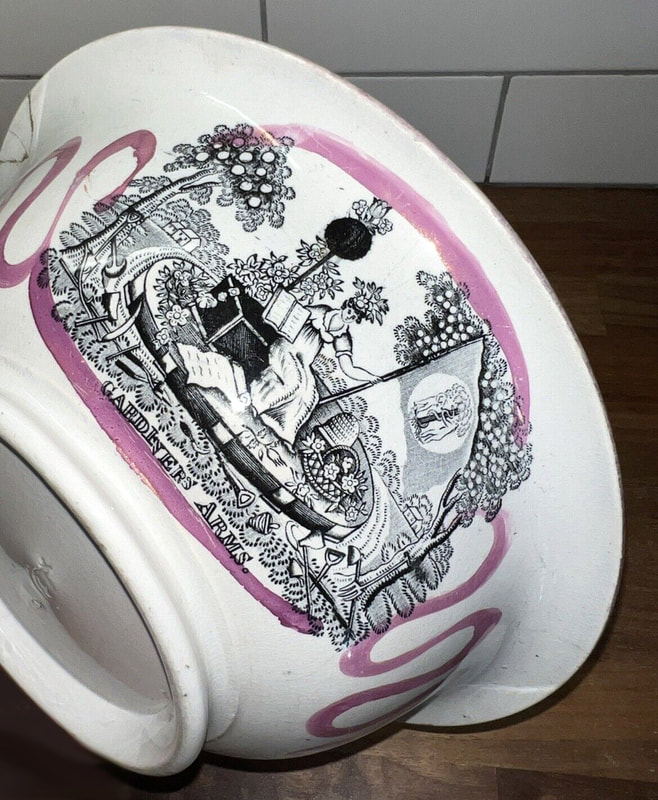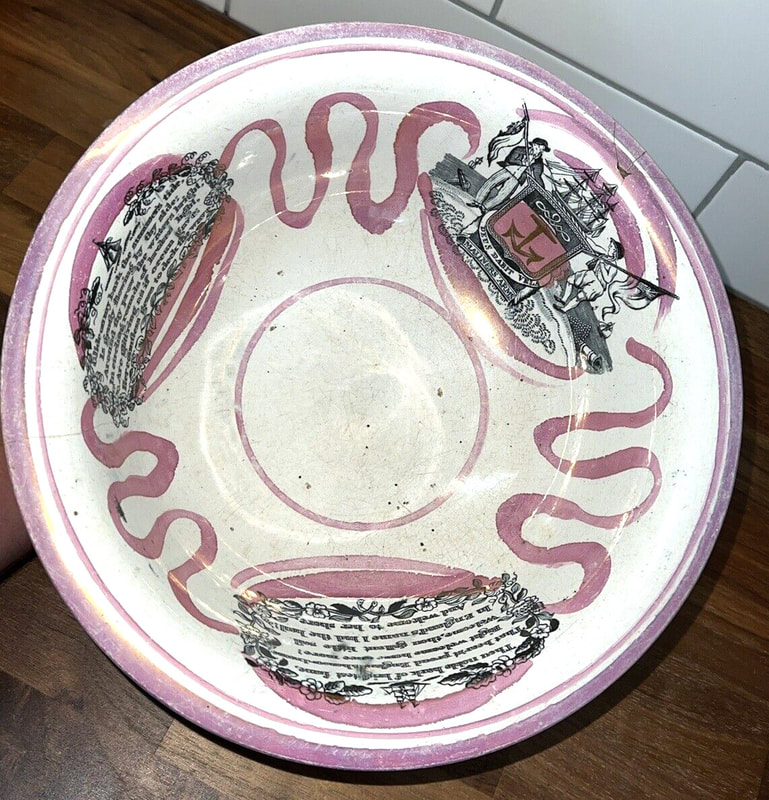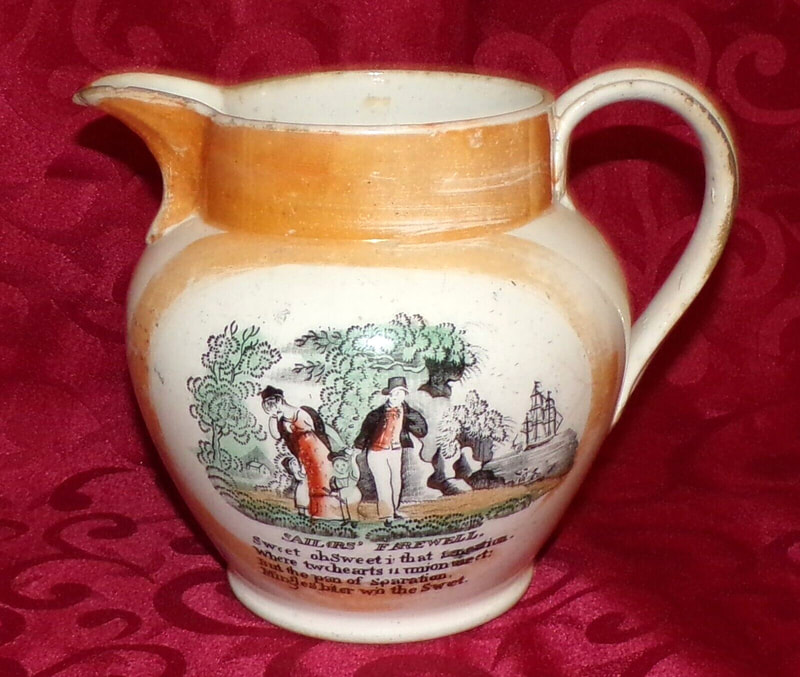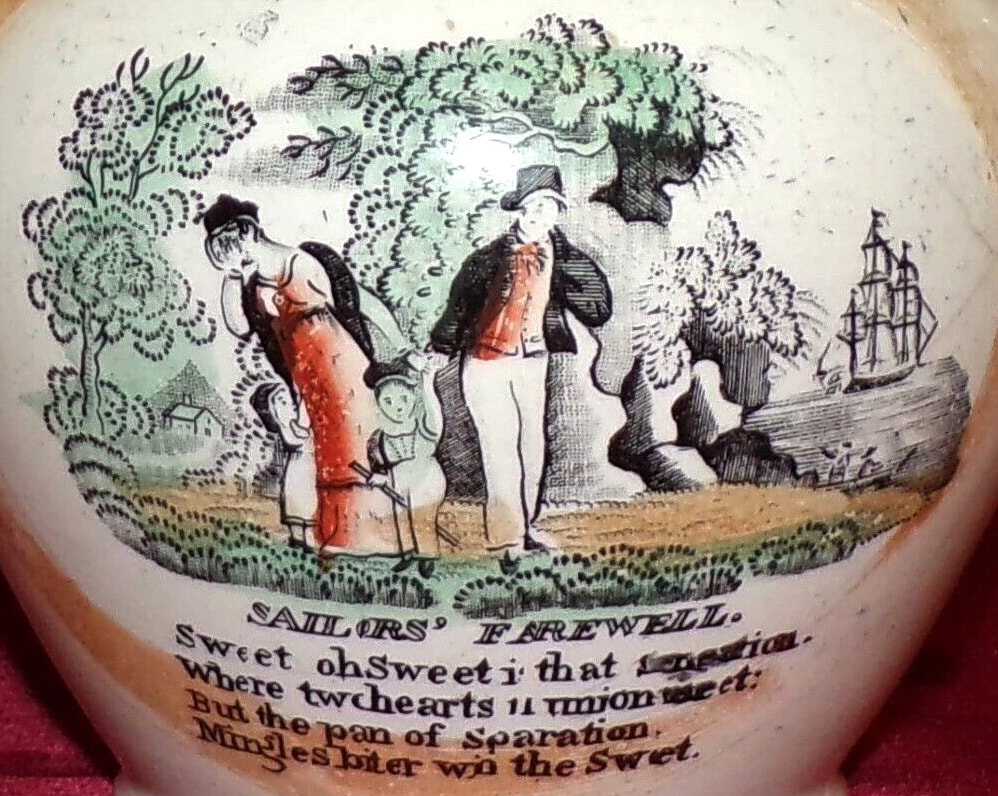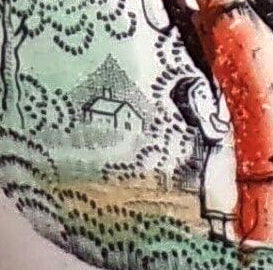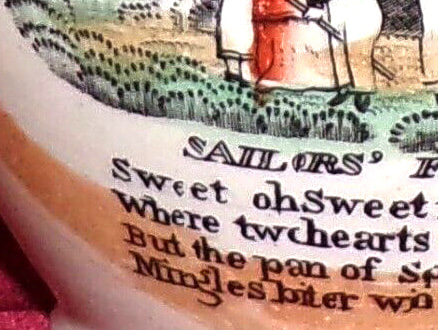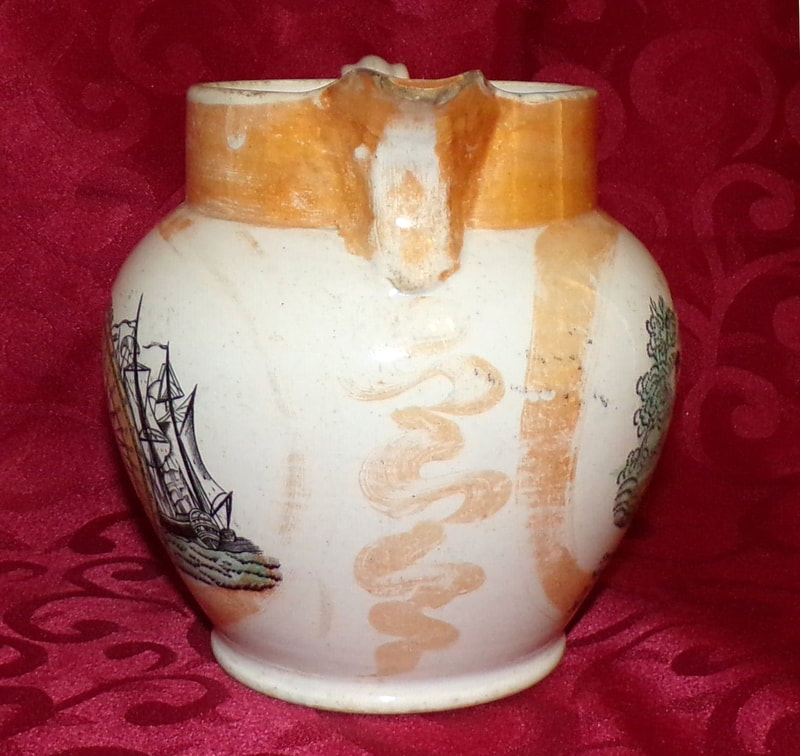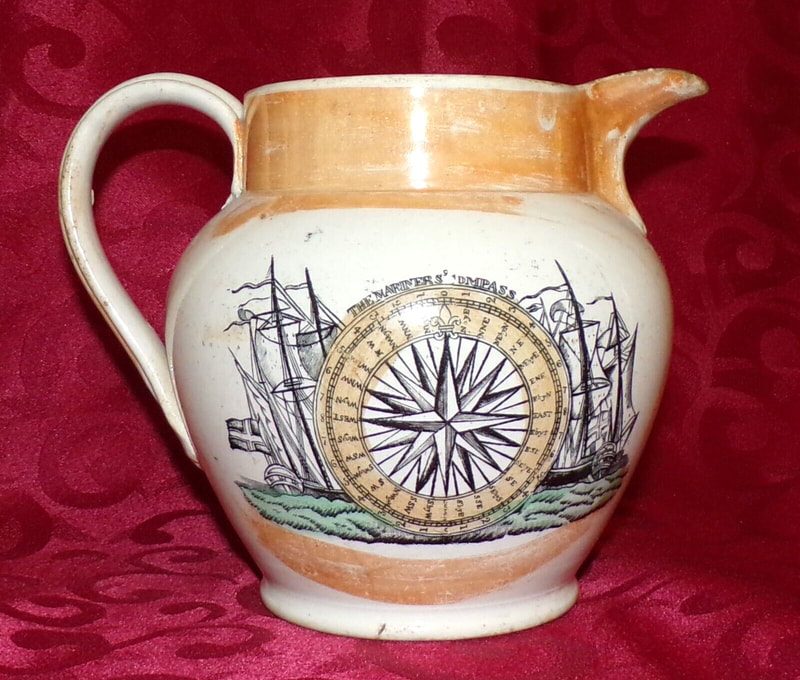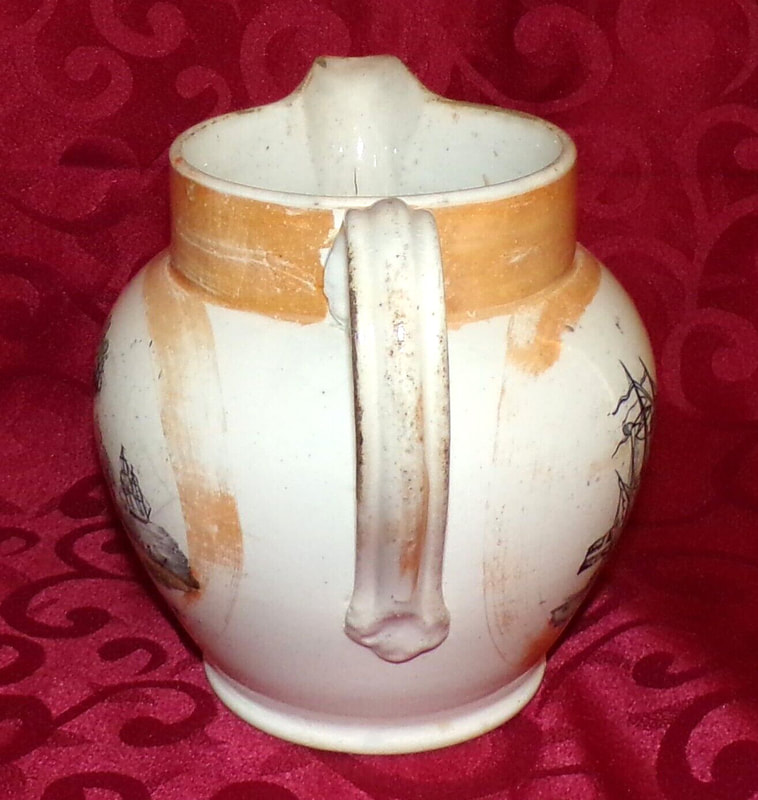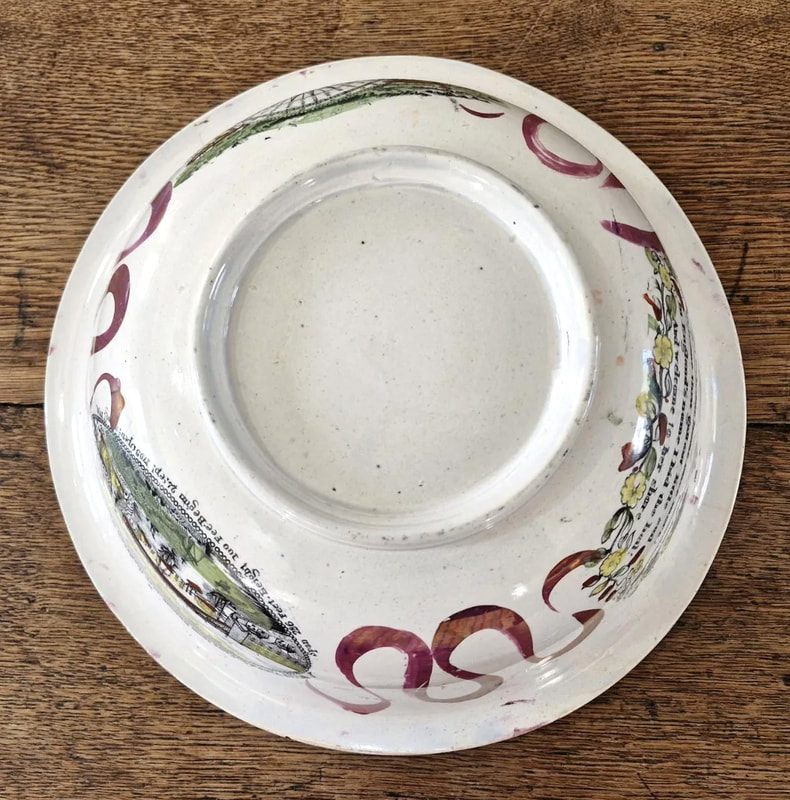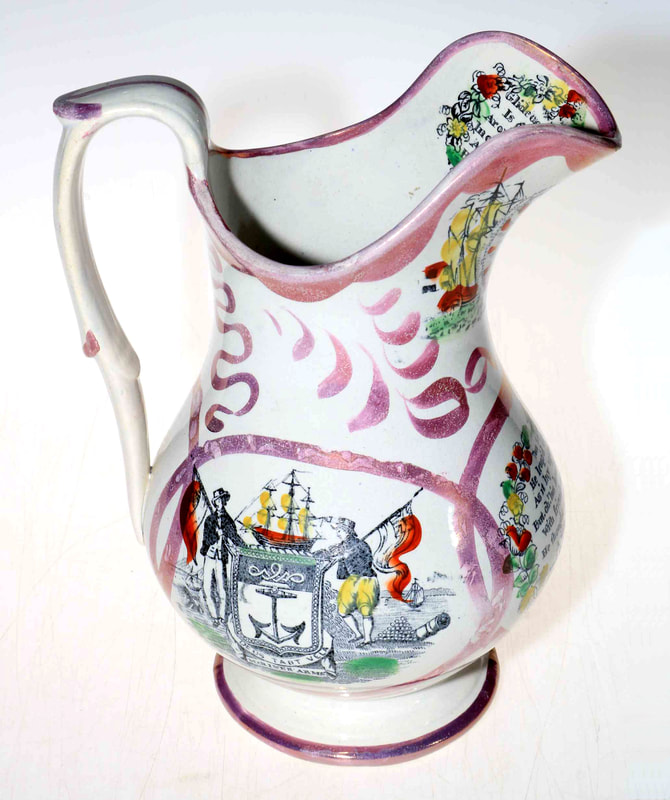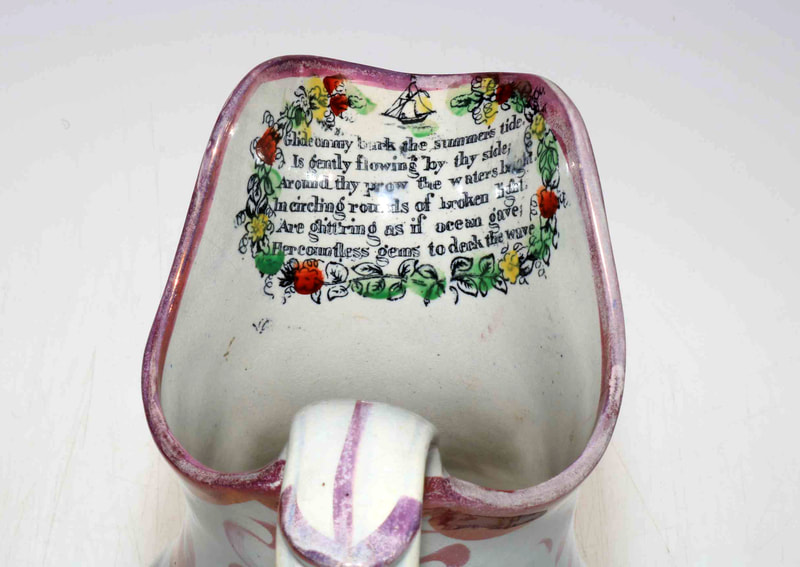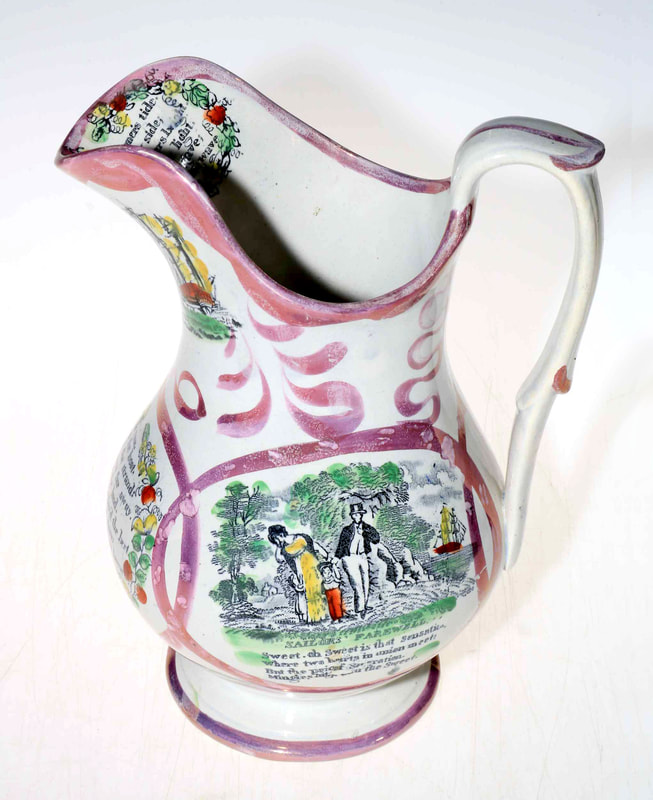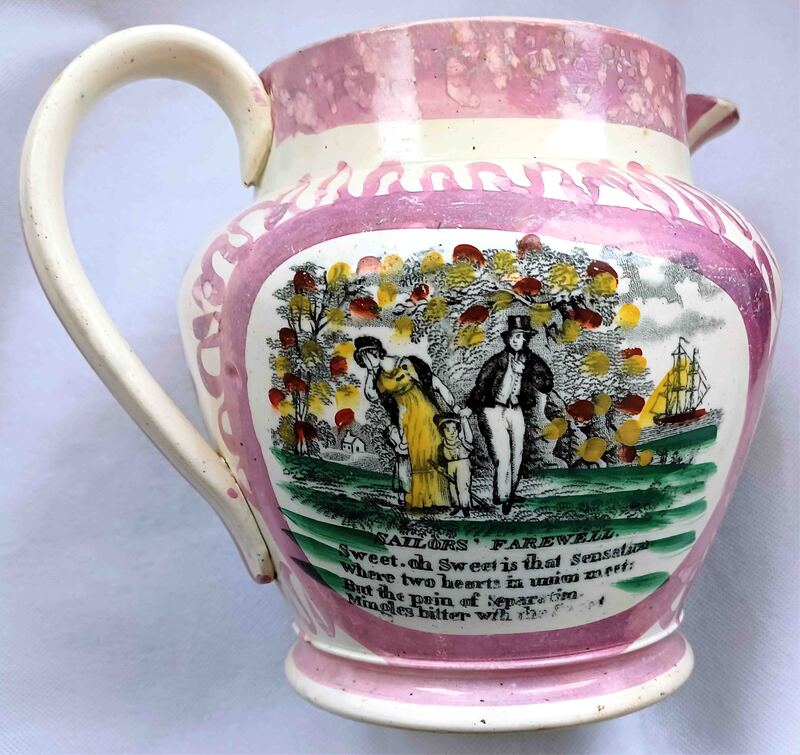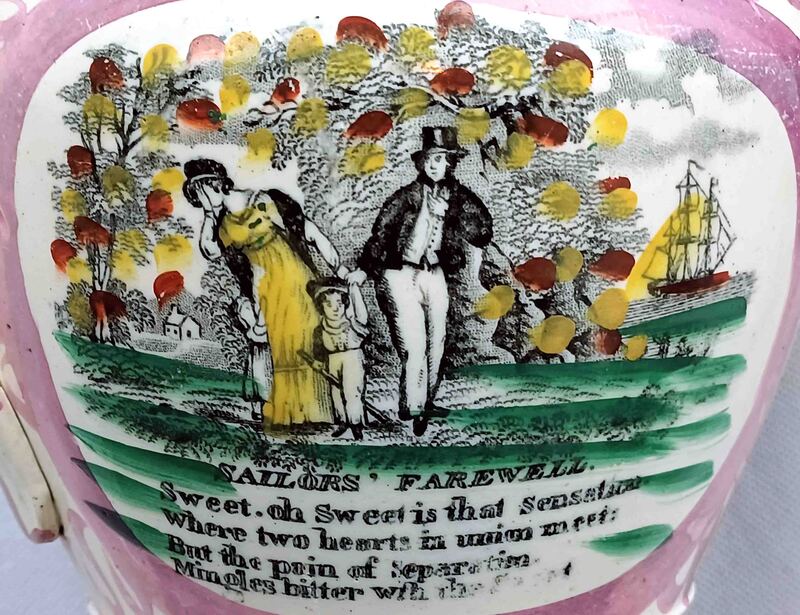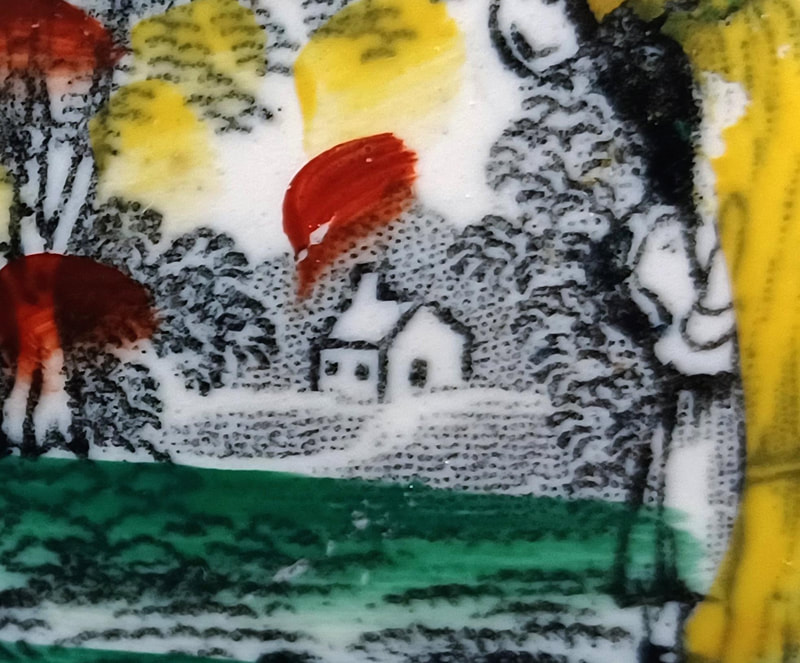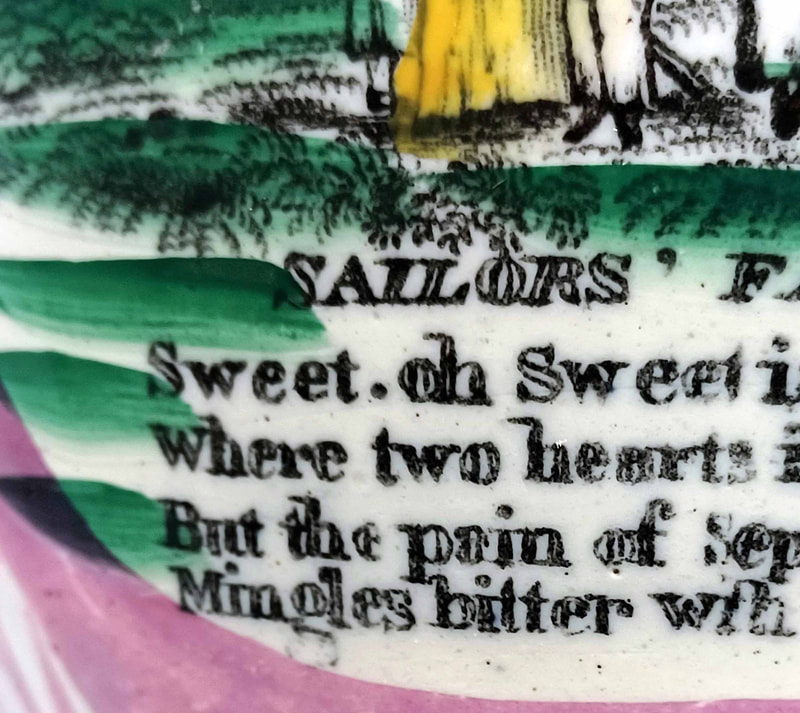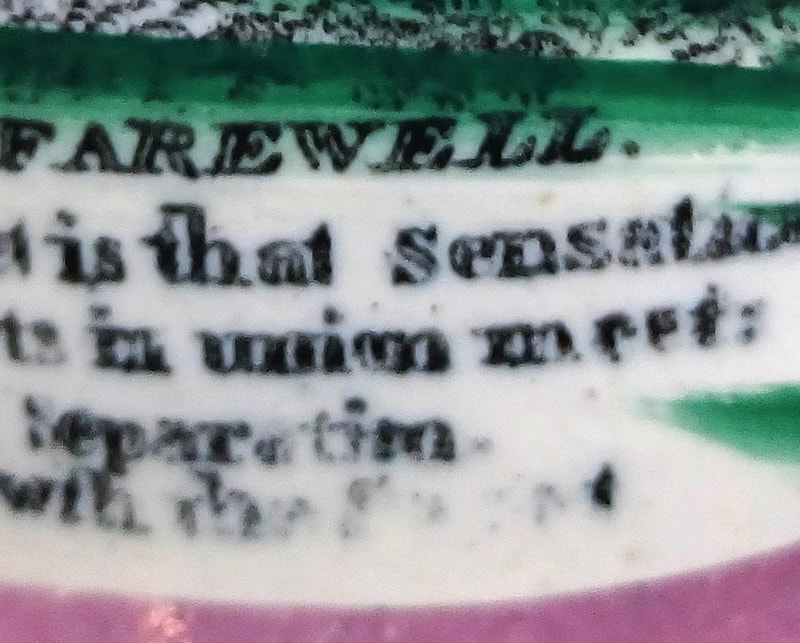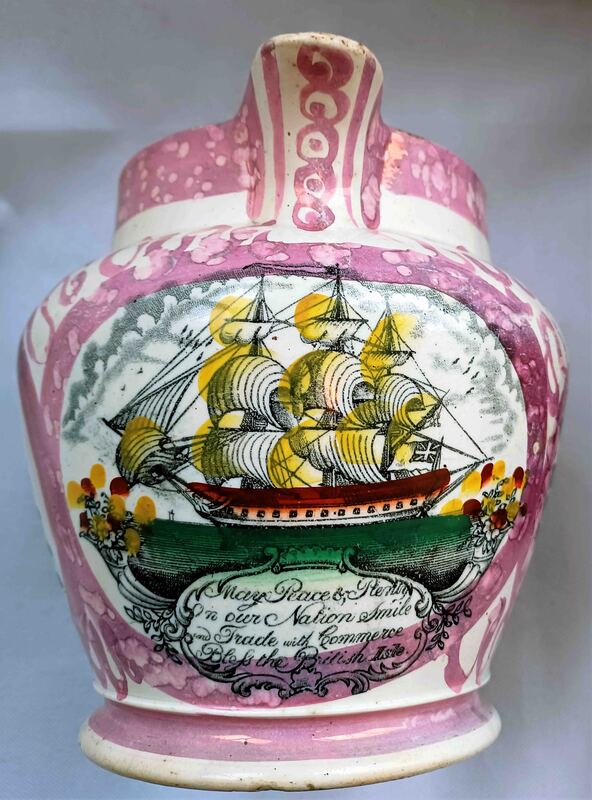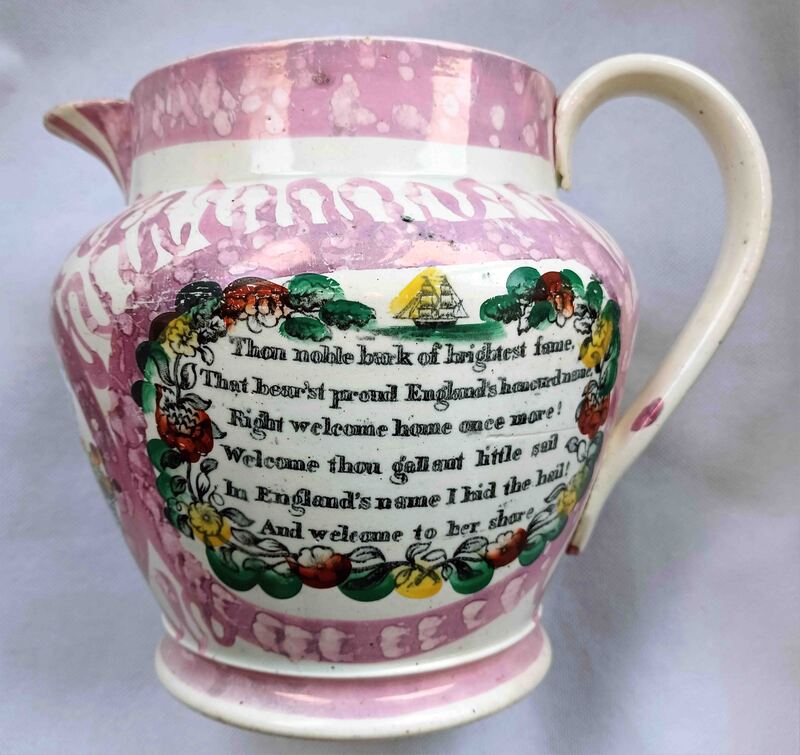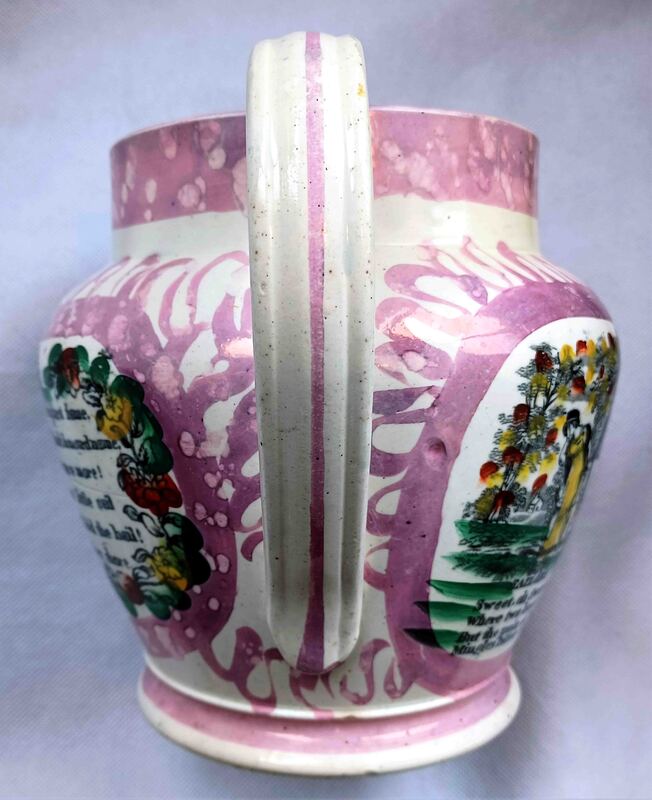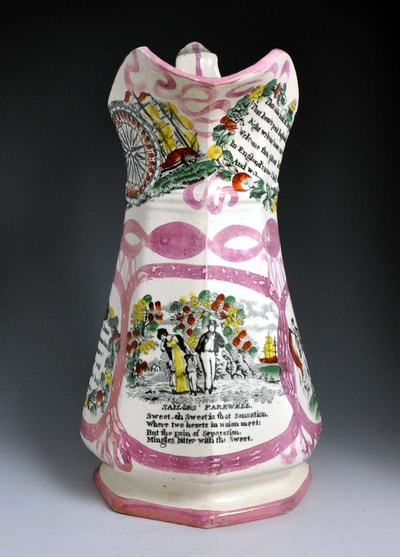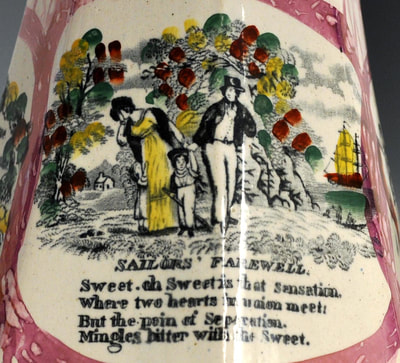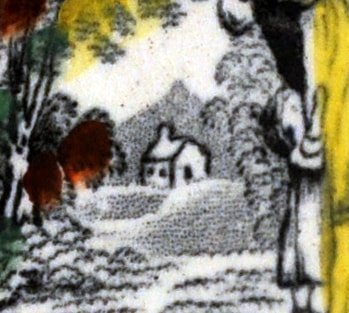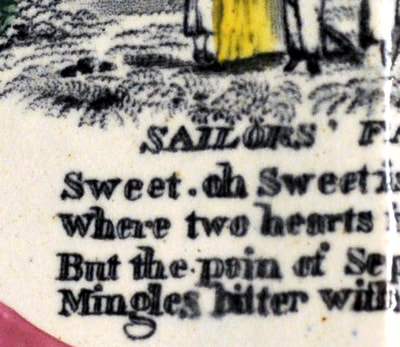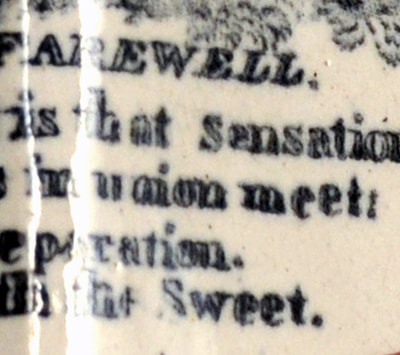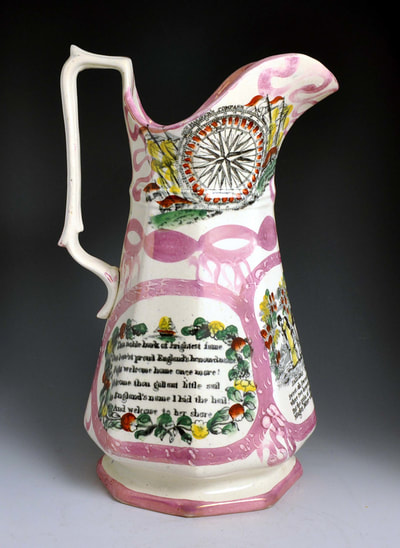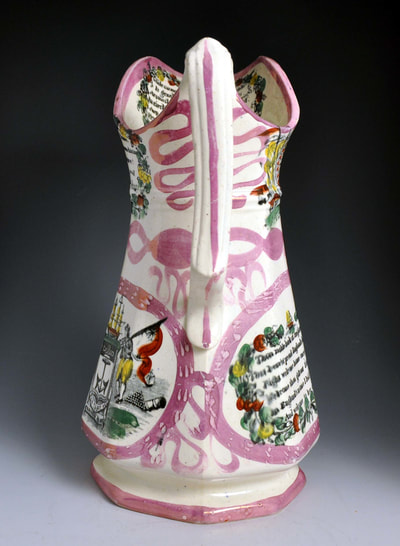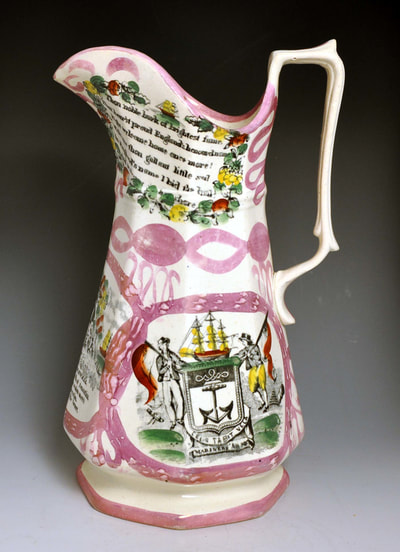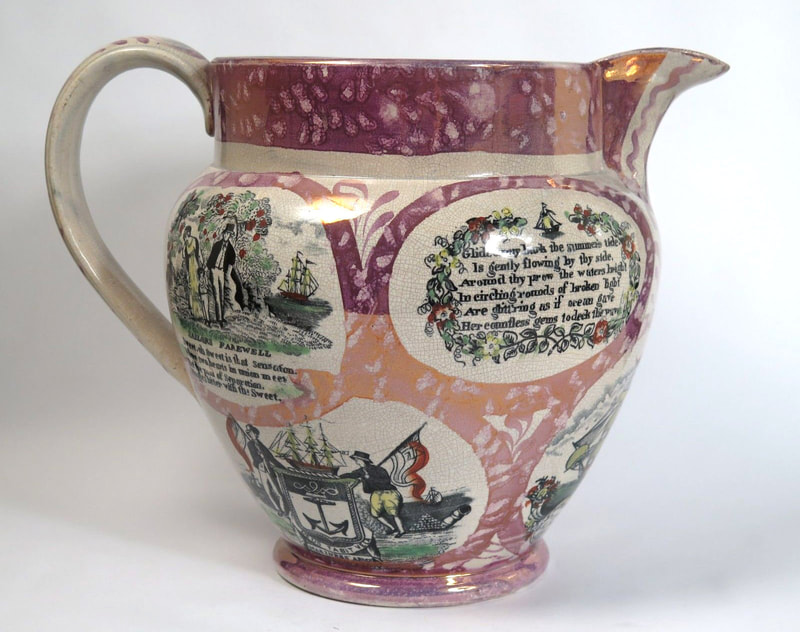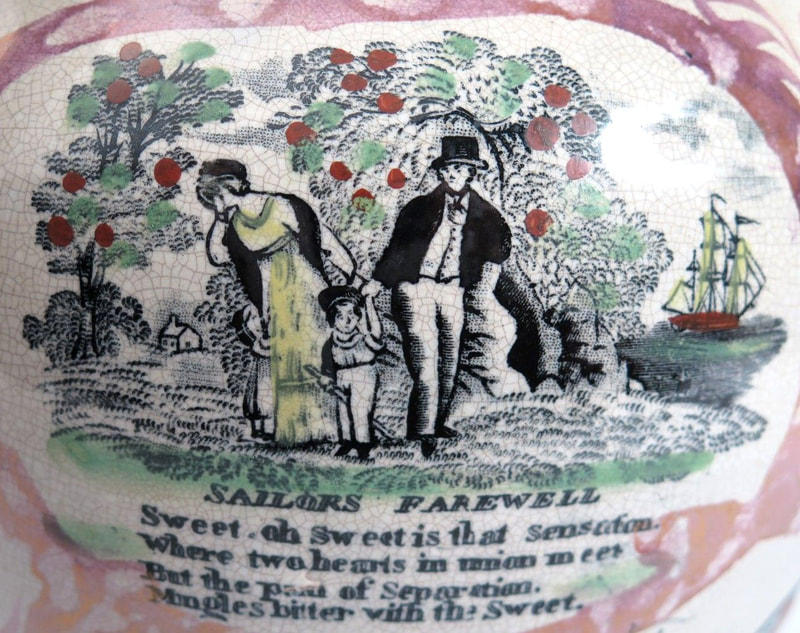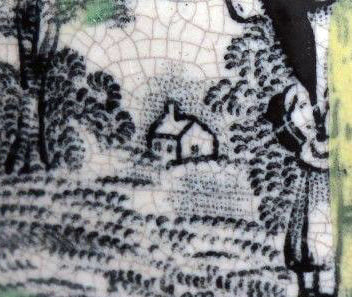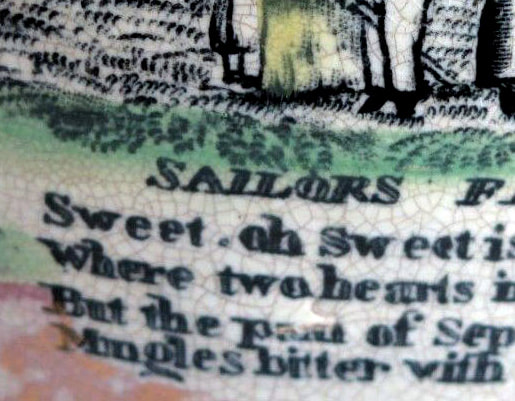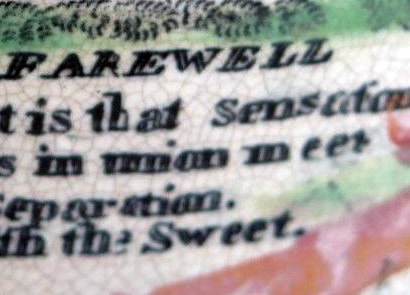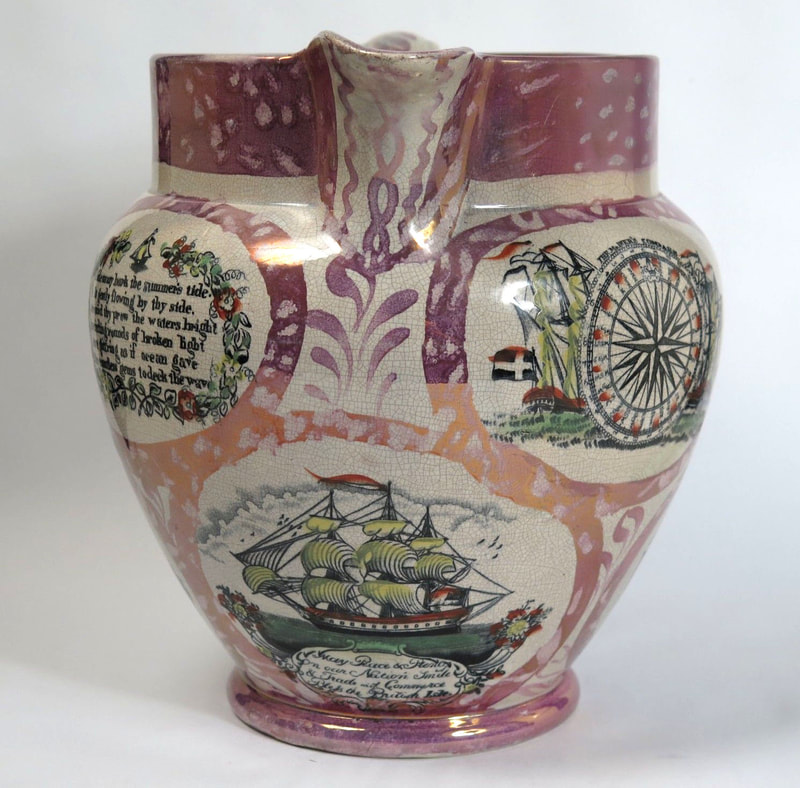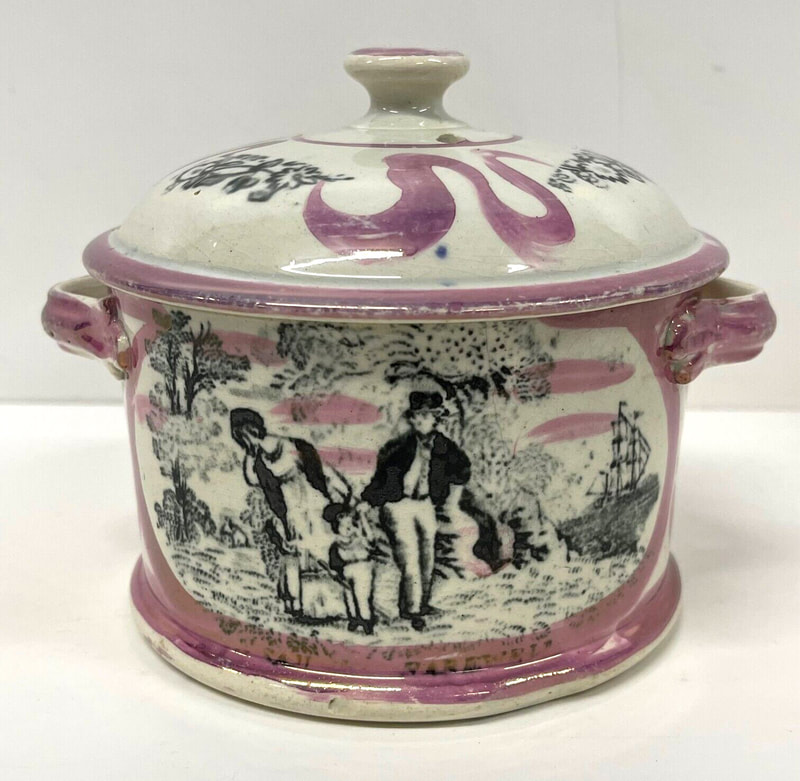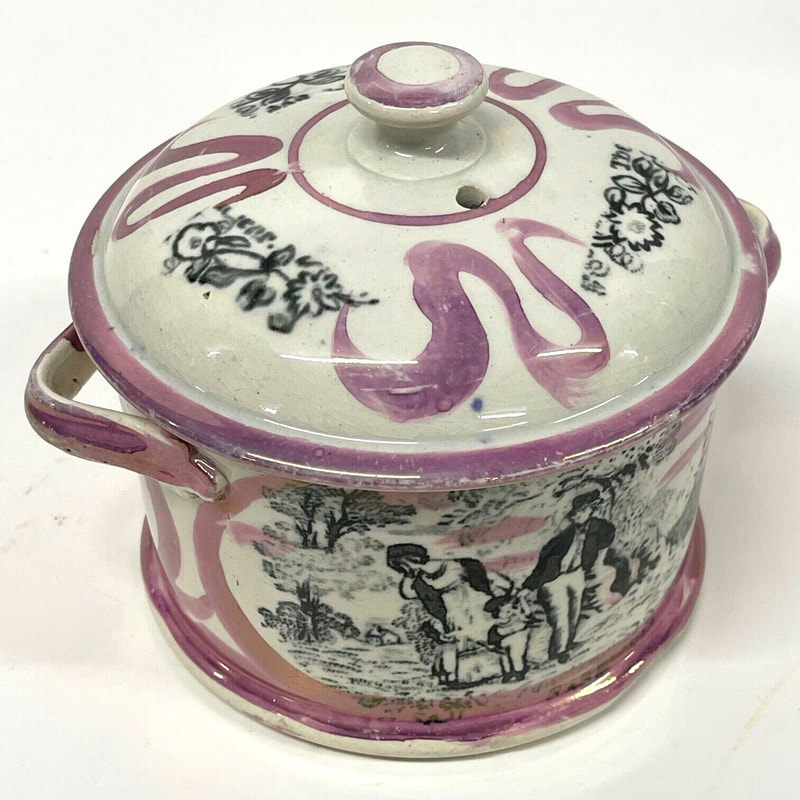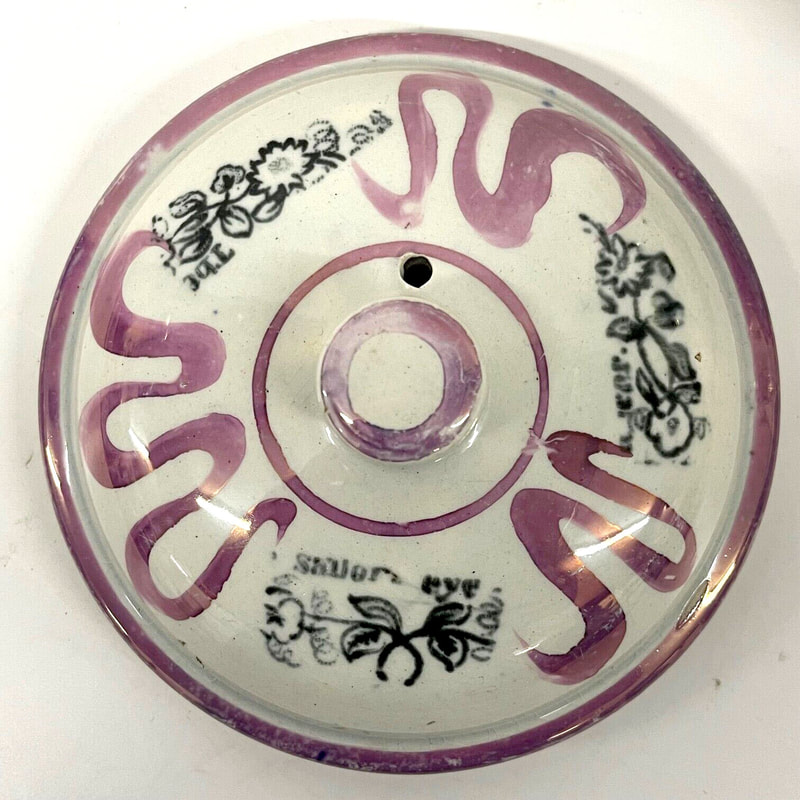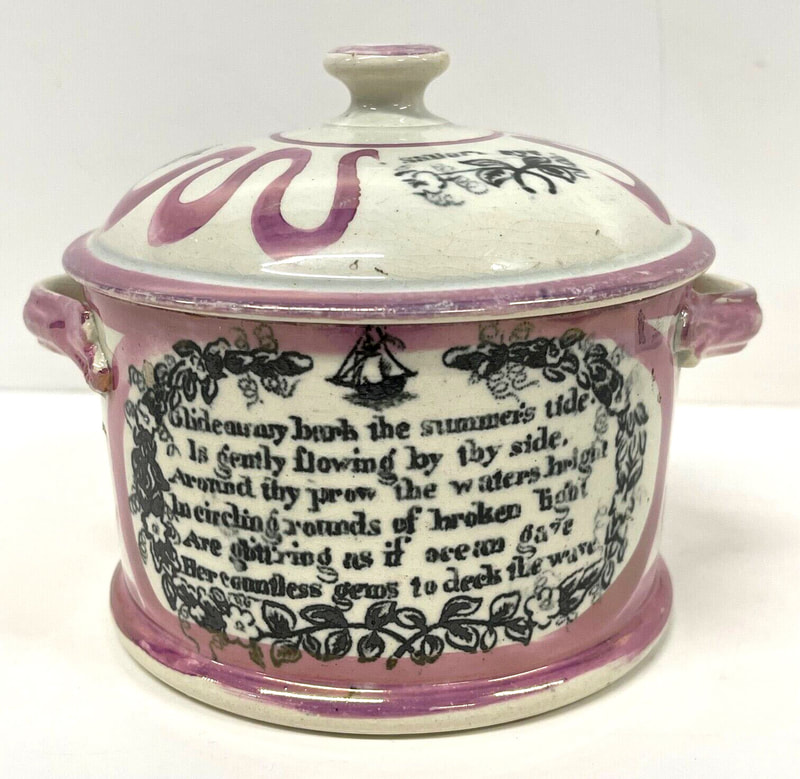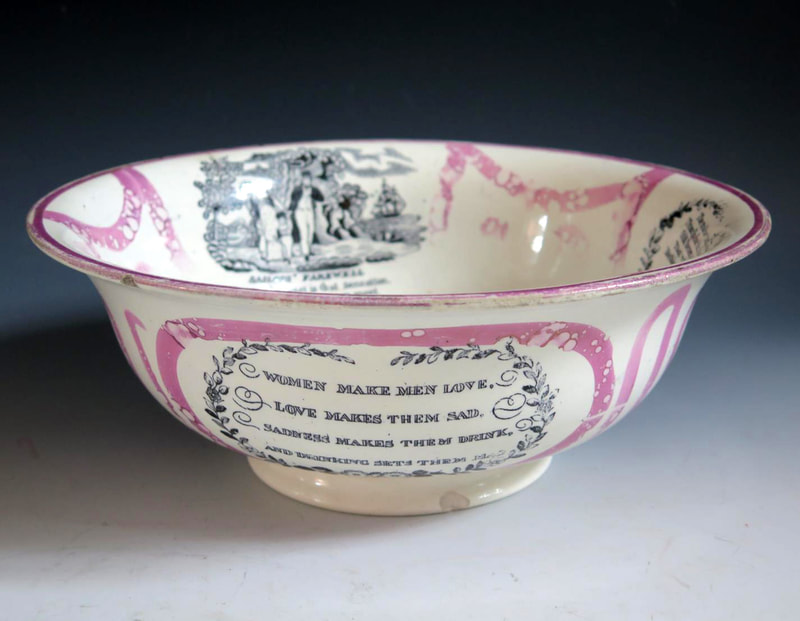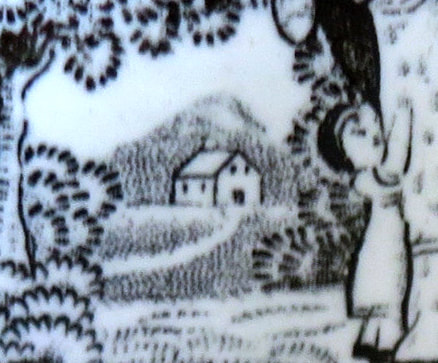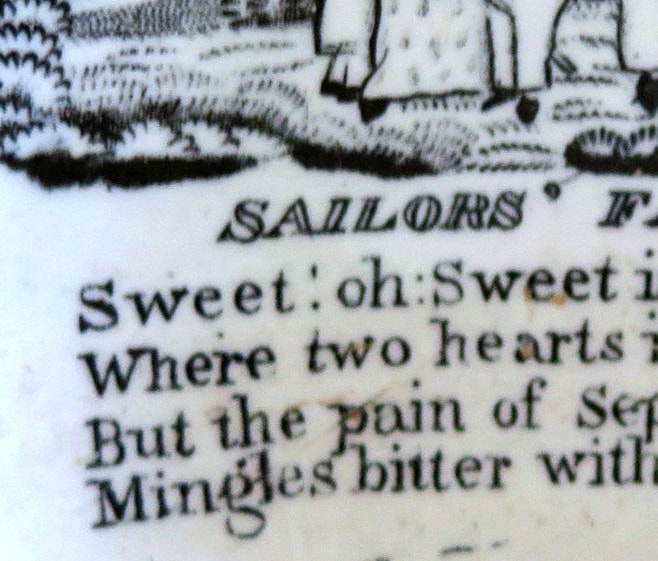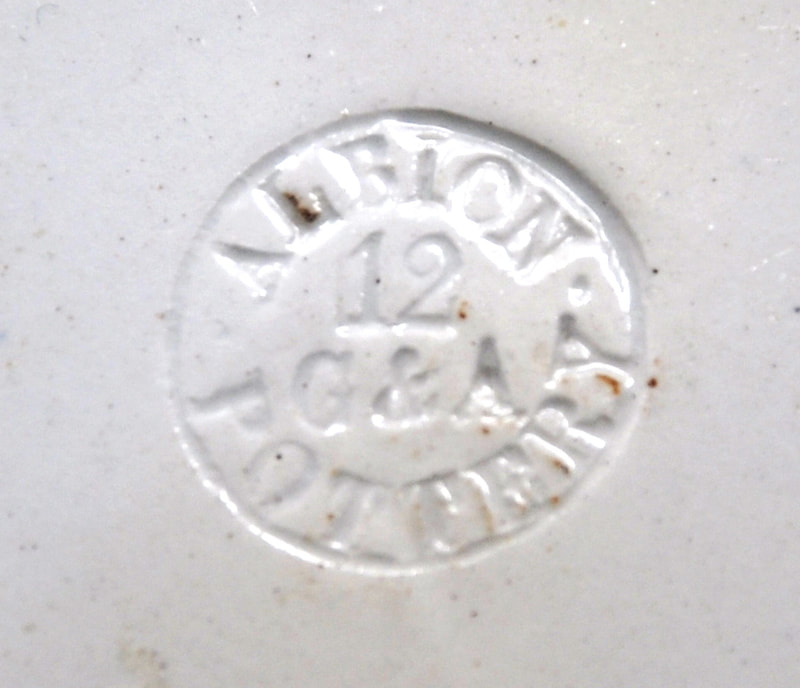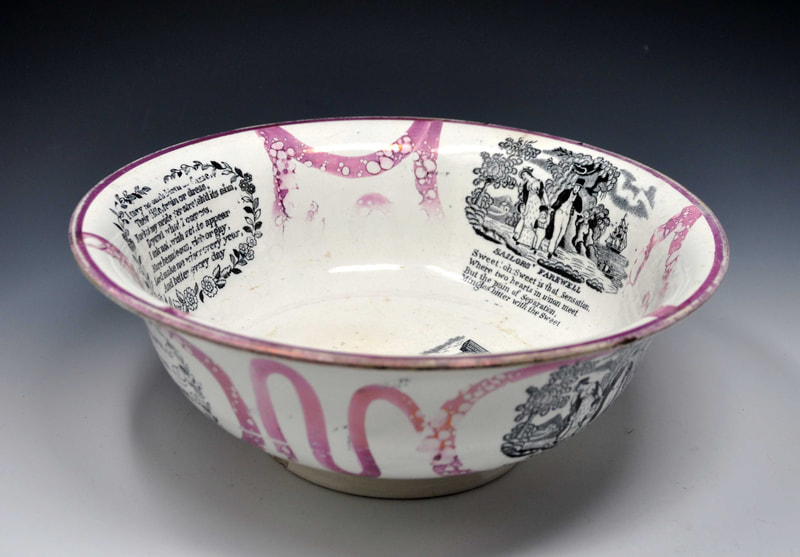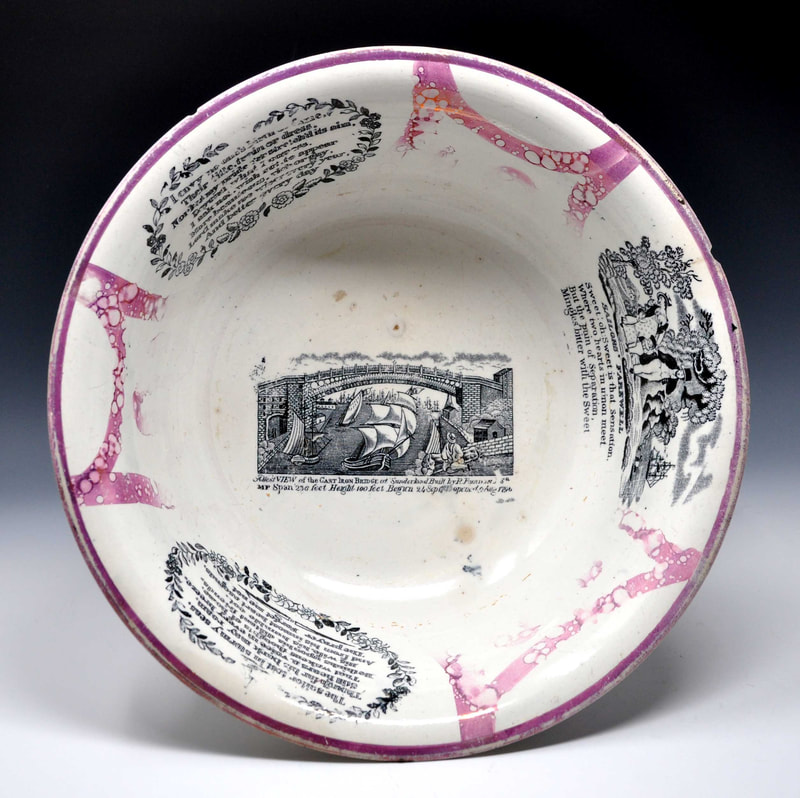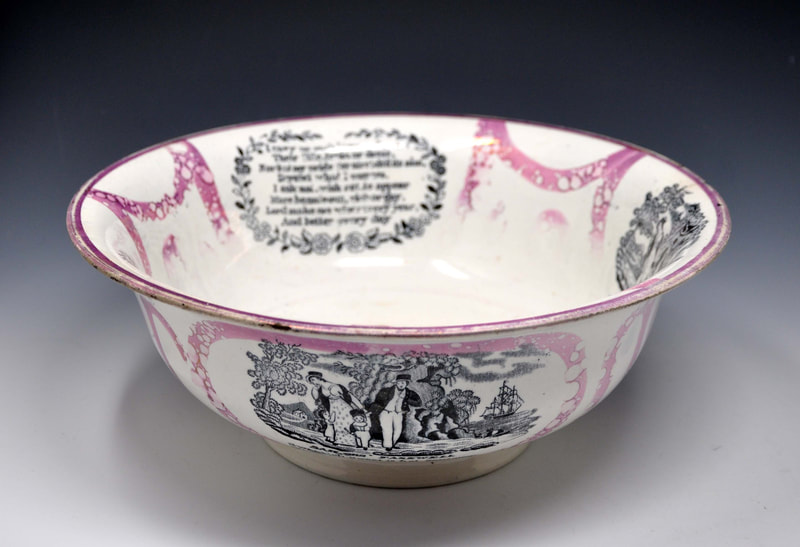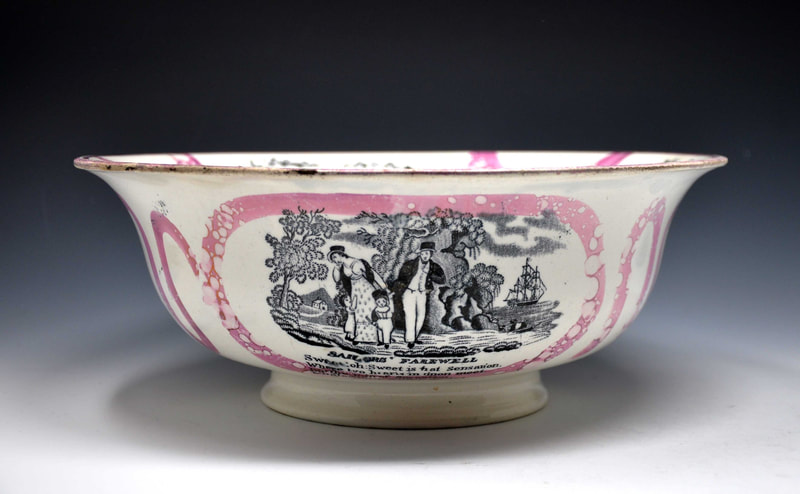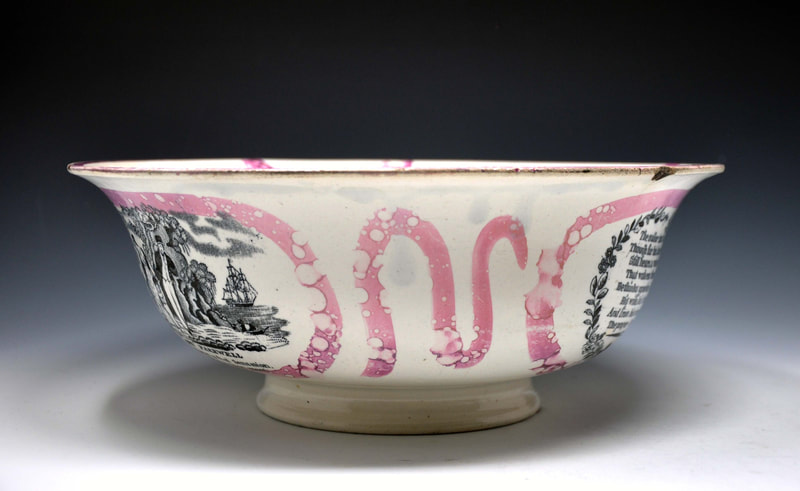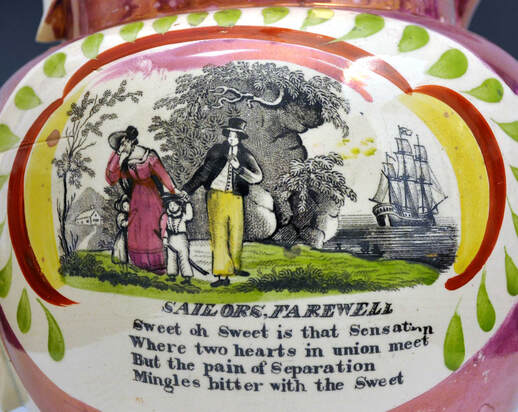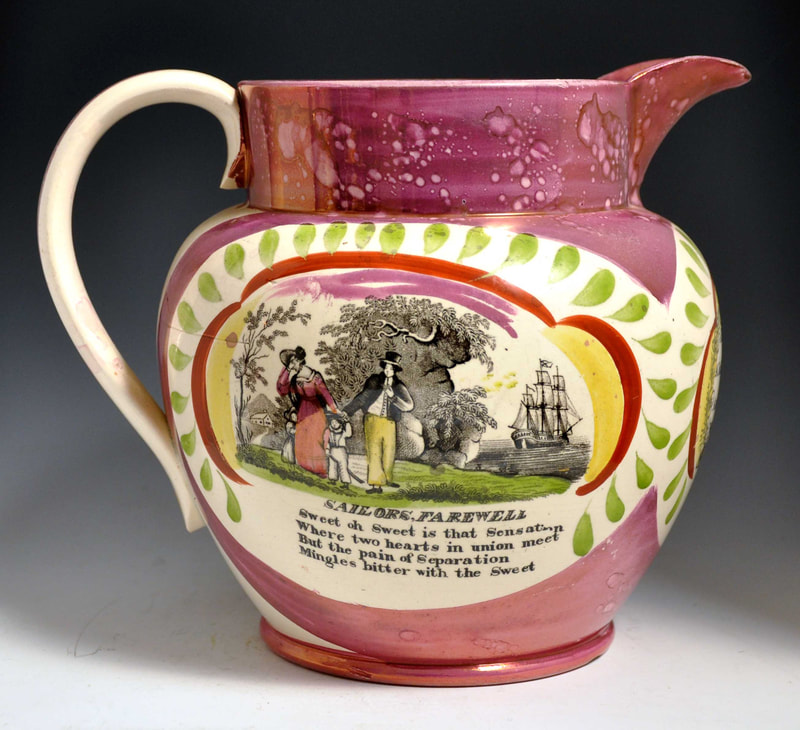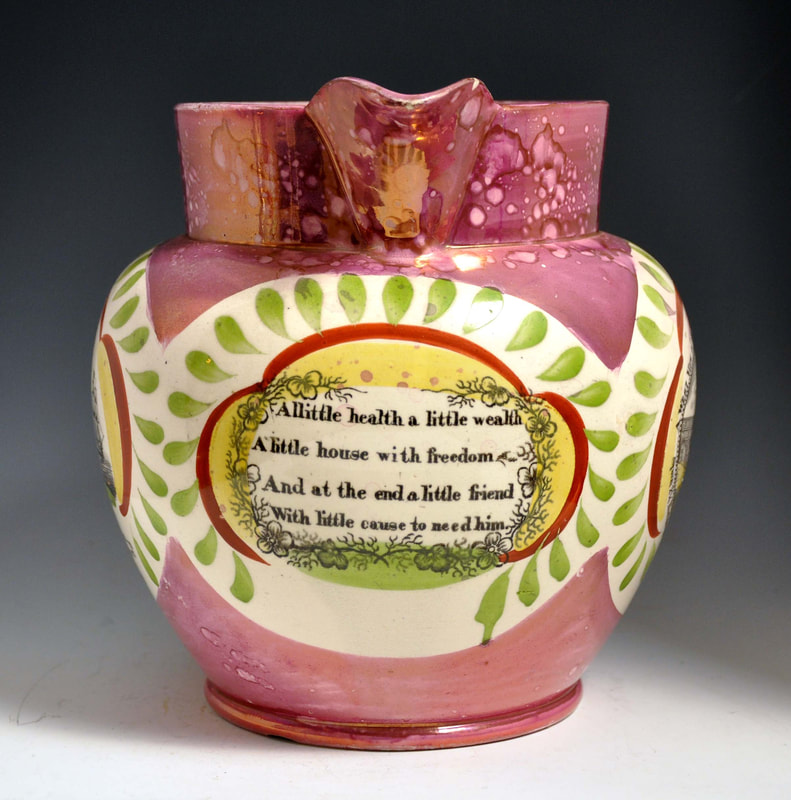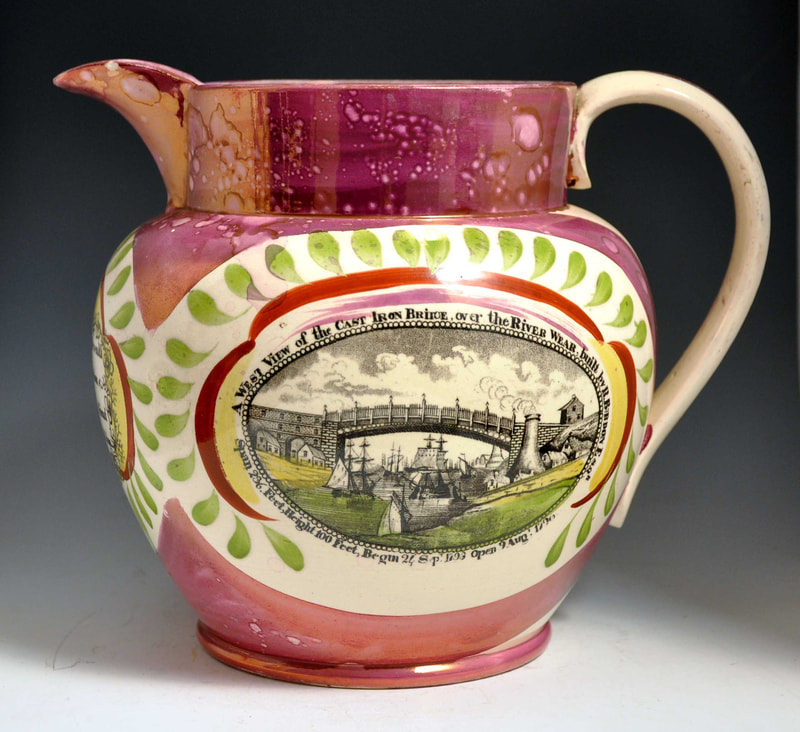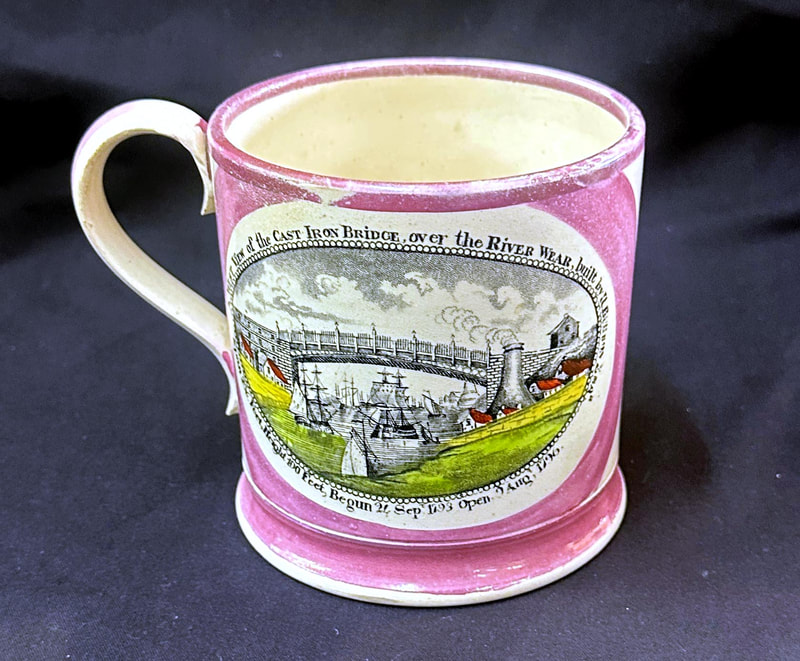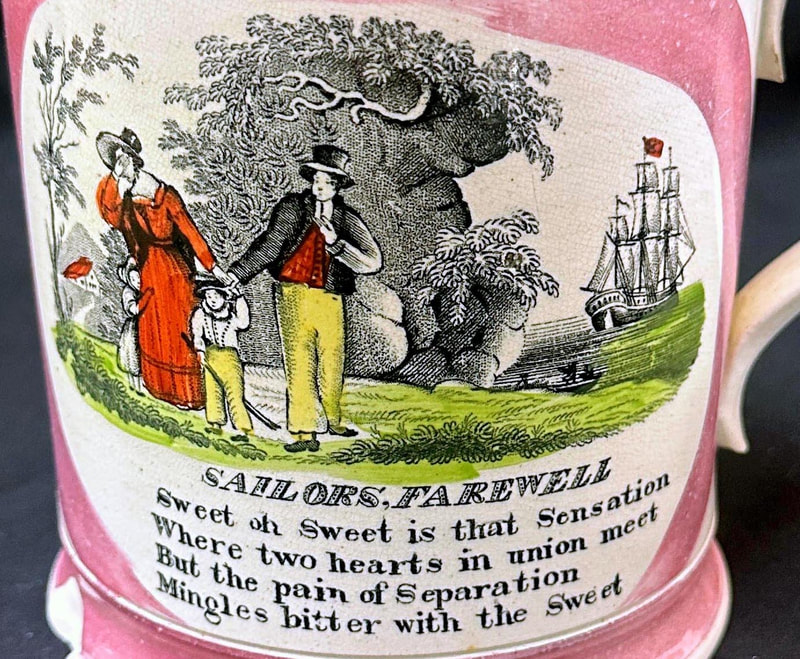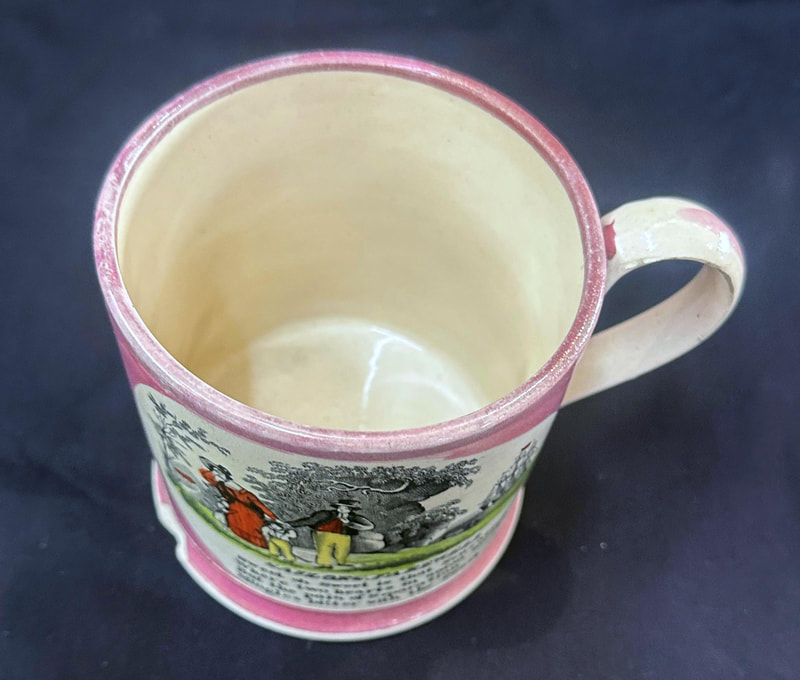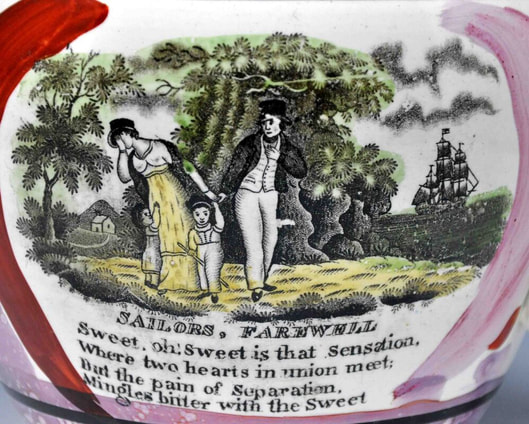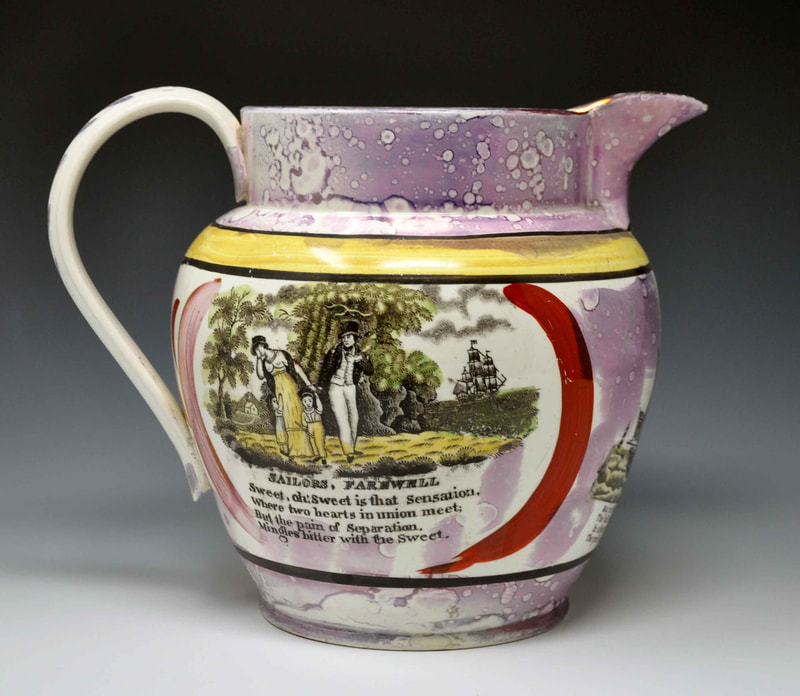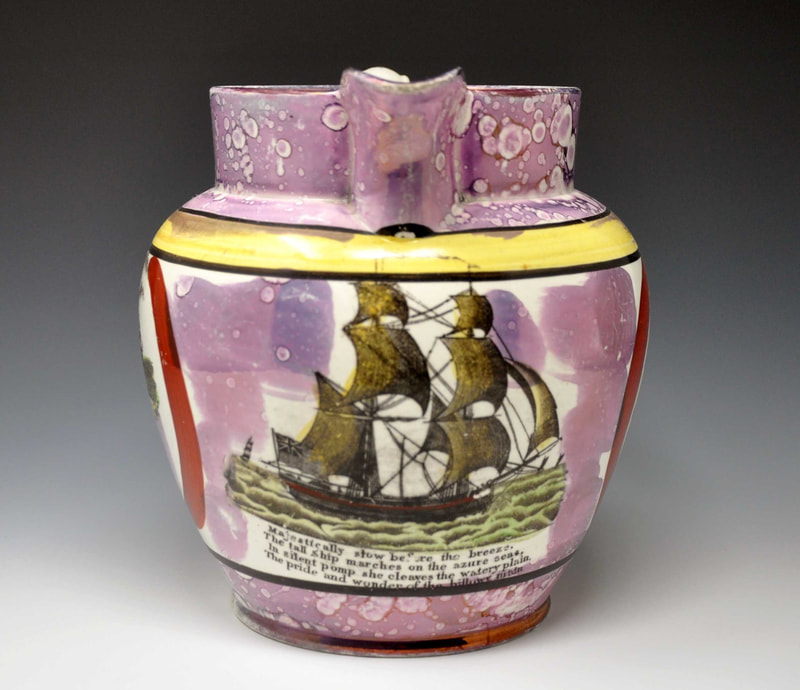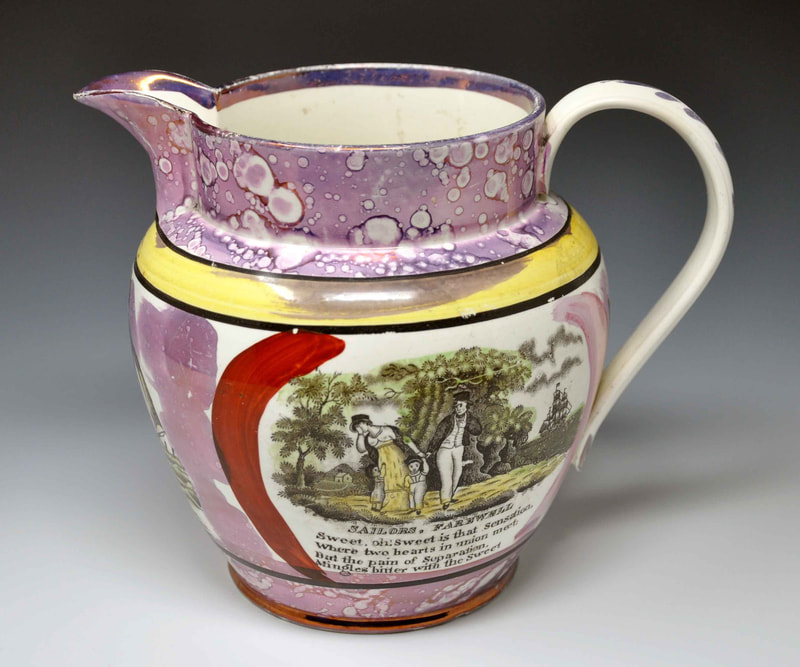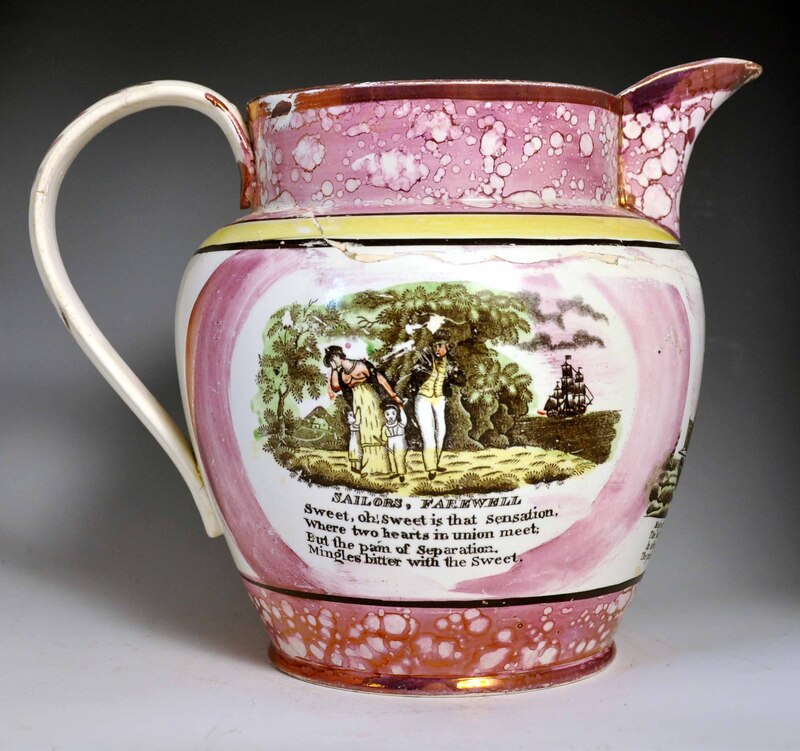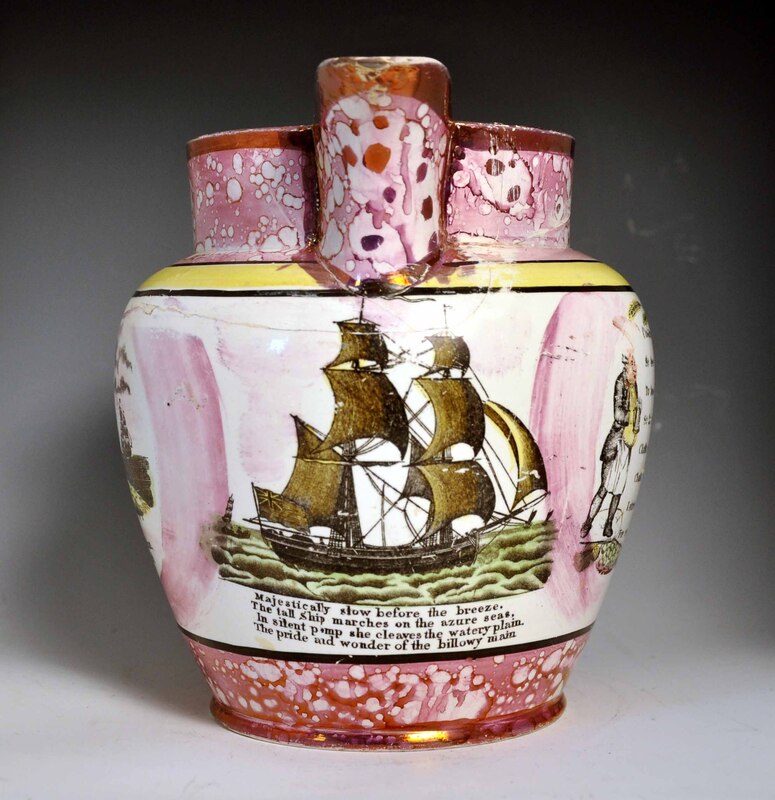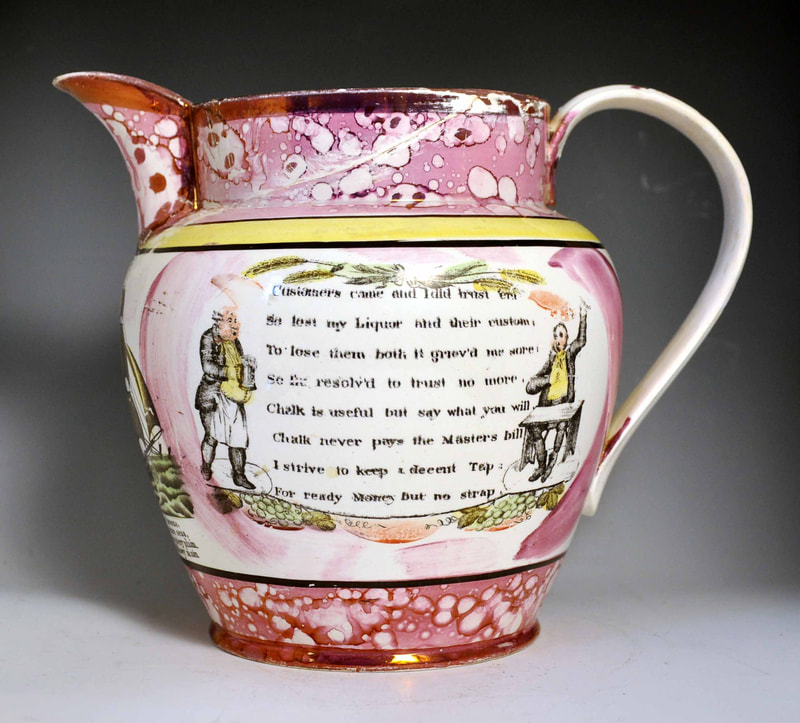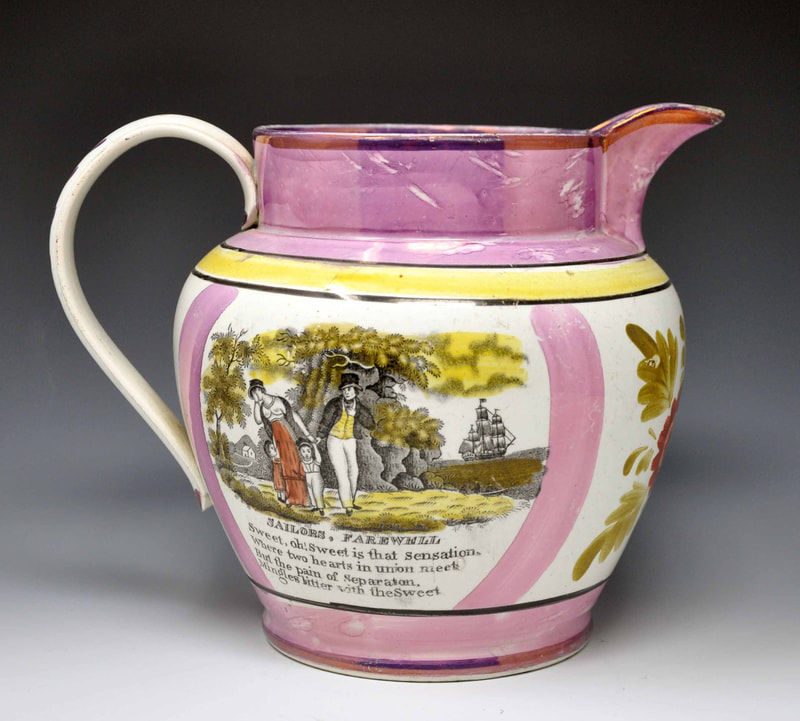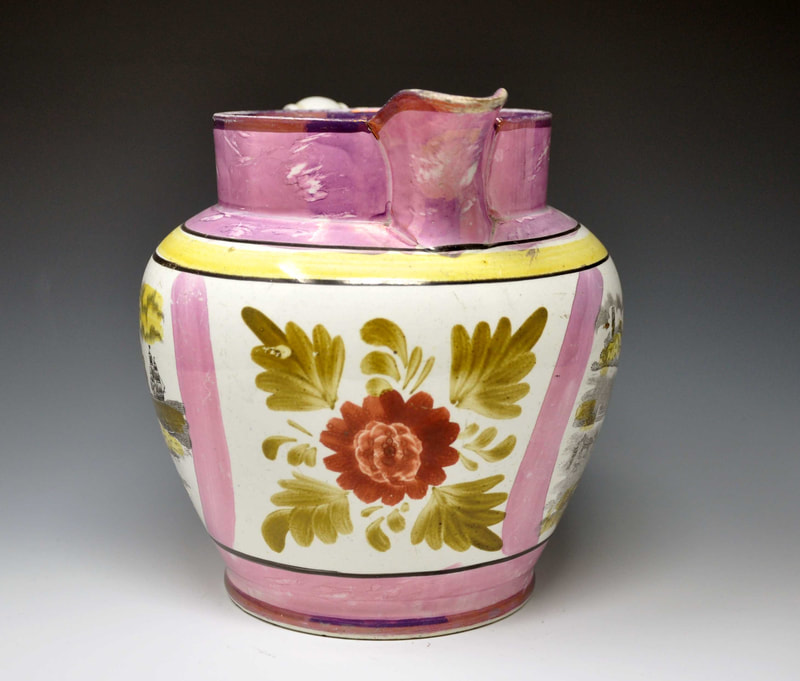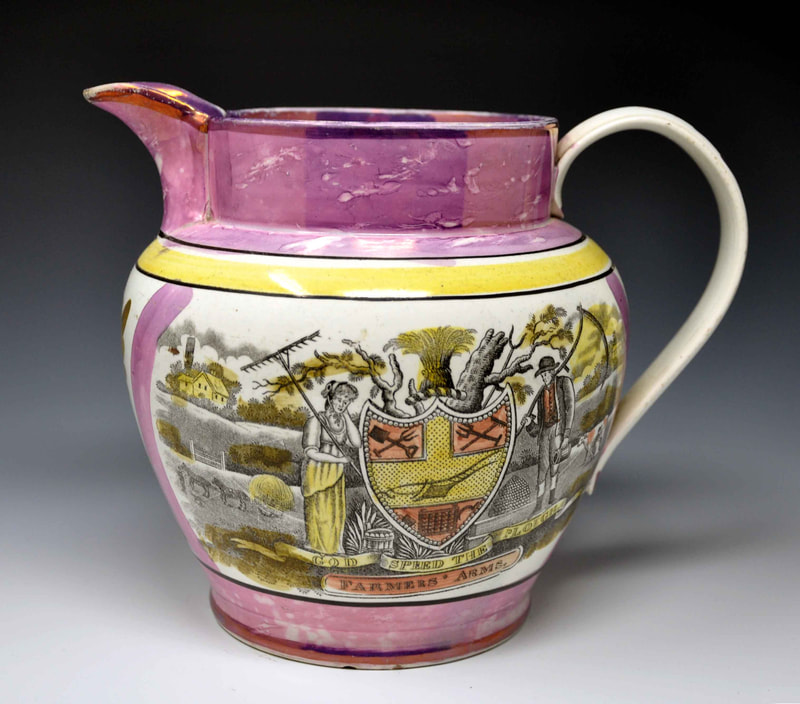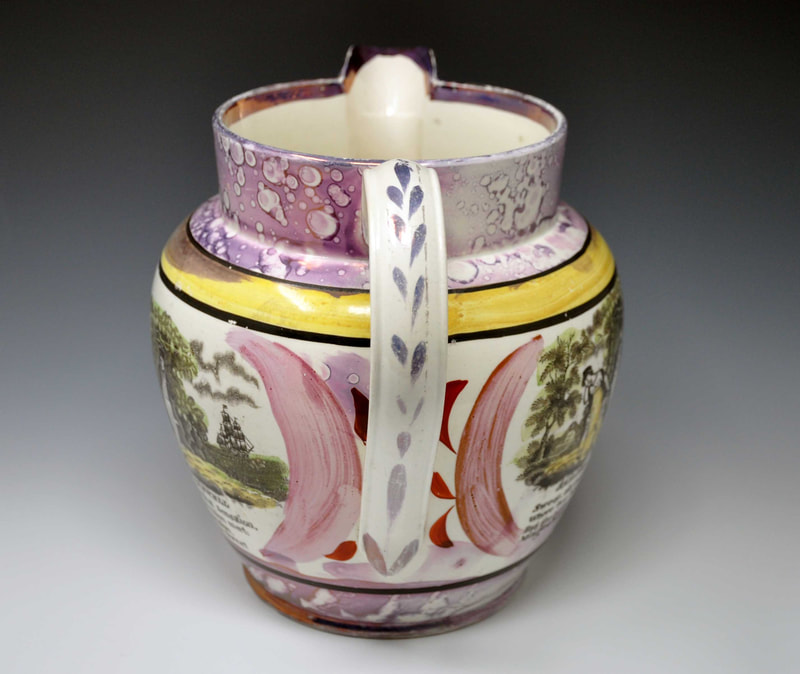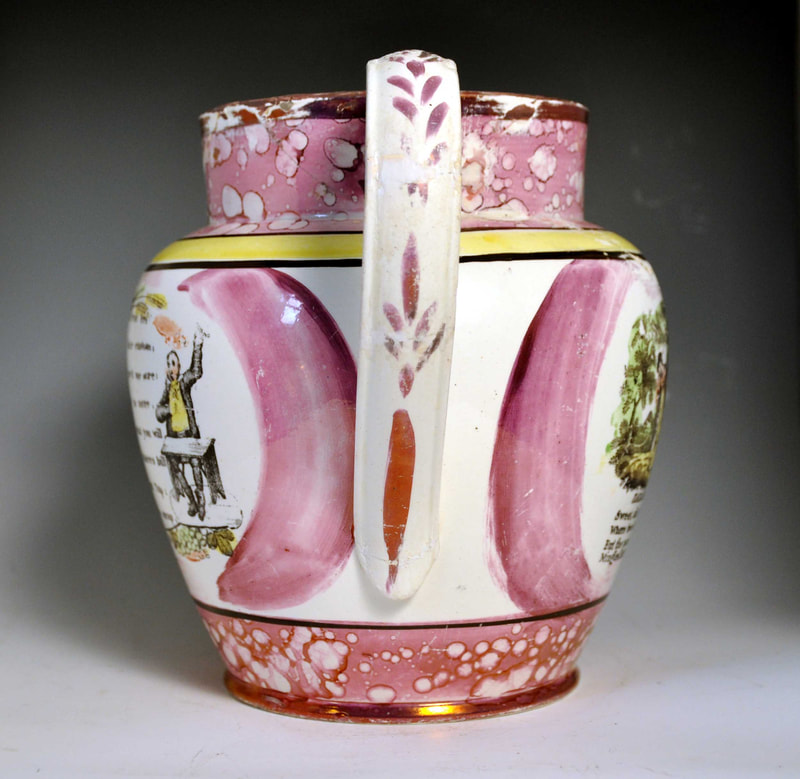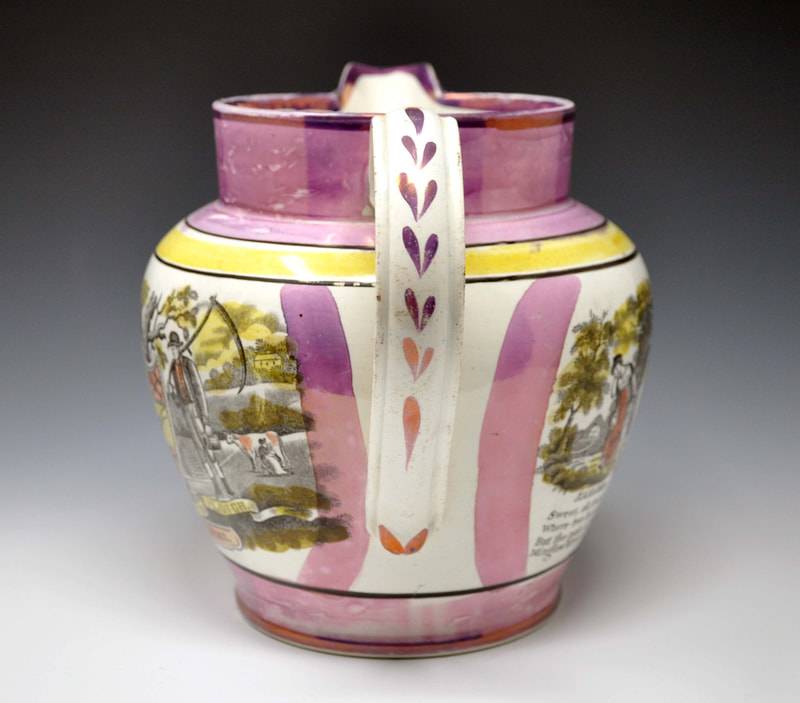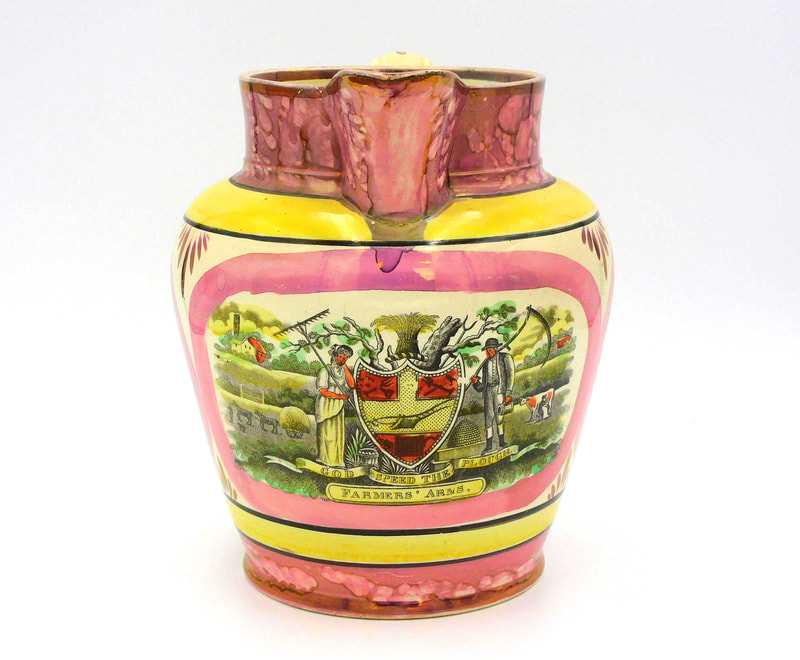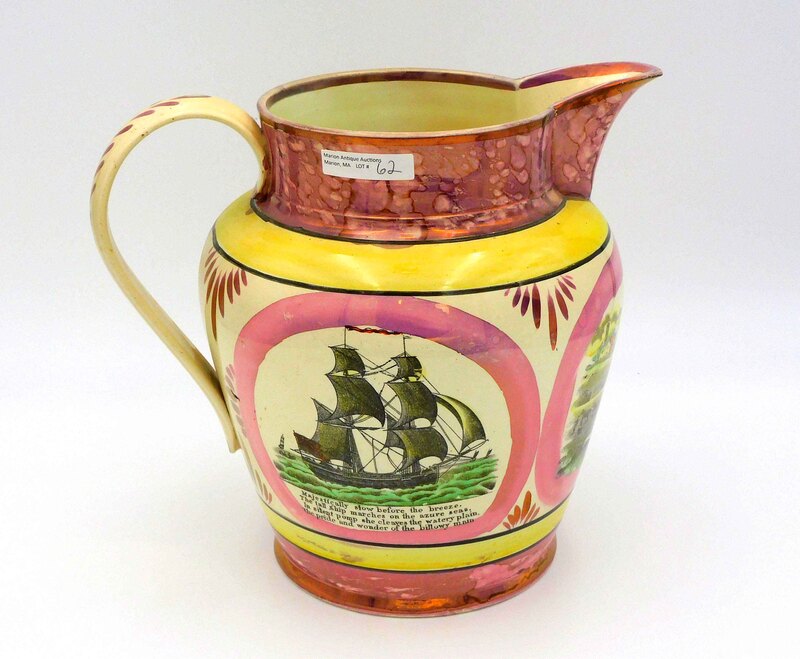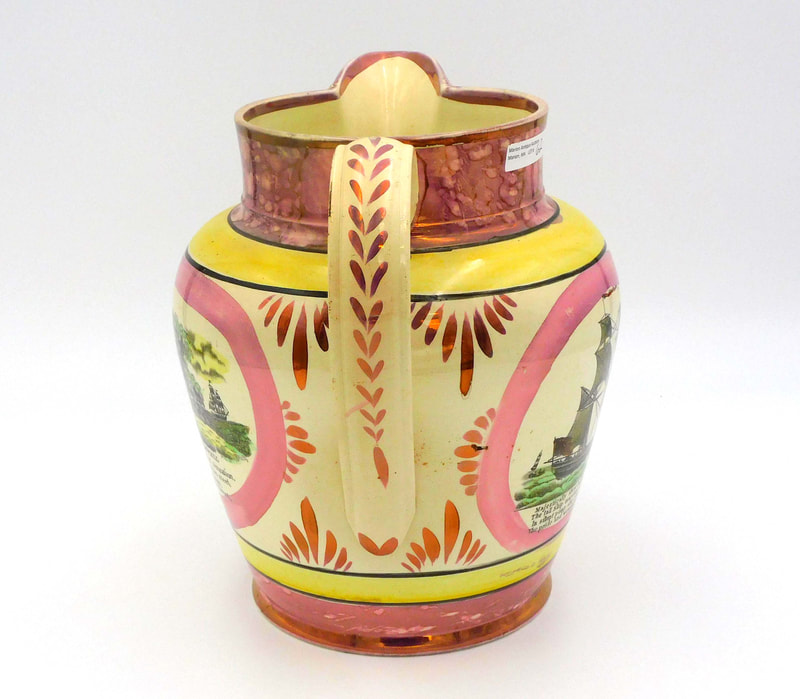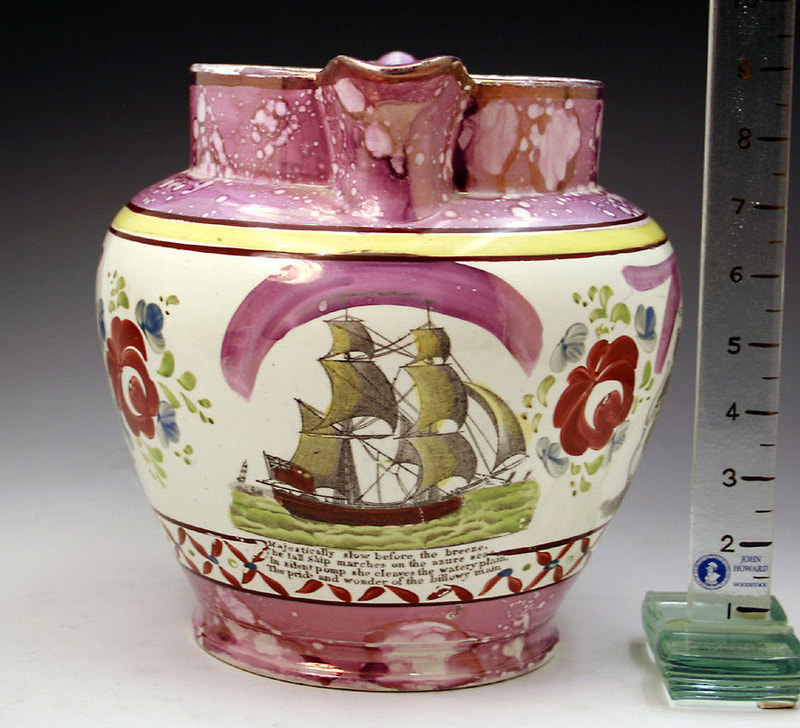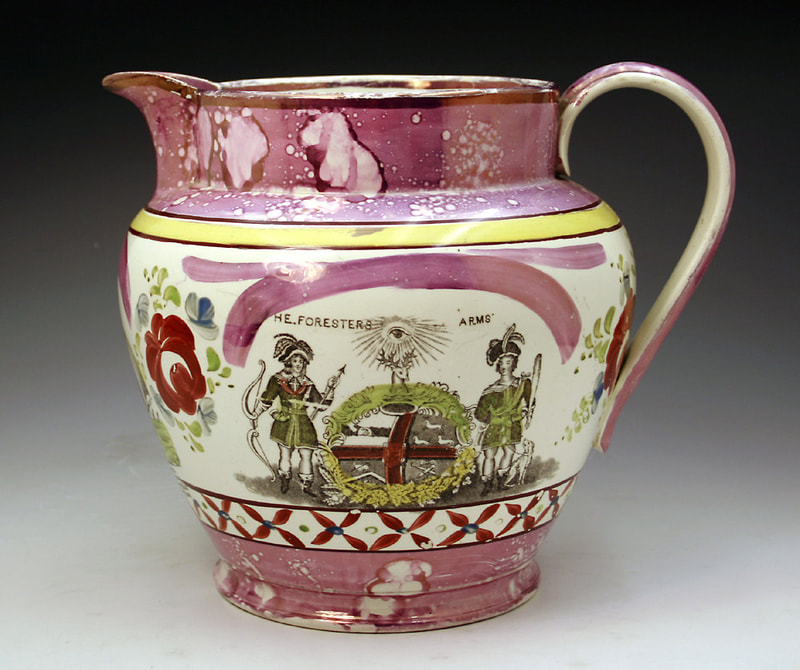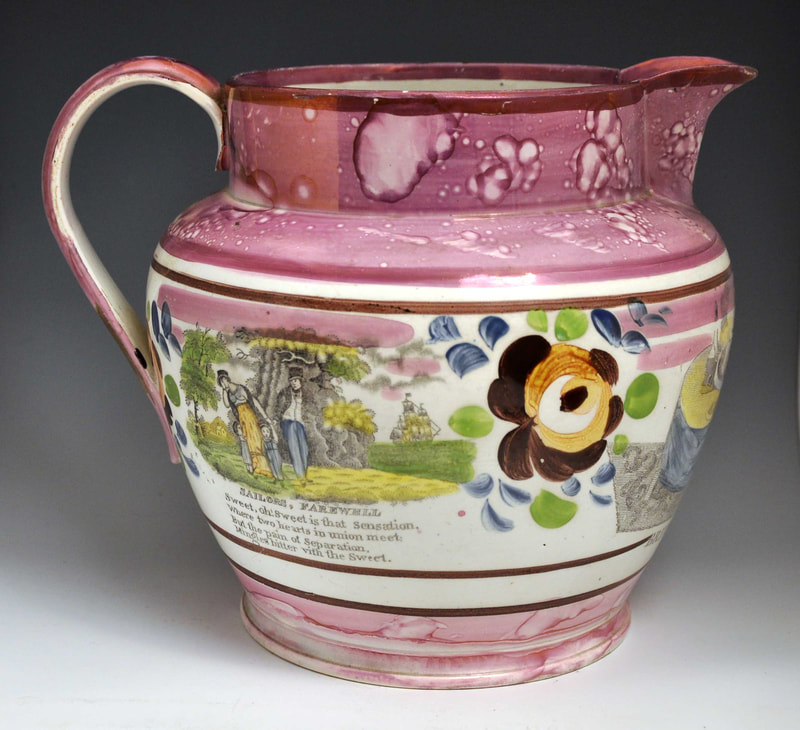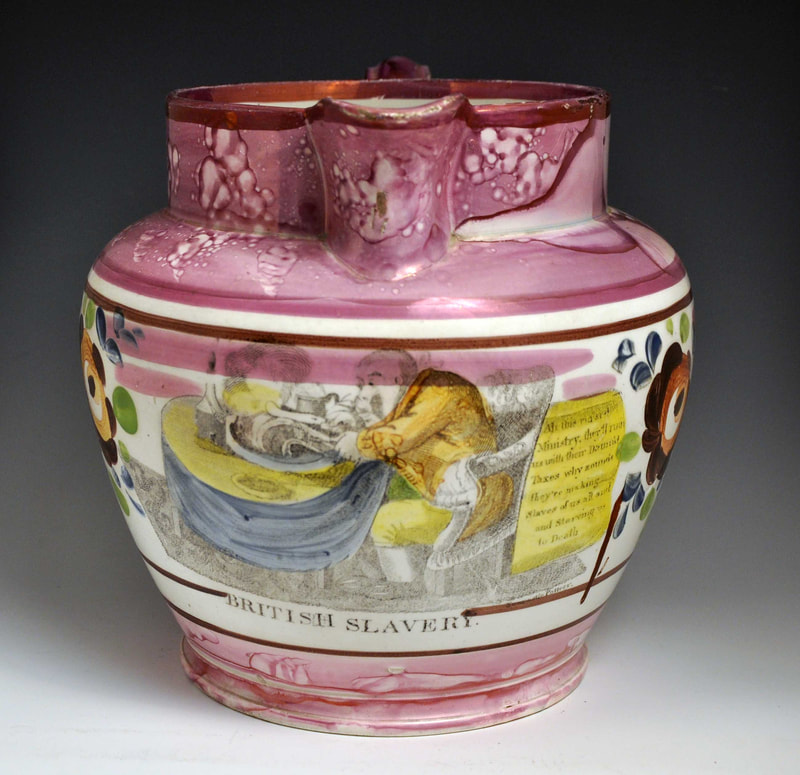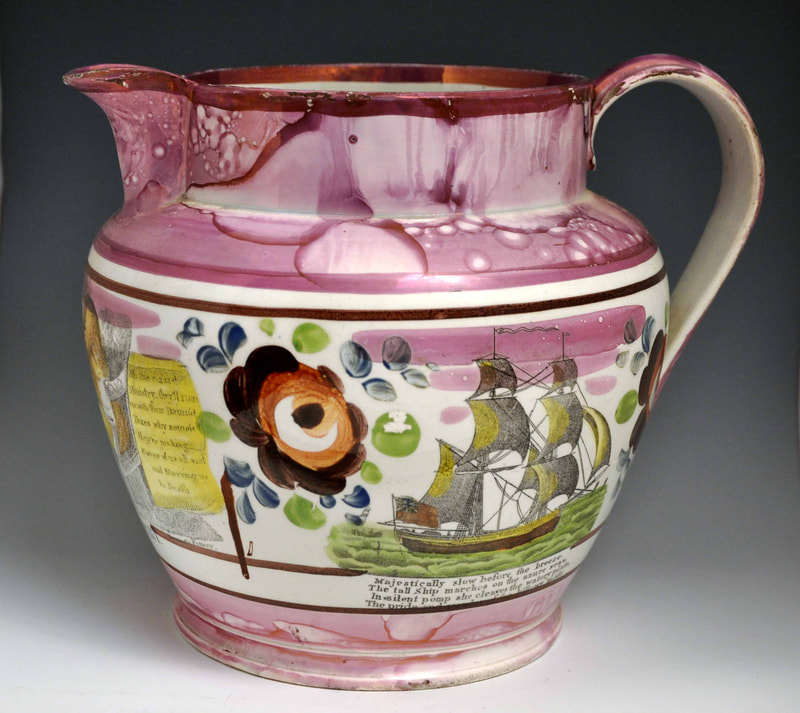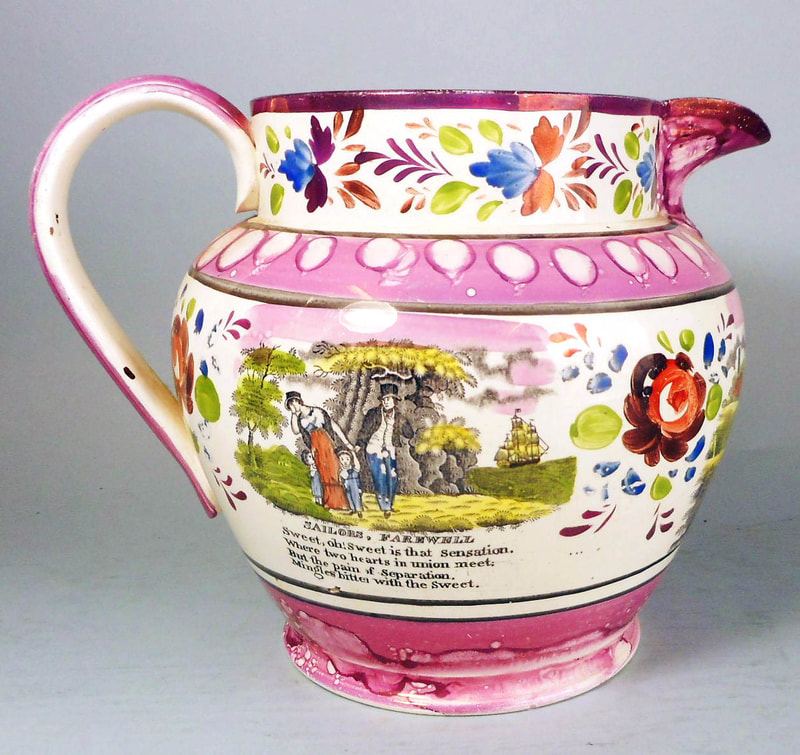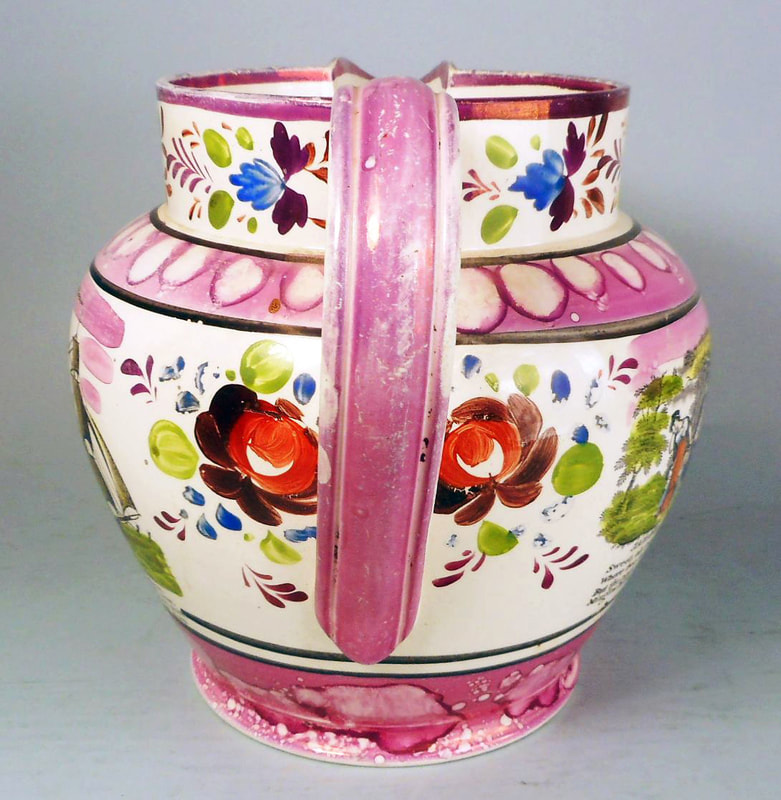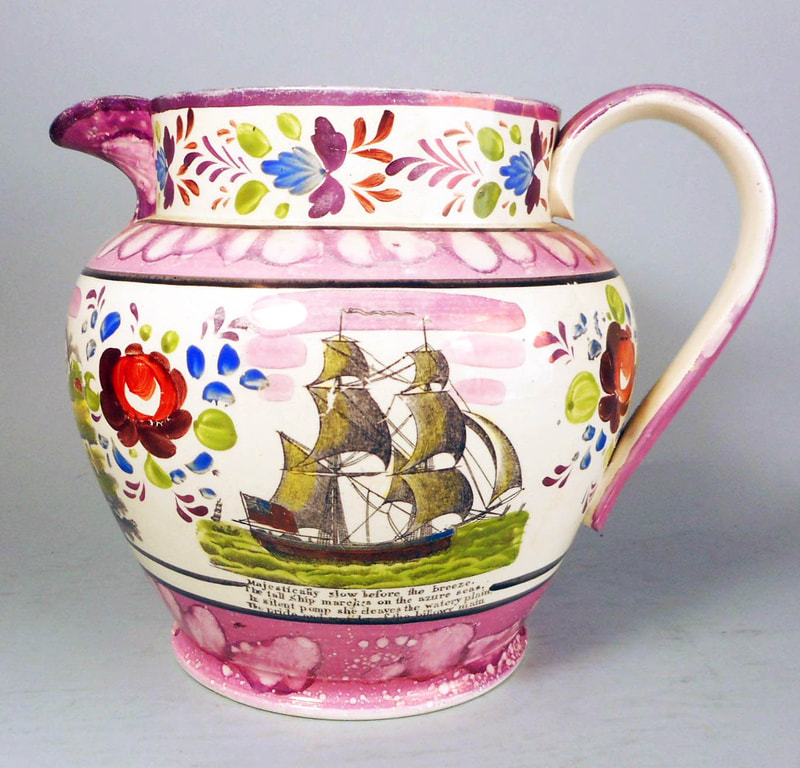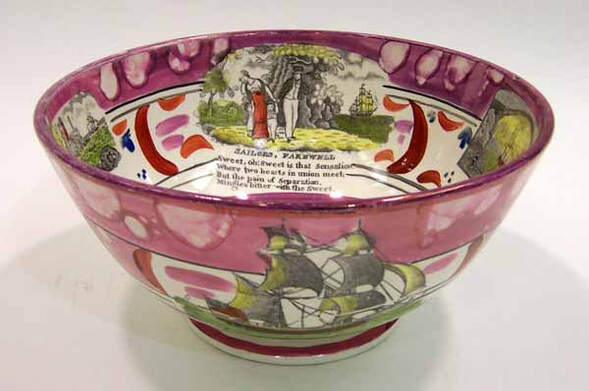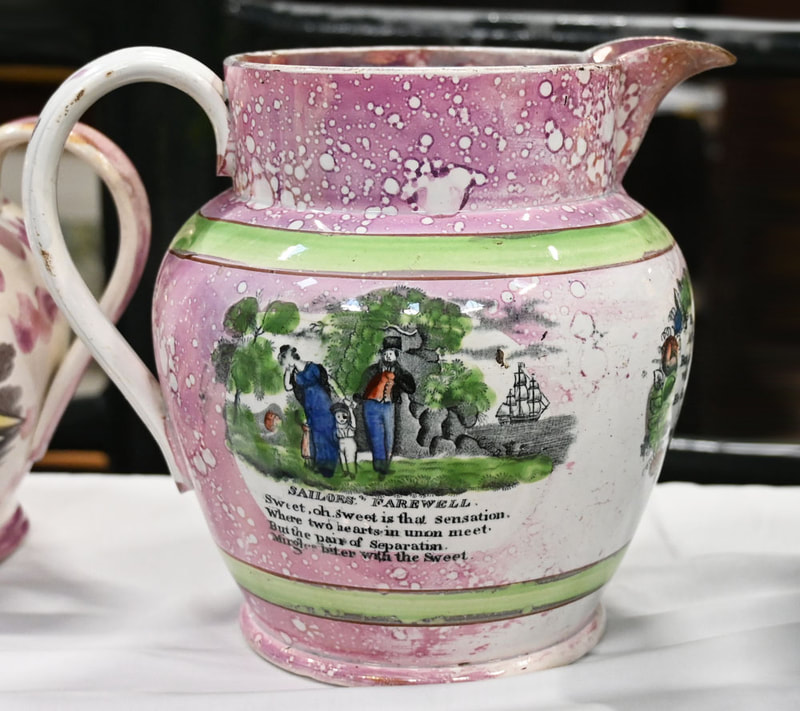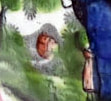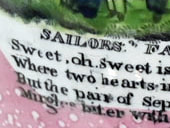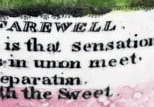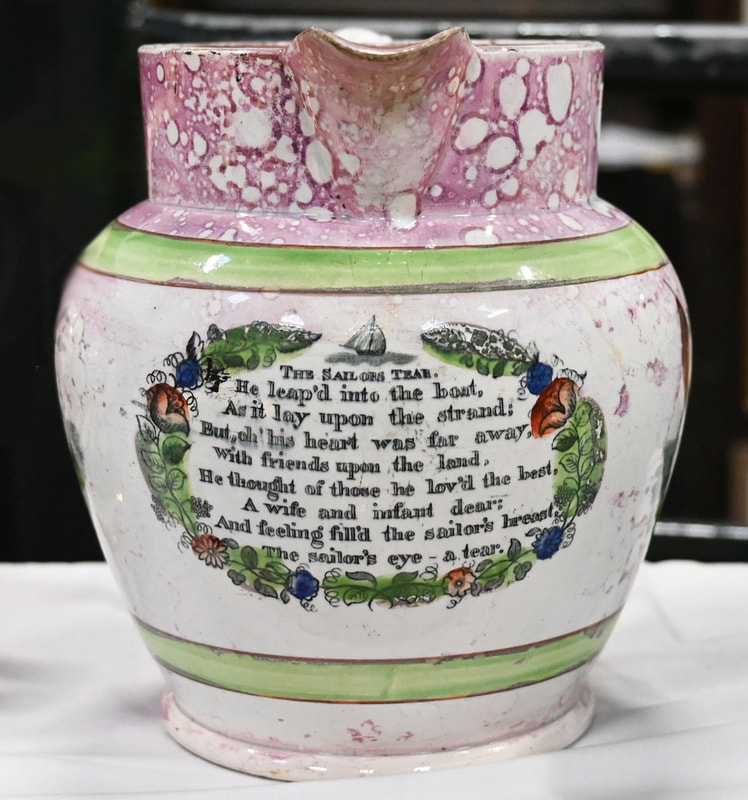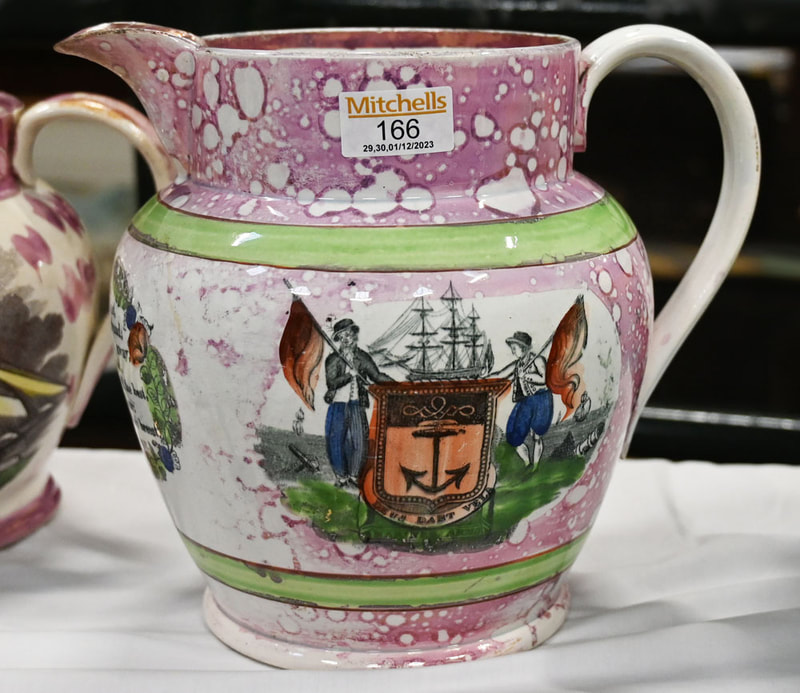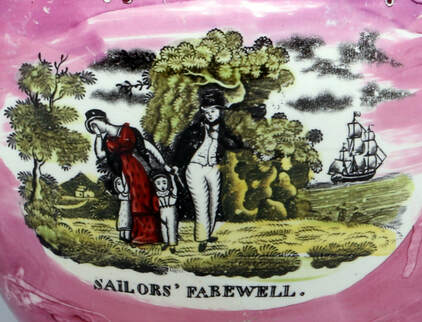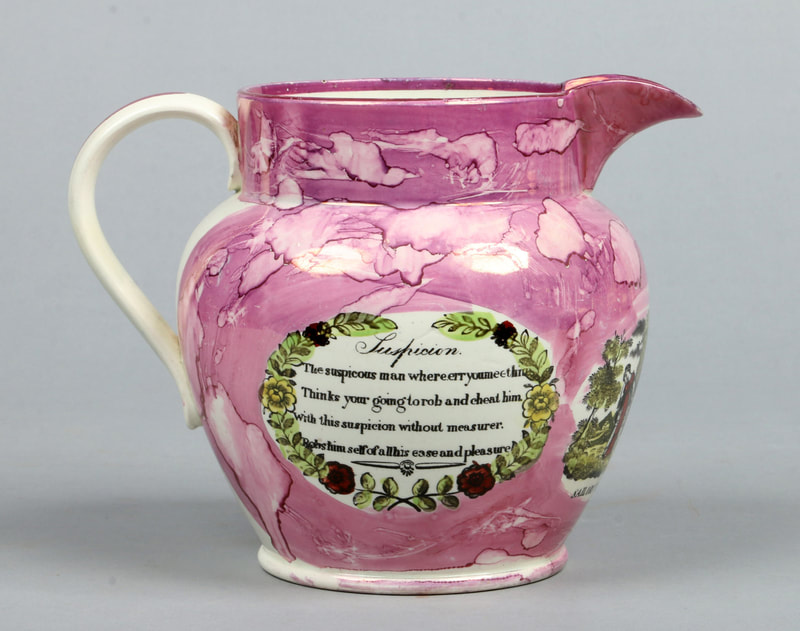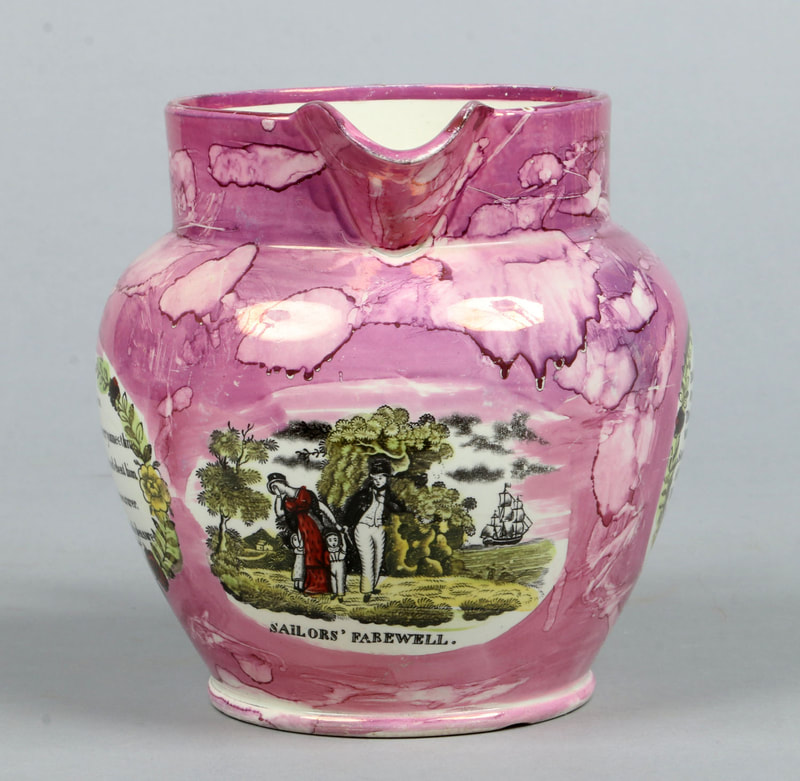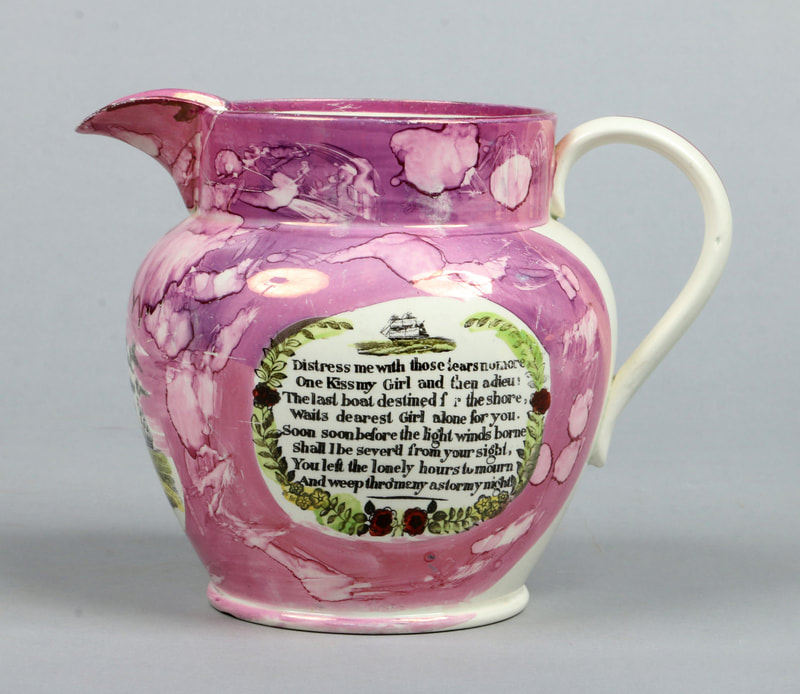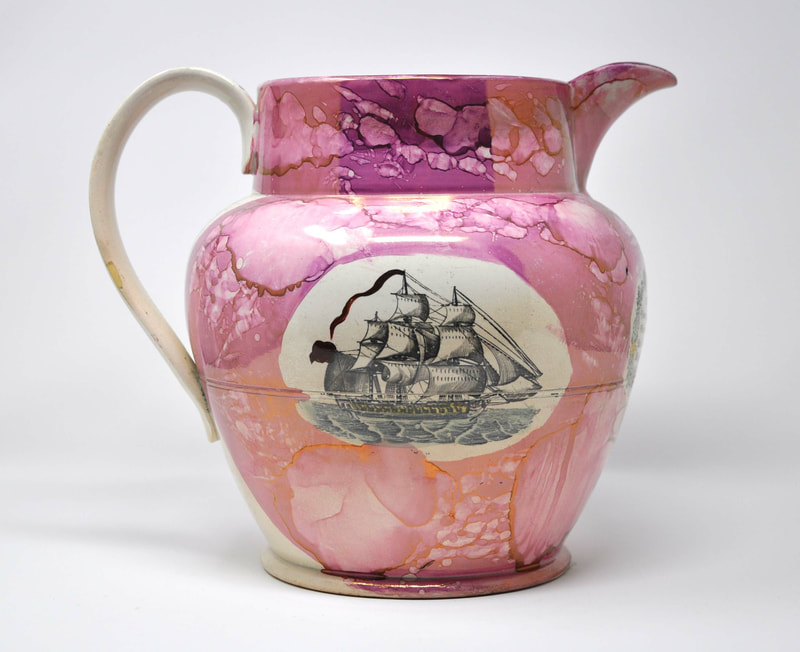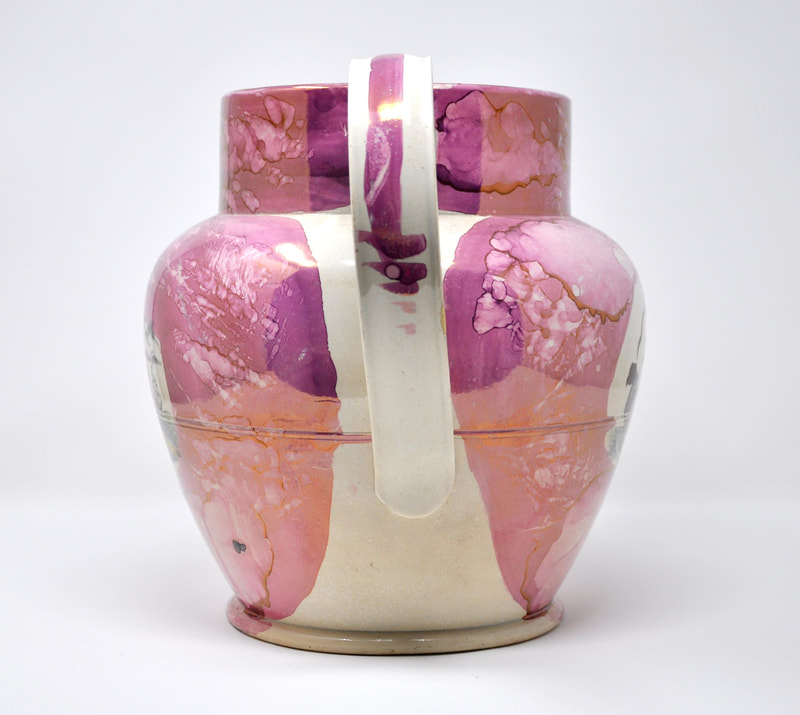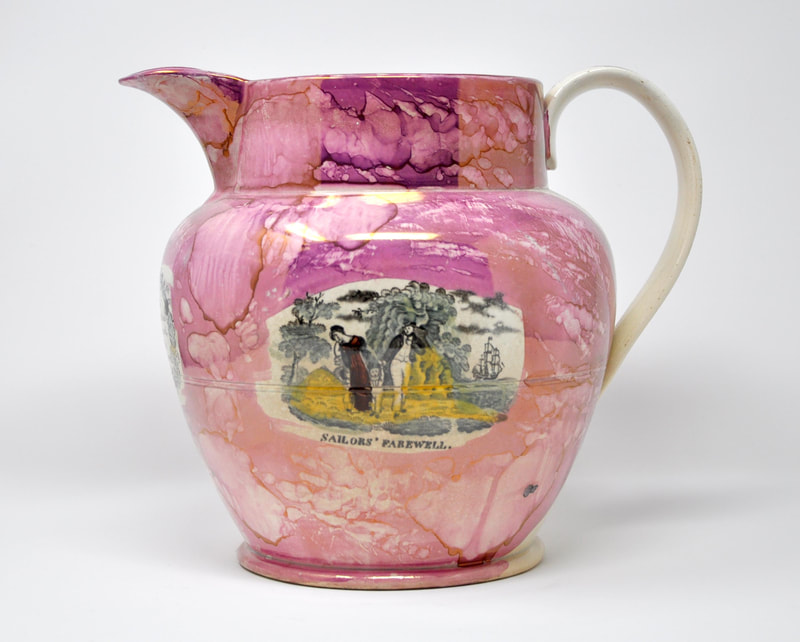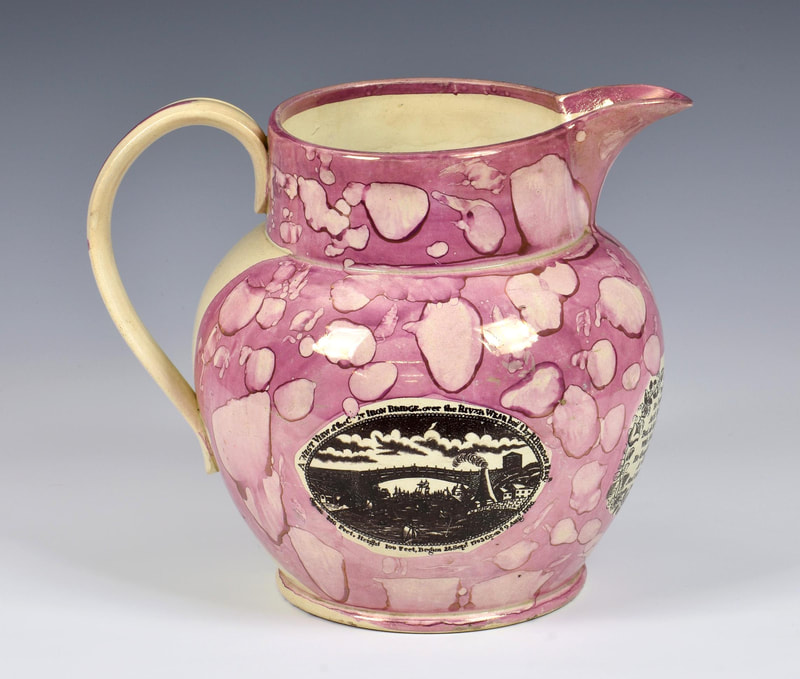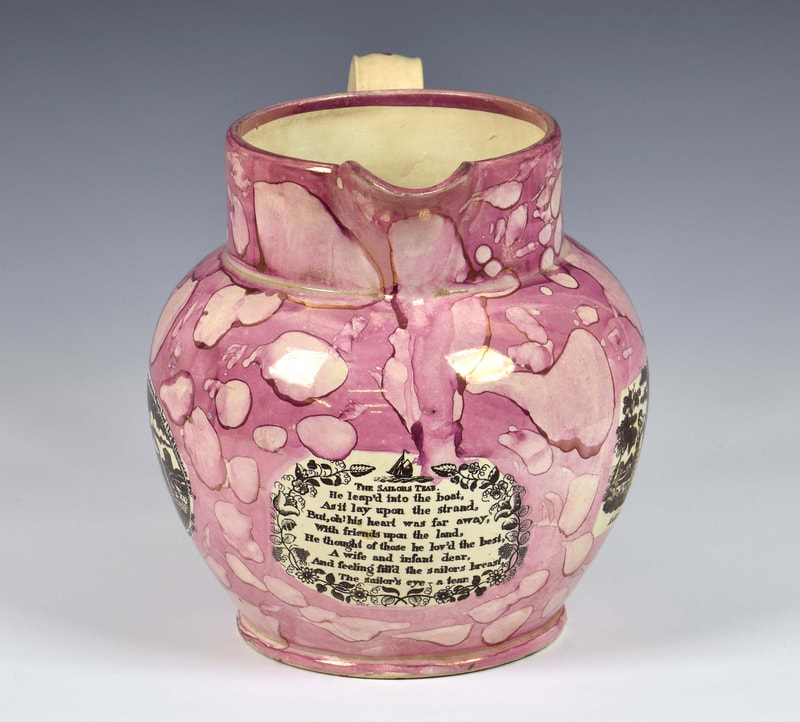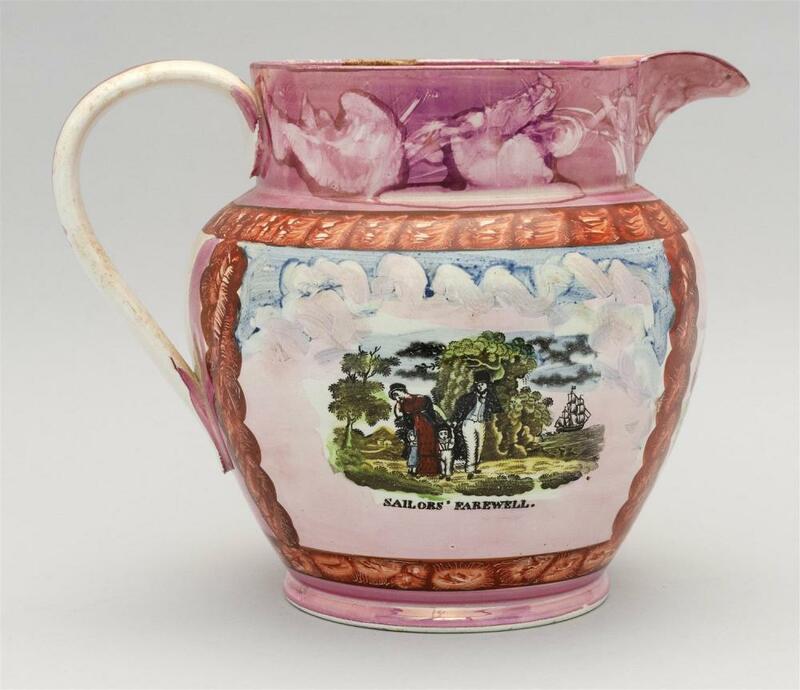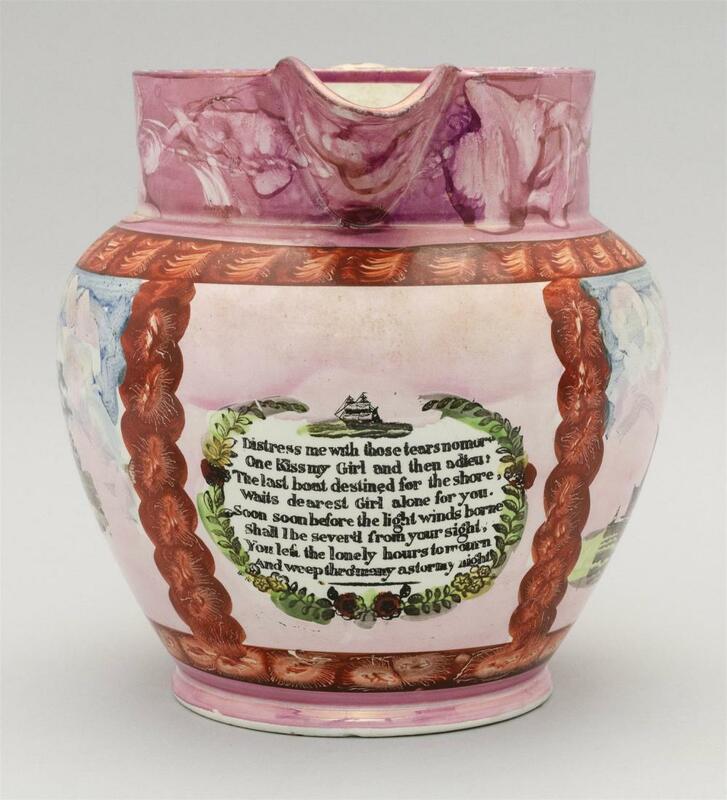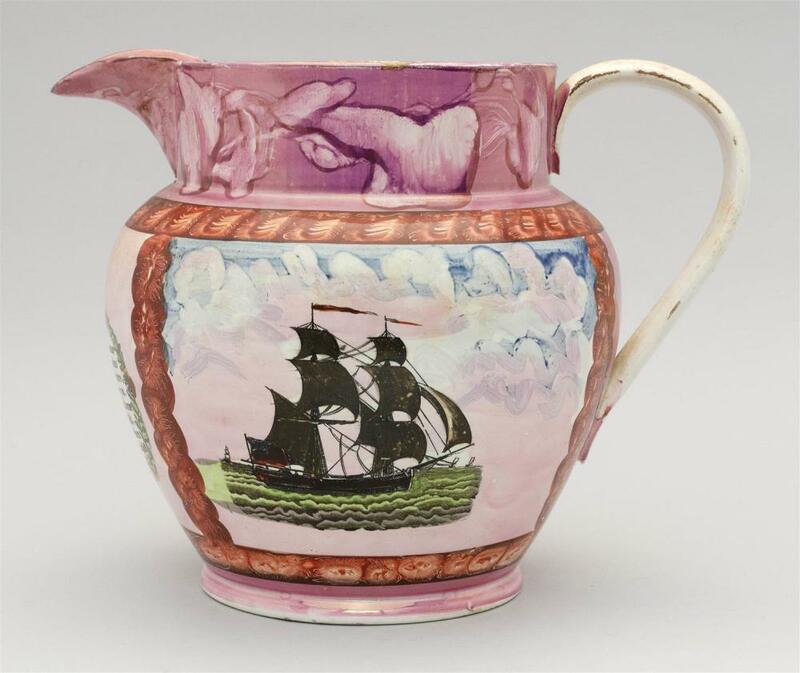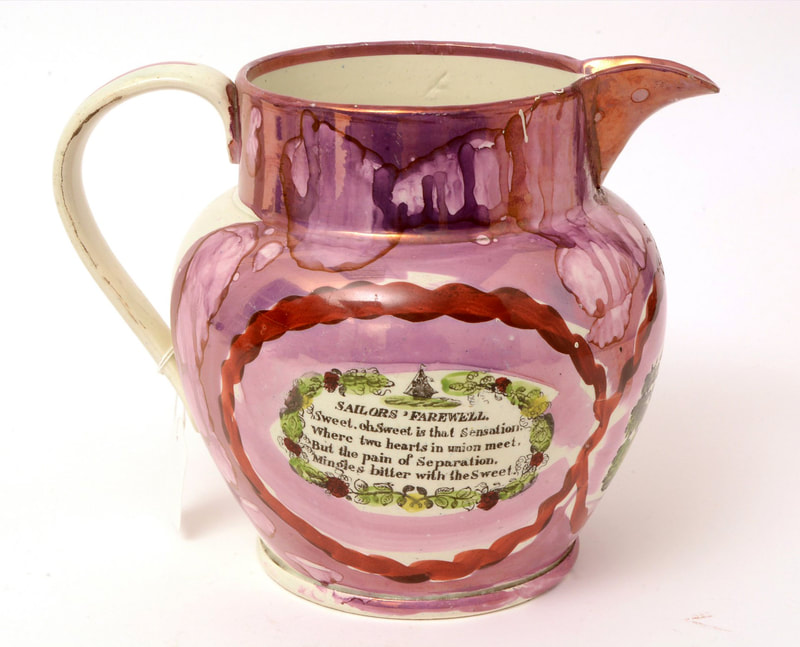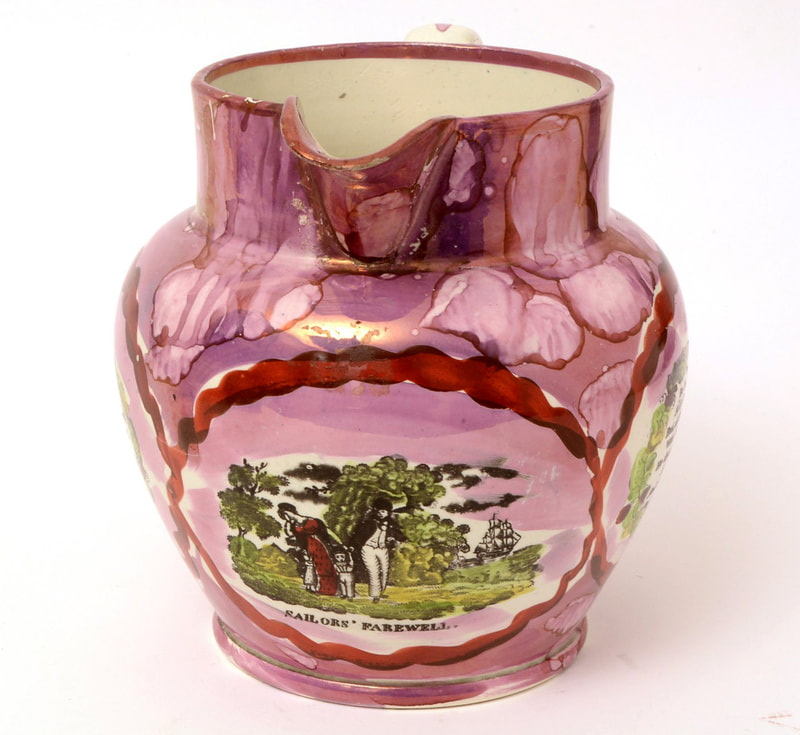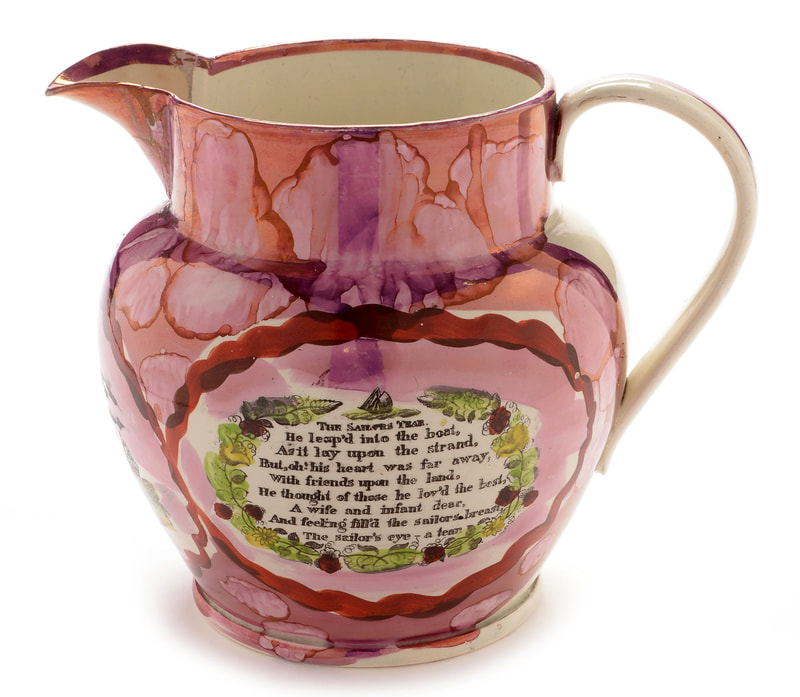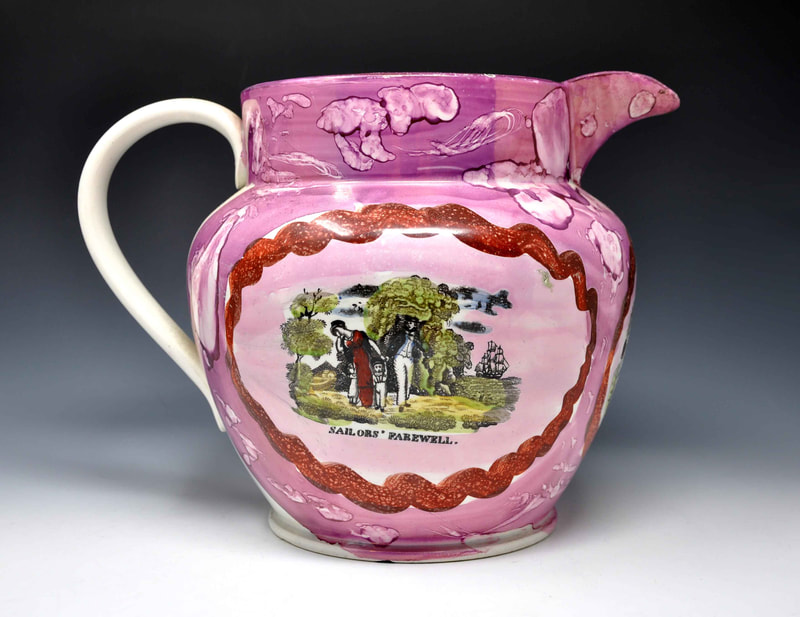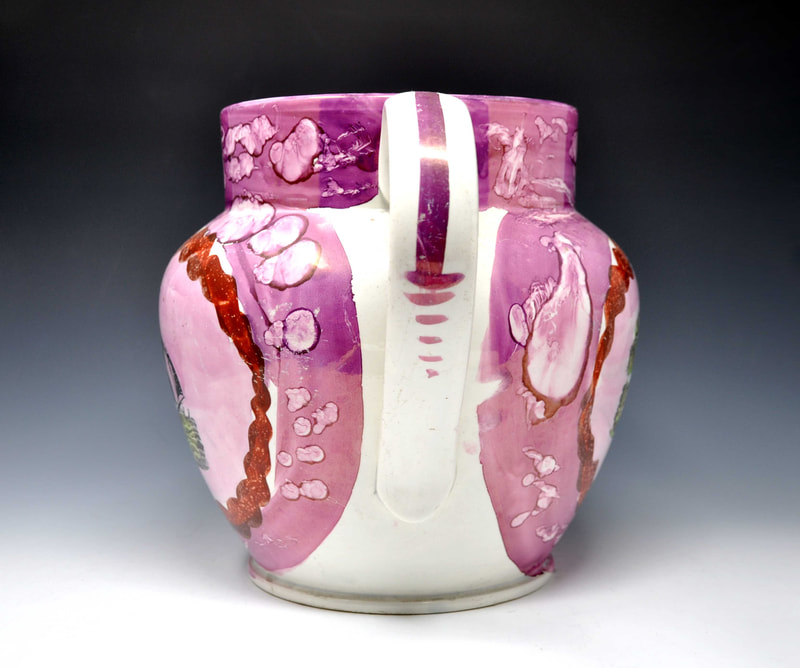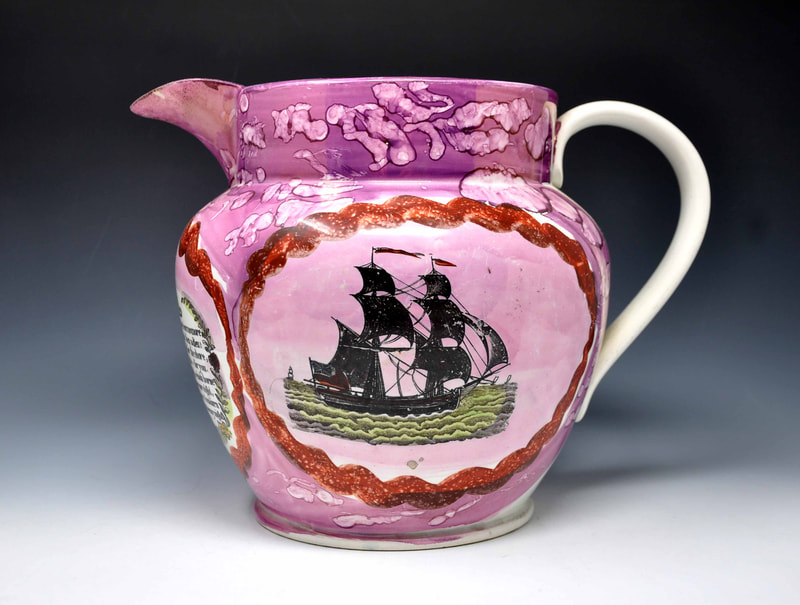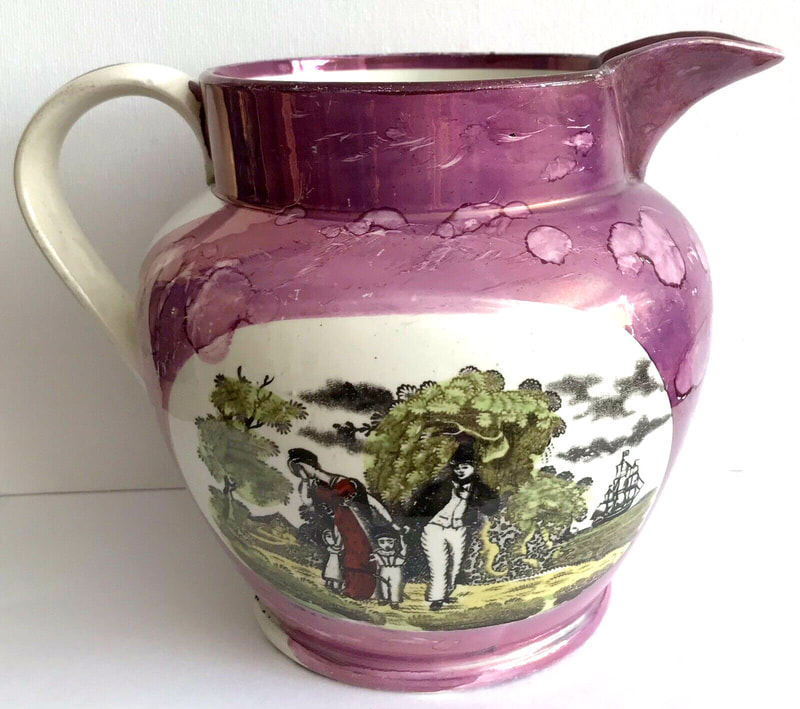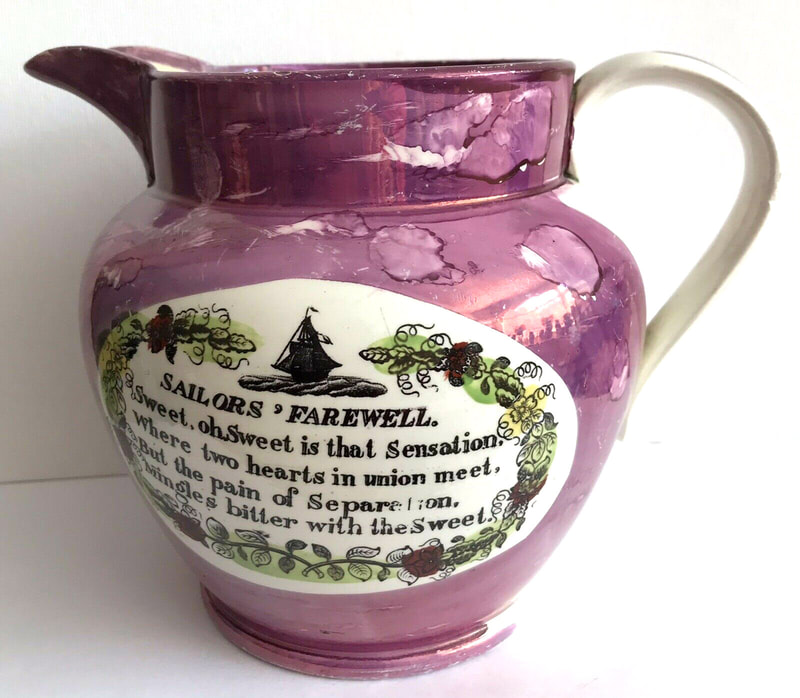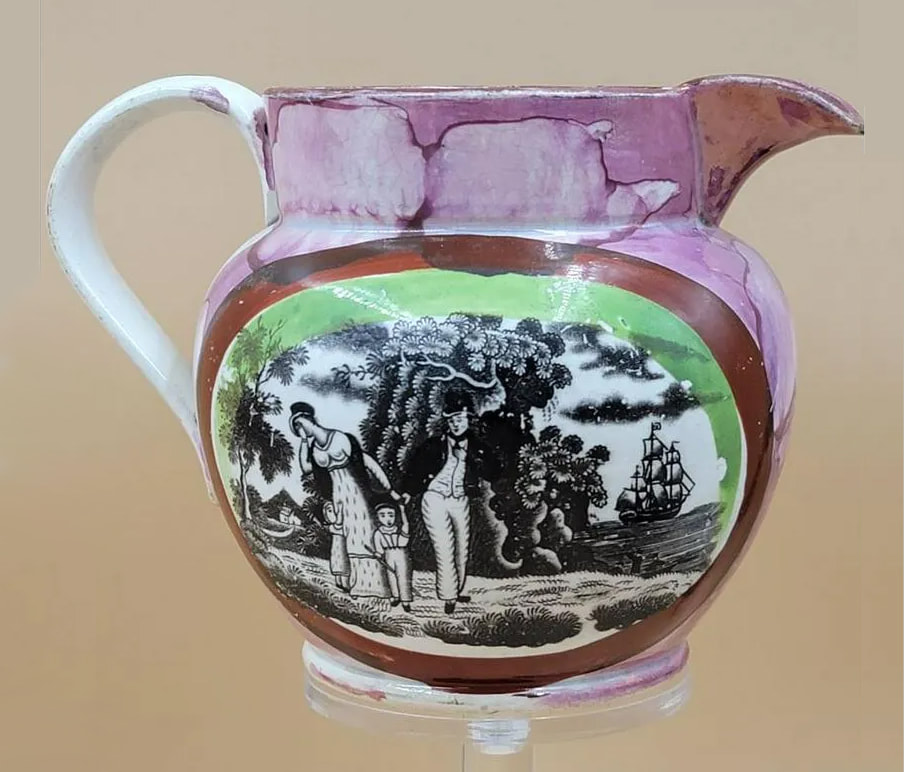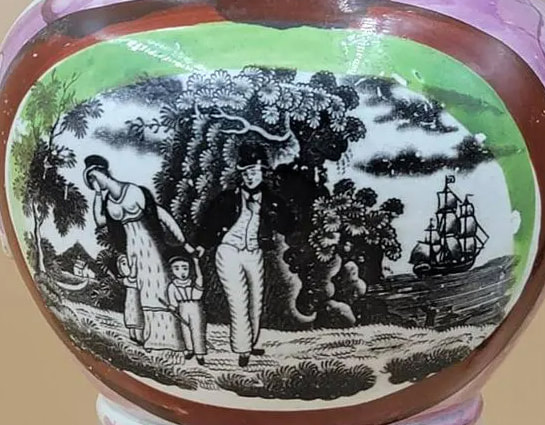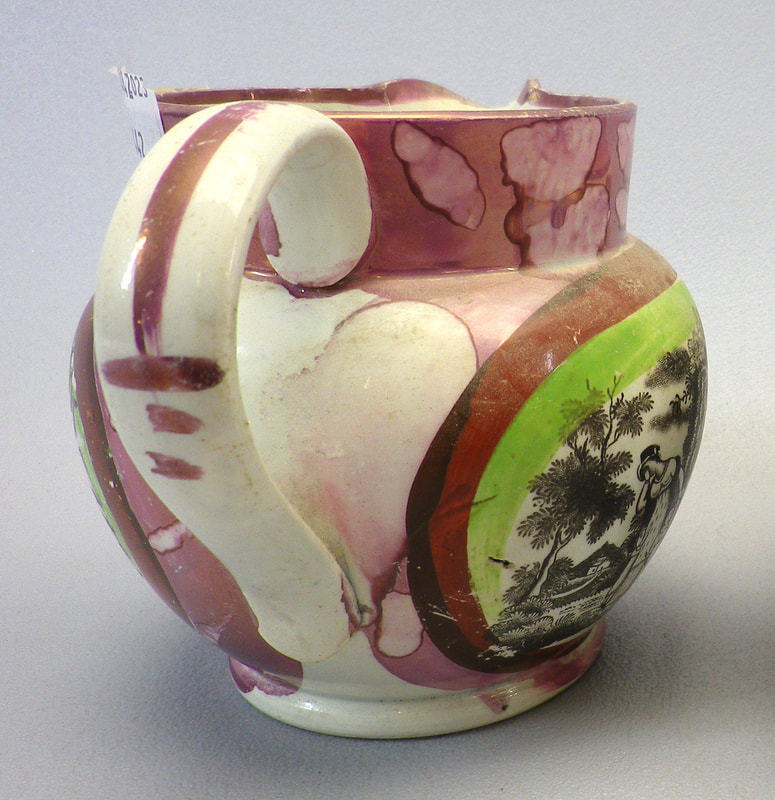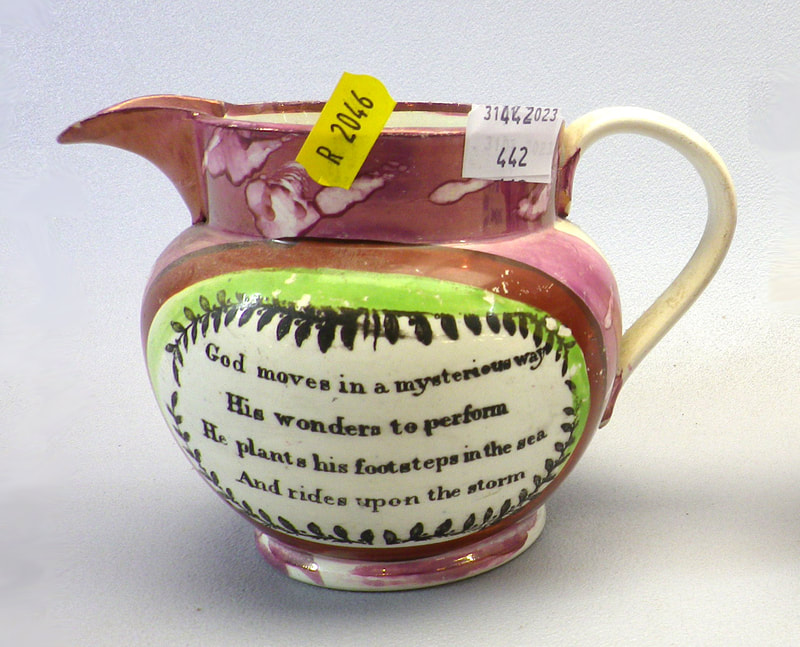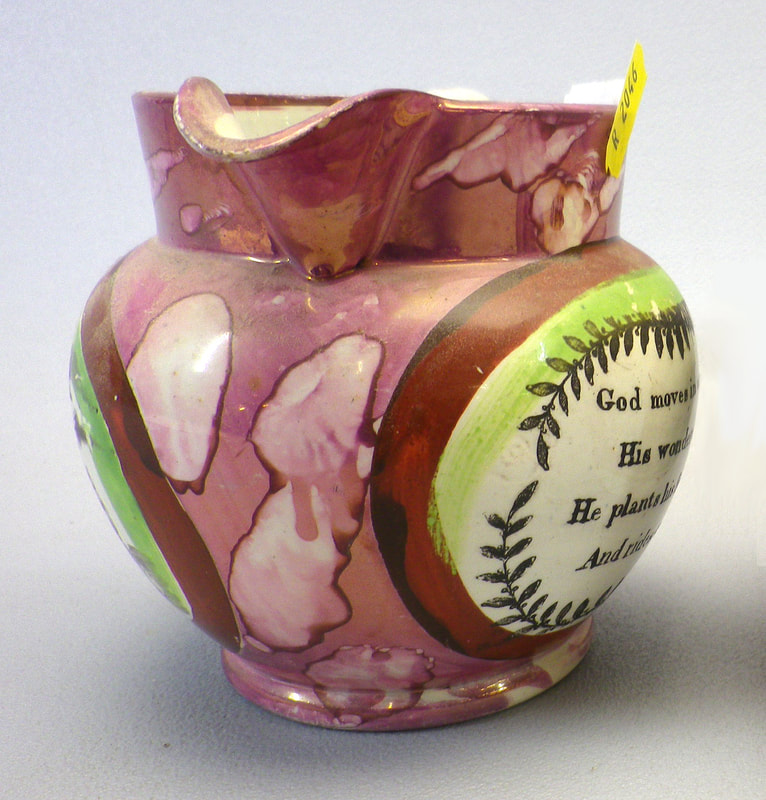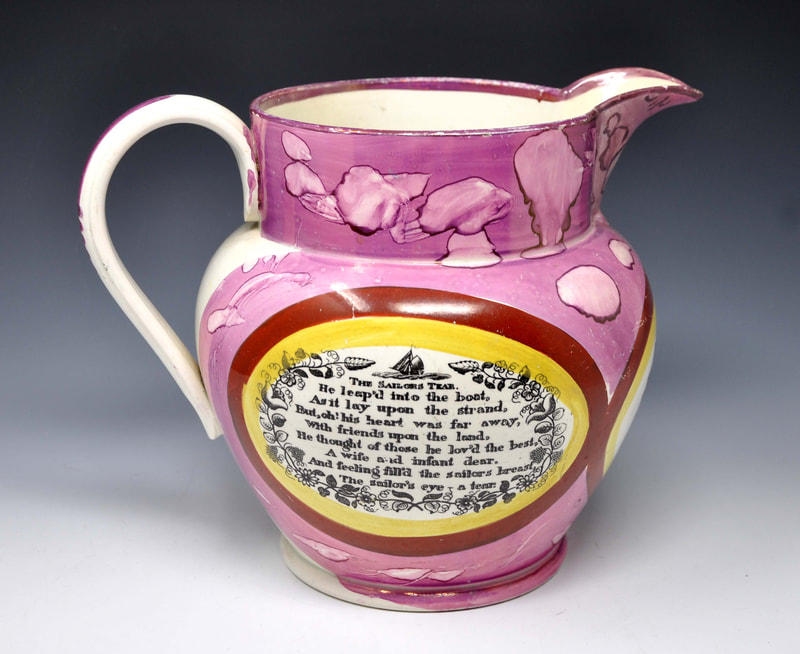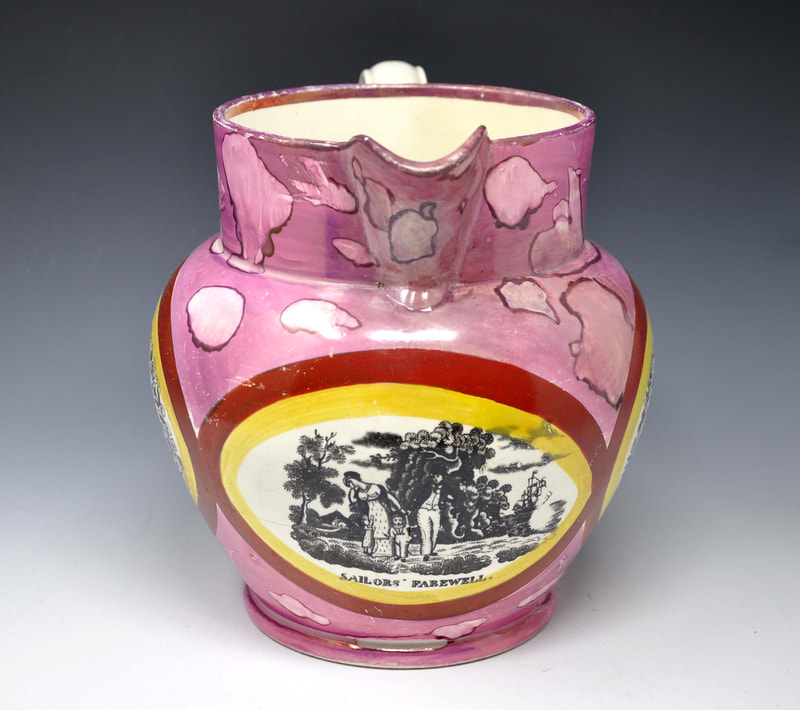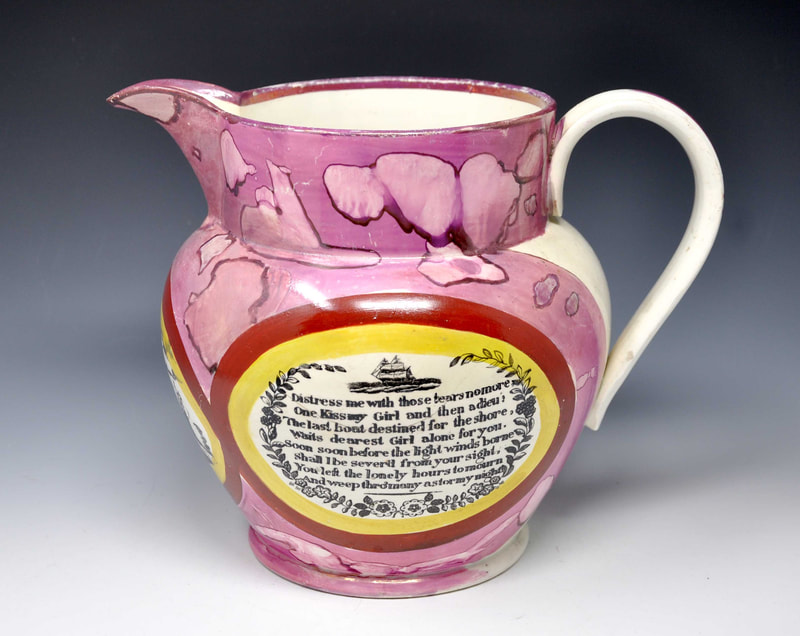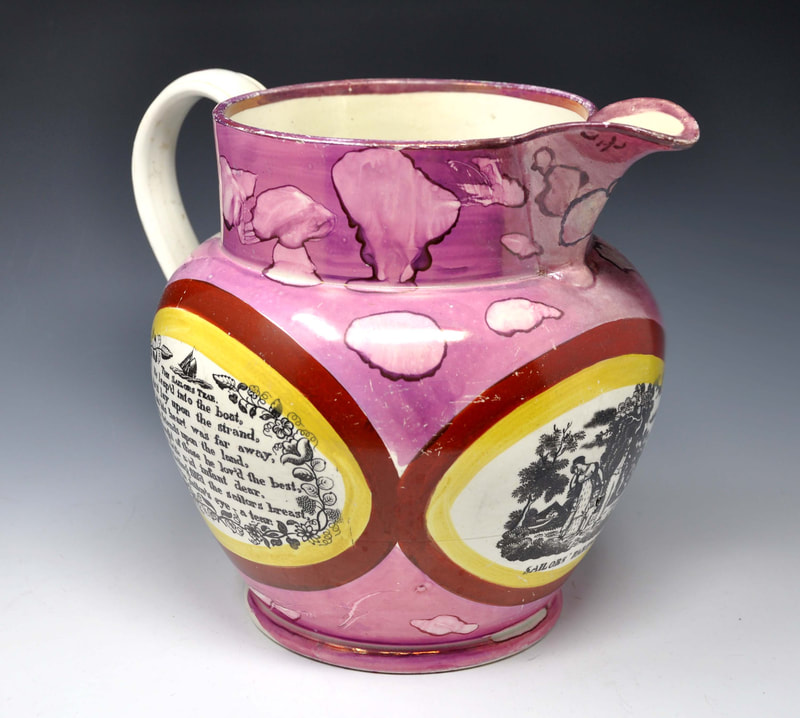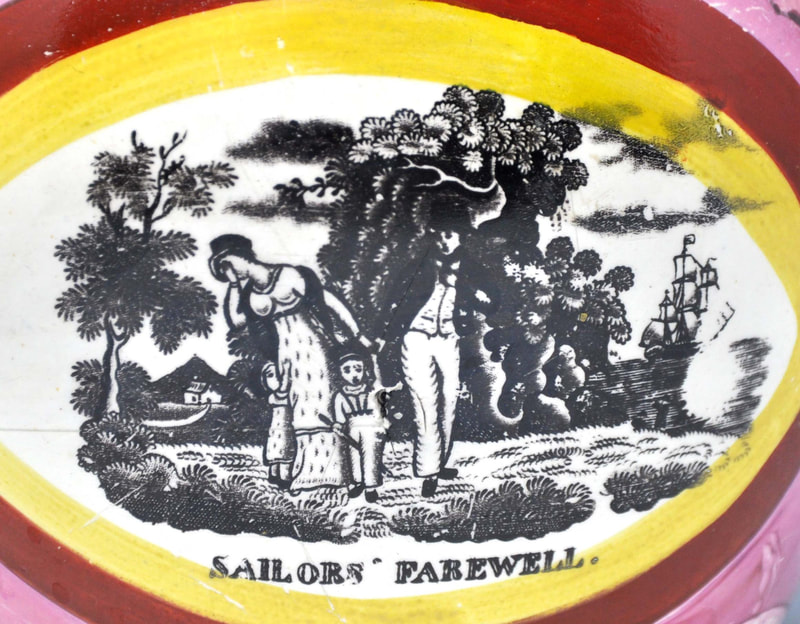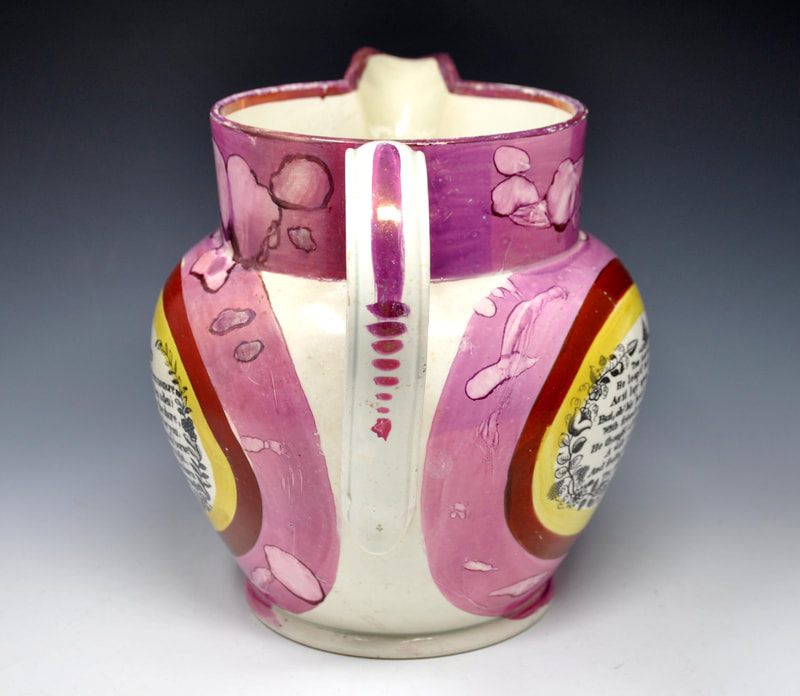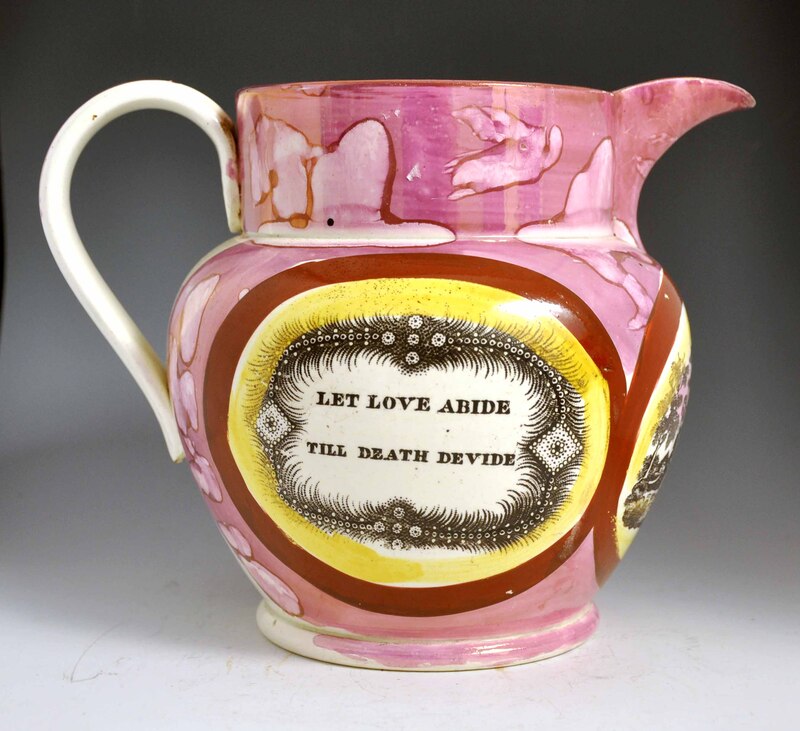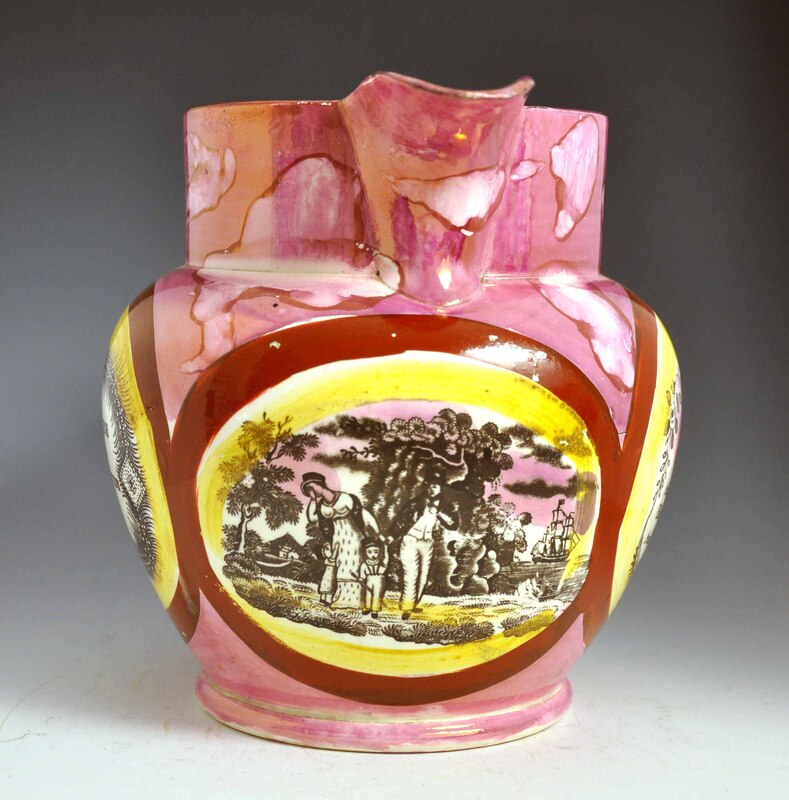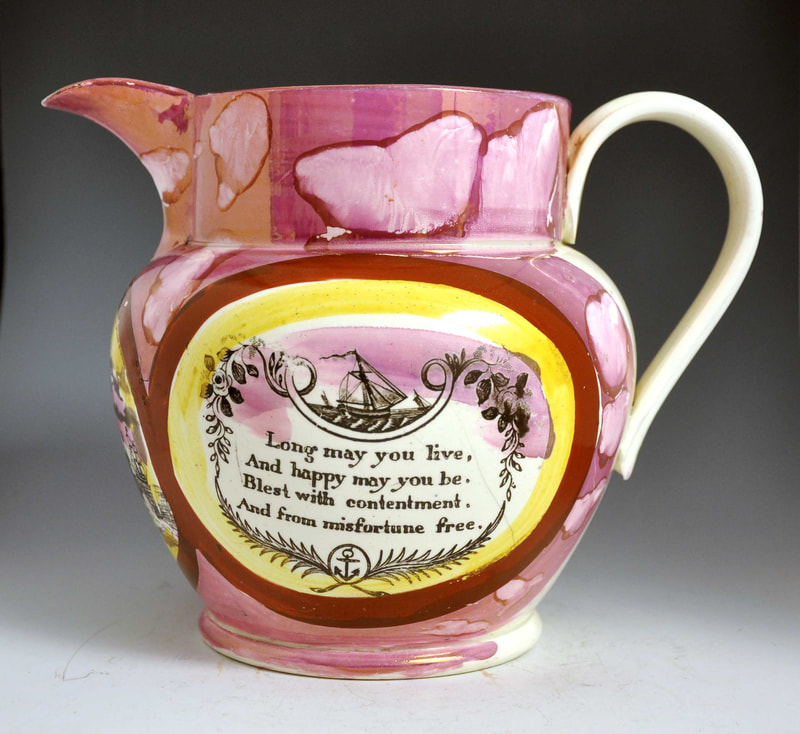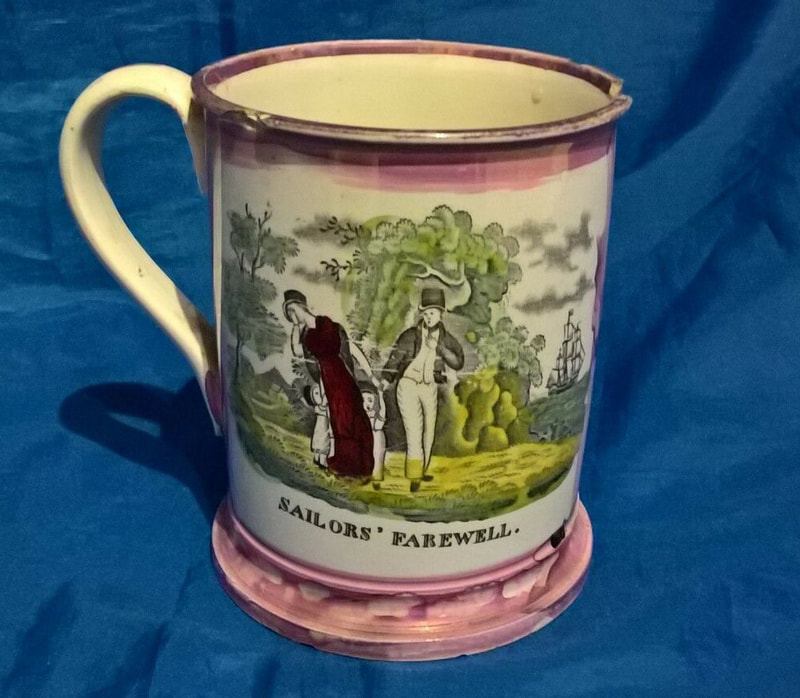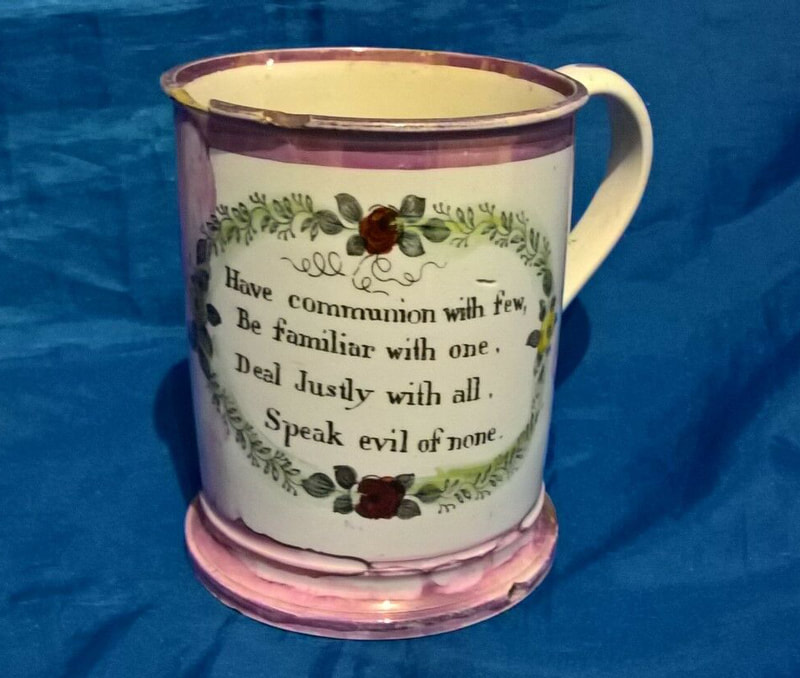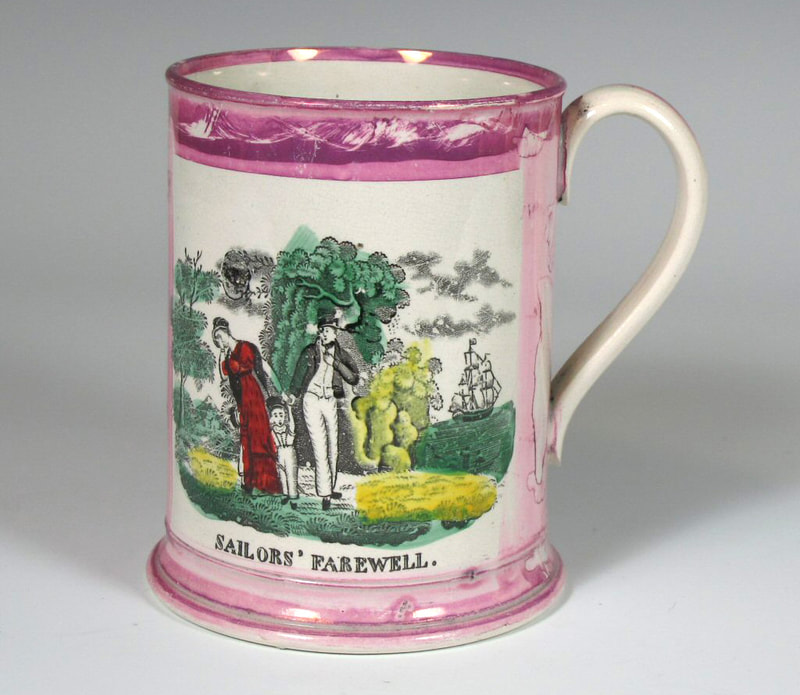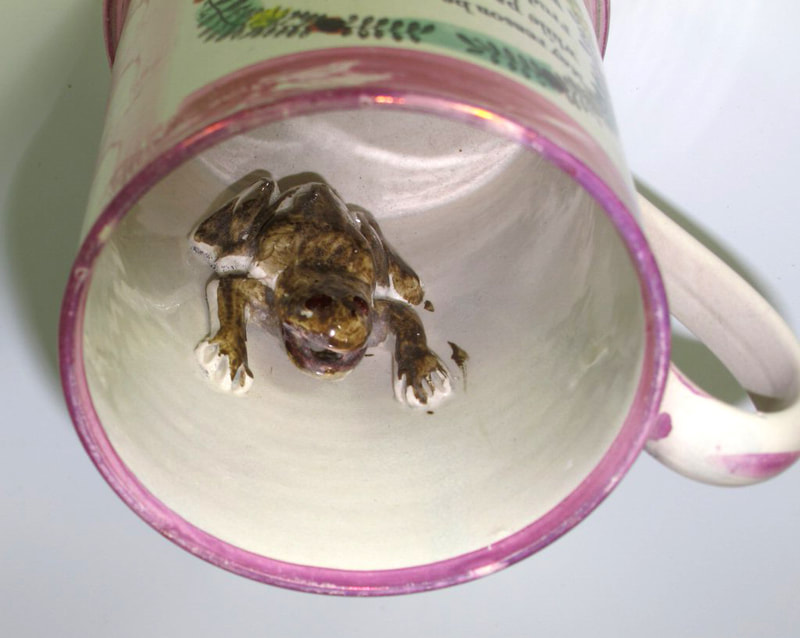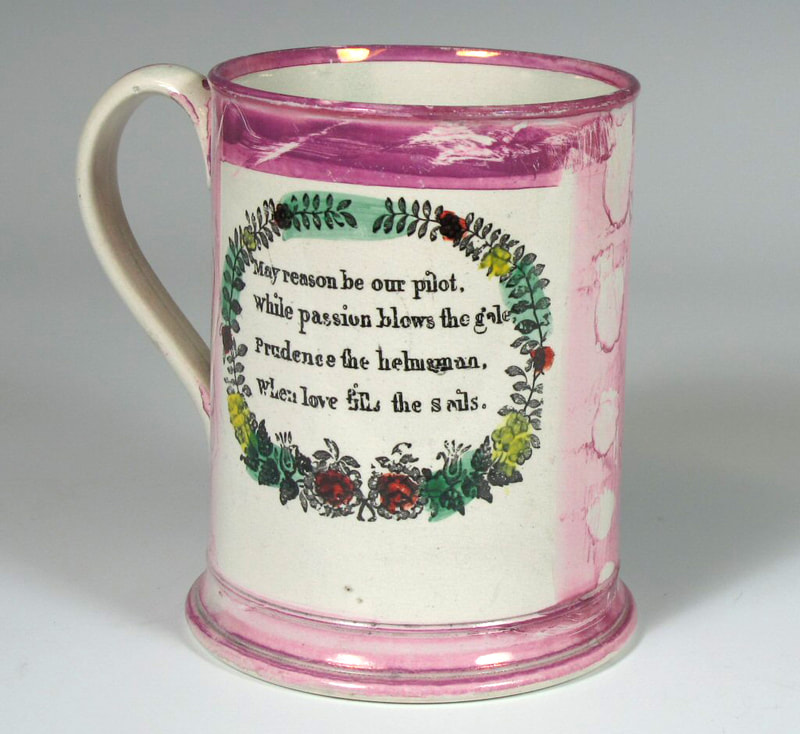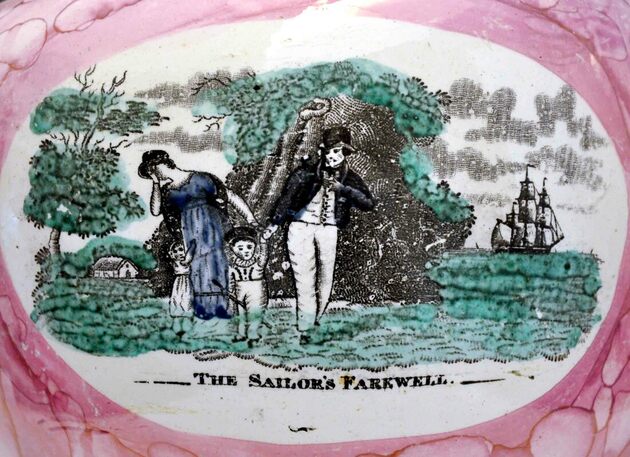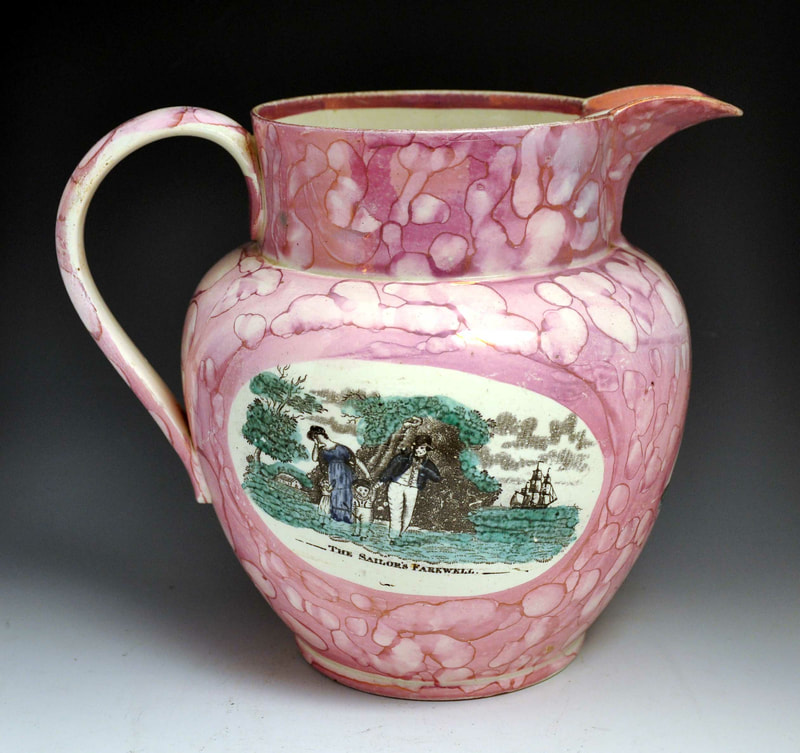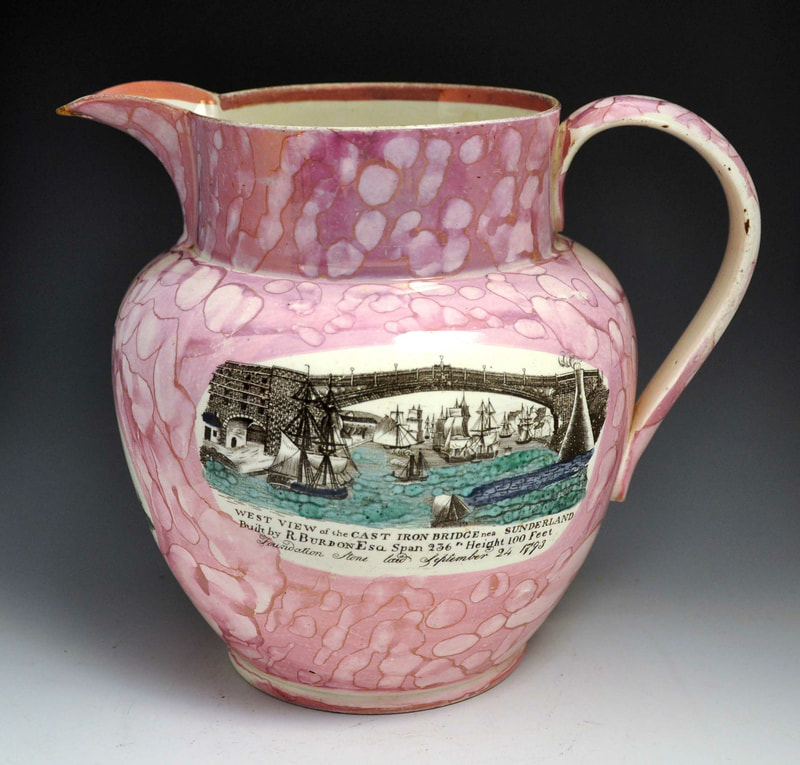Sailor's Farewell – Tyneside
Thomas Fell, St Peter's Pottery
A very fine imprint of the transfer, perhaps from the 1830s.
Both the jug above and below have typical Fell decoration, It is hard to be 100% sure that the transfers come from the same copper plate.
This more typically sooty imprint of the transfer is hard to read. However, note the two dots (nicks in the transfer plate) that appear above the second letter 't' in the details below. The left detail is from the jug above, and the right detail from the frog mug below.
There is a lustre sun painted to the top right of the Sailor's Farewell transfer on the first jug. This decorative feature appears to be unique to Thomas Fell.
Unidentified pottery, perhaps Carr and Patton, Low Lights, North Shields
As with the jug below, the quality of the lustre suggests Tyneside rather than Wearside. The mug has an undecorated white stripe behind the handle.
Unidentified pottery, perhaps Carr and Patton, Low Lights, North Shields
The jug below has an almost identical transfer to the mug above. There are, however, differences in punctuation in the first line in the bottom left detail. There appears to be an exclamation mark before and after the word 'oh'. The bridge transfer is also very similar to that on the mug, but again has very subtle differences.
The extensive lustre decoration again suggests this high-waisted jug was made on Tyneside. The 'Sailors' Farewell' transfer is closest to North Shields plate 2 below.
Attributed to Carr & Patton, Low Lights Pottery, 1838–1846 – North Shields plate 1
This version on the transfer is found on items with distinctive, red, hand-painted script, found on Carr's jugs in the 1840s.
- Cottage in background has two windows on the left, and two-up, one-down on front. The hill behind is pointed. The footpath makes a sweeping broad curve.
- There is a possessive apostrophe after the word 'sailors' in the title.
Attributed to Carr & Patton, Low Lights Pottery, 1838–1846 – North Shields plate 2 early imprints
A crisp imprint from a jug with an inscription for 1842. This variation is very similar to the one above with two windows on the side and front of the house in the top right detail. However, note the positioning of the windows on the side; pushed tight together towards the front of the house. The rendering of the figures' faces is also different, and it is clear this is a different copper plate.
An eel pot or butter dish with a similar imprint to the jug above.
The lustre star decoration in the centre of the bowl is similar to that found on plaques from North Shields. The transfer appears to have lost some definition since the imprint above.
John Carr & Sons, Low Lights Pottery – North Shields plate 2 late imprint
This appears to be a later imprint of the transfer above. It looks to have been re-engraved. These items are attributed to Carr on the basis of the wavy lustre decoration and distinctive enamel decoration (clobbering). See the Sunderland Sailor's Farewell page for later similar items by Ball's Deptford Pottery.
John Carr & Sons, Low Lights Pottery – North Shields plate 3
This bowl, likely from the 1840s, could easily be mistaken with wares from Dixon's Sunderland pottery. However, the other transfers all appear on Carr-attributed items.
- Cottage in background has two windows on the left, and one-up, one-down on front. The hill behind is pointed. The footpath makes a sweeping broad curve.
- There is a possessive apostrophe after the word 'sailors' in the title.
This jug appears to have a transfer from the same plate, albeit with embellishments to the foliage suggesting it was re-engraved over time to restore clarity.
Although this jug has an inscription with a birth date of 1824, Sophie Mahy is the person's married name. The jug was likely made c1850. Beneath it, another smaller jug with a similar imprint. The lustre decoration around the collar is a feature associated with North Shields. The third jug is dated 1851.
This bowl appears to be a later imprint from the same transfer plate. The bowl has an impressed London mark with fouled anchor, known to have been used by Tyneside potteries when selling items via a particular London distributor, c1860.
The decoration on the bowl isn't typically Carr, but the Gardener's Arms and verse transfers on the bowl appear on more typically decorated Carr items.
Thanks to MW for getting in touch. She's been working on a dig in Footdee, an old fishing village at the harbour entrance to Aberdeen. This was one of a number of pottery fragments found on waste ground near an old hall. Below are details from the inscribed jug above (left) and London bowl (centre). Looking at the different direction of the shading on the rocks, it appears that the transfer plate was re-engraved between the first and second imprint. MW's sherd looks to be from an item contemporary with the bowl. See the Glide on my bark... and West View B26, B38 pages for two other sherds that MW unearthed.
John Carr & Sons, Low Lights Pottery – North Shields plate 4
Yet another variation of the transfer, found on a large washbowl with the Carr stag's head impress. Ian Sharp writes that he John Carr and Sons impressed mark with stags head was used 1861–1896.
This appears to be an imprint from the same copper plate as the bowl above, c1870. It is possible that the copper plate was reengraved and that the jug has an earlier imprint than the bowl above.
Attributed to John Carr & Sons, Low Lights Pottery – North Shields plate 5
A nice crisp impress of the transfer on an unmarked wash bowl. The bowl also has the Mariners' Arms transfer with the misspelt motto 'Deus Tabit Vela' (should be Dabit).
- Cottage in background has two windows on the left, and a door on front. The hill behind is pointed.
- There is a possessive apostrophe after the word 'sailors' in the title.
This transfer also appears on a later 'Carr' wash ewer, c1870. It is very similar to the Garrison Pottery 2 copper plate. The Glide on My Bark transfer on the inner spout of the ewer also appears to come from that pottery. Carr evidently acquired the Dixon transfer plates when the Garrison Pottery closed in 1865 and had them extensively reengraved. These later reimaginings of the scene are much cruder than their 1850s' counterparts.
John Carr & Sons, Low Lights Pottery – North Shields plate 5 (after re-engraving)
It seems highly likely that this wash ewer comes from the same copper plate. However, successive rounds of re-engraving make it hard to be sure which imprint is earlier.
John Carr & Sons, Low Lights Pottery – North Shields plate 6
The enamel decoration (clobbering) is very similar to the wash ewer above. However, the transfer is different, although again rather crudely executed.
Below, the transfer on a lidded pot. The easiest way to distinguish this version is by the shadows on the rocks to the right of the sailor.
Galloway & Atkinson, Albion Pottery
Galloway & Atkinson had a short-lived partnership at the Albion Pottery, c1864. It is rare to find a marked bowl. It has a number 12 impressed above the initials G&A.
The other transfers on the bowl are all variations of common transfers found on items from other potteries.
Attributed to Carr & Patton, Low Lights Pottery, 1838–1846
The transfer appears on jugs with green-flecked decoration from the 1830s. Although I have attributed the larger portion of jugs decorated like this to Robert Maling, these transfers belong to a unique sub group. Note that, unlike the Maling examples, the green enamel is applied neatly in teardrop shapes. It is possible that the jugs below were made in North Shields, and that Carr and Patton were emulating their neighbour's green fleck decoration. See a jug with similar decoration attributed to Carr & Patton here and another with similar decoration here.
The transfer on a large mug, again paired with the distinctive bridge transfer as the jug above.
Redhead, Wilson & Co, Forth Banks, Newcastle Pottery – 1833–1838
Three typically heavily lustred jugs with a yellow band from the Newcastle Pottery.
Below (respectively), the decoration on the handles of the three jugs above.
A tall jug with bright enamels and two yellow bands, with similar decoration to the handle.
Three large broader jugs with the transfer. The first paired with an Foresters' Arms transfer, and the second with British Slavery, after a caricature by James Gillray. The second has a printed mark for Newcastle Pottery. The third with a hand-painted floral collar.
A punchbowl with similar decoration.
Attributed to Redhead, Wilson & Co, Forth Banks, Newcastle Pottery – 1833–1838
The green bands suggest that this jug was made at Forth Banks, but the transfer comes from a different copper plate to the jugs with yellow bands above.
Sailor's Farewell , transfers without the verse
Carr and Patton, North Shields, 1838–1846
Three heavily lustred jugs with this version of the transfer that has the title, but no verse. The termination of the lustre decoration on the handle in 4 horizontal strokes is typical of North Shields.
The transfer also appears on jugs with distinctive red enamels. The jugs have the lustre decoration to the handle associated with North Shields.
On the last jug above and the small jug below, the transfer is paired with the 'Sailors' Farewell' verse.
Below, two small jugs with unusual green and red enamel decoration, with signature North Shields decoration to the handle..
Two larger jugs with striking yellow and red enamel bands, again particular to North Shields.
Finally, the transfer as it appears on frog mugs.
Attributed to Carr & Patton, North Shields 1838–1846
A heavily-lustred jug, c1840, again with a transfer without the verse.
